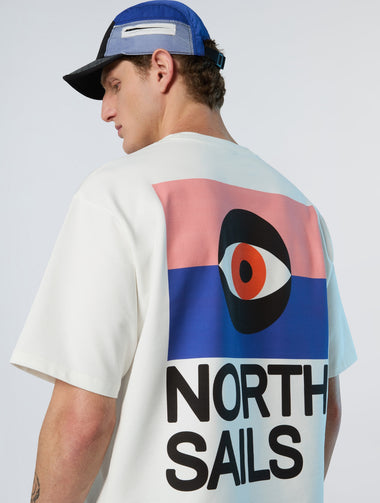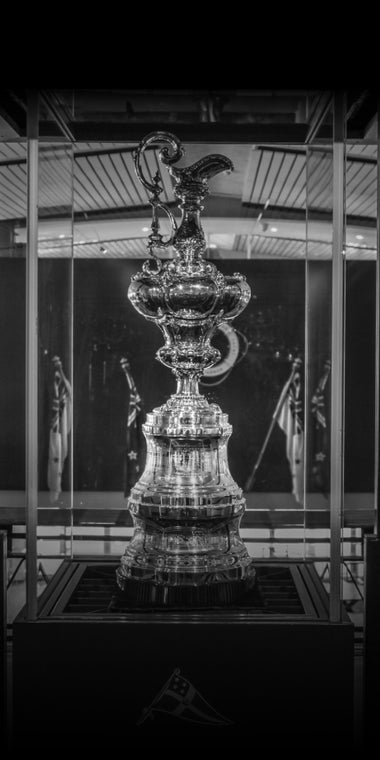NORTH SAILS BLOG
All
Events
Guides
News
People
Podcast
Sustainability
Tech & Innovation
Travel & Adventure
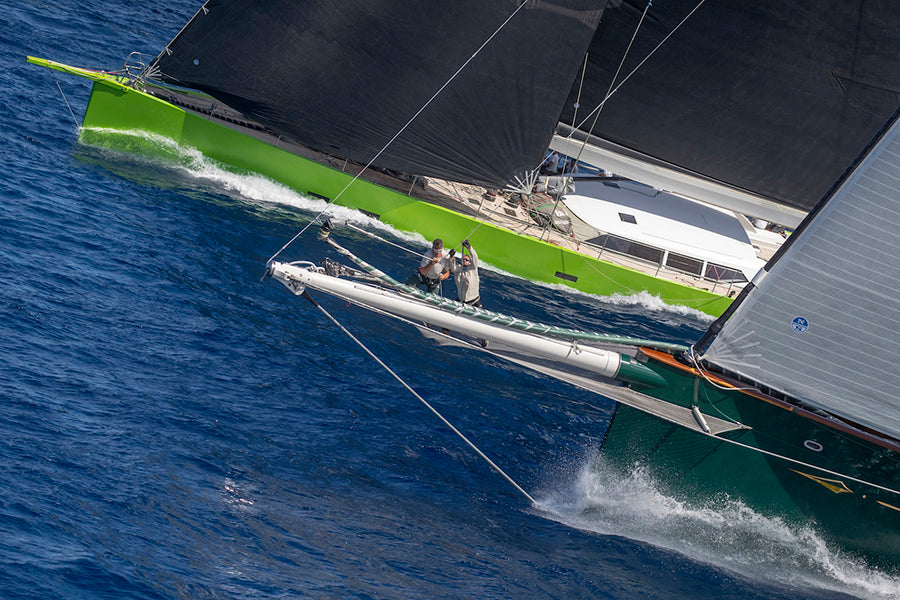
CAMPEONES NORTH SAILS EN ST. BARTHS
CAMPEONES NORTH SAILS EN ST. BARTHS
La clasificación final de la St. Barths Bucket 2019 dejó muy buenas noticias para los clientes North Sails.
📸 Studio Borlenghi
El vencedor absoluto fue el barco más grande de esta edición, el colosal Hetairos, ganador además de Clase A, también denominada Les Gazelles des Mer. El Baltic de 218 pies de eslora sumó un primero, un segundo y un tercero en las mangas disputadas, empatando a puntos con el Baltic 108 WinWin diseñado por el español Javier Jáudenes; tercero finalizó el Baltic 130 My Song, tercero. También confiaron en North Sails los tres primeros clasificados de Clase B (Les Mademoiselles del Mers): el Farr de 35 metros Sojana, el Dubois 382 Farfalla y el MM330 Missy.
¡Felicidades y gracias a todos por confiar en North Sails!
READ MORE
READ MORE
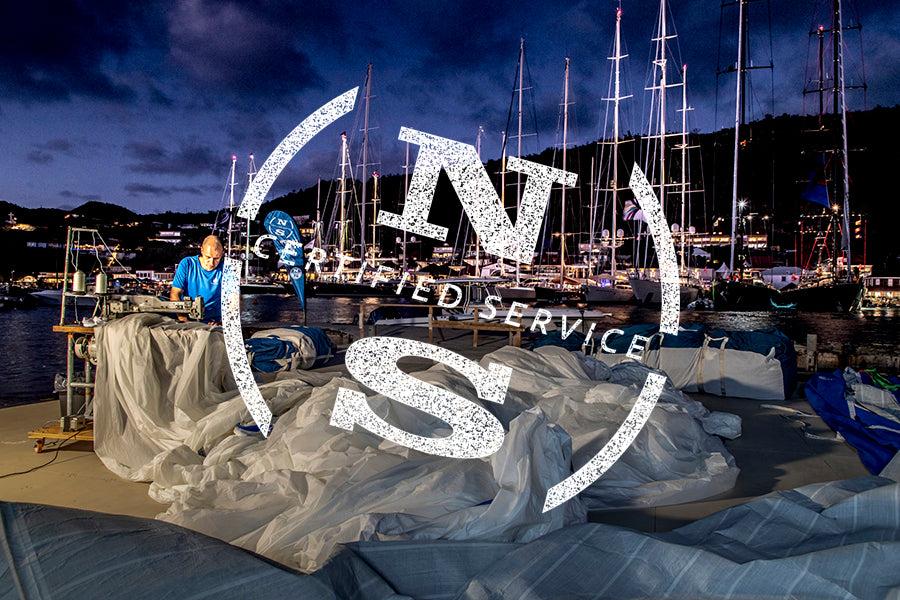
SERVICIO A DOMICILIO PARA SUPERYATES
SERVICIO A DOMICILIO PARA SUPERYATES
Además de diseñar, fabricar y comercializar las mejores velas del mundo, North Sails ofrece un servicio itinerante de velería en eventos donde la logística puede suponer una complicación para sus clientes.
📸 Studio Borlenghi
Además de diseñar, fabricar y comercializar las mejores velas del mundo, North Sails ofrece un servicio itinerante de velería en eventos donde la logística puede suponer una complicación para sus clientes. Es el caso de la recién celebrada St. Barths Bucket 2019, donde los 34 superyates participantes pudieron competir con la tranquilidad de disponer de un equipo de veleros North Sails en tierra para resolver cualquier incidencia durante la competición.
Dentro del calendario anual de competición de superyates, la St. Barths Bucket es considerada la regata de referencia en formato no profesional. Los armadores pueden compartir su pasión con amigos a bordo de sus embarcaciones y contar con un timonel de America’s Cup o un campeón olímpico navegando su barco, algo así como lanzarse a un circuito con tu coche conducido por Fernando Alonso. Es también una ocasión excepcional para comprobar el verdadero potencial de sus embarcaciones a manos de expertos capaces de explorar sus prestaciones.
Tanto el puerto como los alrededores de la isla de St. Barths (San Bartolomé, territorio francés en el extremo oriental del Caribe) son ideales para acoger una regata de superyates de este calibre, pero no siempre es fácil encontrar solución a reparaciones de velas de semejantes dimensiones. Este año participaron 34 barcos con esloras comprendidas entre los 31 metros del Swan Varsovie y los 67 metros del Baltic Hetairos. Basta revisar las medidas del coloso verde, con 62,5 metros de altura de mástil, para comprender las proporciones de sus velas.
Servicio North Sails
Un año más, North Sails desplazó a St. Barths el equipo material y humano para brindar un completo servicio de velería a pie de pantalán, algo muy valorado por los participantes.
“Antes, el velero local se traía su máquina de coser al pantalán y gente como yo se pasaba la noche reparando velas, pero desde que decidimos instalar el servicio, con todo en un mismo sitio y bien organizado, hemos facilitado mucho la vida de armadores y capitanes de los barcos”, explica el experto en superyates de North Sails Quinny Houry, que se desplazó desde su base de Palma para competir a bordo del MM330 Missy.
El servicio itinerante North Sails incluye un equipo formado por entre tres y cinco veleros, en función de las características del evento, y supone un considerable esfuerzo logístico que incluye el transporte de la maquinaria y los materiales necesarios para trabajar en velas de varios cientos de kilos de peso cuya superficie se cuenta en ocasiones por miles de metros cuadrados. Para la St. Barths Bucket todo viajó desde las instalaciones de North Sails en Palma, las mayores del mundo especializadas en superyates. Localmente se alquilan elementos como carpas, suelo y cualquier otro accesorio complementario.
“En los días previos al inicio de la competición realizamos modificaciones y mejoras en las velas, pero una vez que empieza la regata lo más habitual son reparaciones de spinnakers”, explica Ben Fletcher, director de servicio North Sails. “La carga de trabajo depende mucho de las condiciones meteorológicas, por lo que en algunas regatas estamos a tope, con 20 velas al día o más, mientras en otras damos servicio a 20 durante todo el evento. En la St. Barths Bucket 2018 realizamos 21 reparaciones, y este año terminamos la operación con un número similar”.
Este servicio itinerante supone un considerable esfuerzo impensable sin el apoyo de una gran organización, como recuerda Quinny:
“Una de las ventajas de North Sails es que es lo suficientemente grande que disponemos de los recursos necesarios para trasladar a la isla un servicio itinerante sólo para este evento. Si imaginas la logística necesaria para trasladar unas instalaciones capaces de gestionar velas de más de 200 kilos de peso, no es fácil. North Sails es la única firma con la capacidad de hacerlo, y estamos muy orgullosos de poder ofrecérselo a nuestros clientes”.
Además de en la St. Barths Bucket, North Sails proporciona el servicio itinerante en la Loro Piana y la Maxi Yacht Rolex Cup de Porto Cervo (en la isla italiana de Cerdeña) y Les Voiles de Saint Tropez (Francia). Para la Sail Racing PalmaVela y la Superyacht Cup de Palma se ofrece un servicio similar pero aprovechando la infraestructura de las dos velerías de North Sails en la isla.
READ MORE
READ MORE

GENNAKER LAUNCHING BAG INSTALLATION GUIDE
GENNAKER LAUNCHING BAG
Installation Guide
Most of the really memorable spinnaker mishaps can be avoided if the sail is equipped with a dousing sleeve. Inside the sleeve, the sail is protected from most snags. When the sleeve is hoisted there is no pressure on the sail, so the crew can take their time and make sure everything is sorted out before raising the sleeve. However, the sleeve and retrieval line add another layer of complexity and potential for tangles. That’s why, except on very large boats that are equipped with purpose-made spinnaker launching bins, we recommend storing your cruising spinnaker and sleeve in a racing “box turtle” bag or zipper “sausage” bag. For trouble-free launching and retrieval, follow the steps below.
Step 1
In a sail loft or on a clean dry lawn, tie the head of the sail to a tree or post. With a helper holding the tack, run the sleeve up and down to remove any twists.
Step 2
Pull the sleeve all the way down. If the sleeve fits the sail correctly, the cone will come within a foot of the clew, but will not go past the clew. Next, attach the clew and tack to opposite ends of the bag with the Velcro web straps. Stuff the loose foot fabric into the bag and place the cone in the center of the bag opening, on top of foot material, clew, and tack.
Step 3
Coil the retrieval line loosely and shove it up into the outer sleeve, so the line disappears above and outside the cone. This will keep the retrieval line from getting tangled and will prevent you from inadvertently rigging the tack line, halyard or sheets through the loop. (When you hoist the sleeve to the top of the mast, the retrieval line may fall to the deck on its own; if not, reach in and pull it out.)
Step 4
Flake the sleeve into the bag, forcing each flake deep into the corners. Pass the center Velcro webbing through the head ring and close the bag. Now the sail can be hooked up to the tack line, halyard, and sheets. You will hoist right out of the bag.
If the cone is allowed to run freely up the luff as the sail fills, it is possible for the cone to run fast enough that it creates a fair amount of friction. This could cause enough heat to melt the fabric over large areas of the sail. The friction of the retrieval line running through the palm of your hands can also cause enough friction to melt human skin. The skin repair is free (except in extreme cases), but the cost of replacing the melted spinnaker fabric can be pretty high. Before raising the cone, control deployment speed by wrapping the retrieval line around a deck fitting or winch.
READ MORE
READ MORE
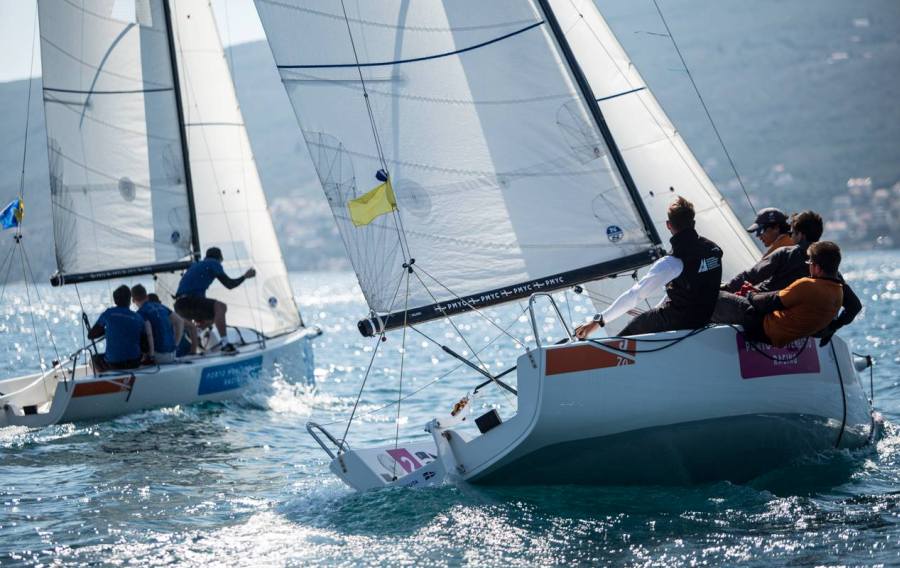
EUROPEAN MATCH RACE TOUR - STOP TIVAT
European Match Race Tour - stop Tivat
foto: Elena Shu - Porto Montenegro Yacht Club
Druga regata European Match Race Toura za 2019. je odjedrena u Tivtu, domaćini su bili članovi Porto Montenegro Yacht Cluba, a Hrvatski predstavnici su bili ponovno članovi Wave Sailing Centera.
Konkurencija je bila iznimno jaka jer je regata imala kategoriju Grade 2, što bi u prijevodu značilo da donosi hrpu bodova za WS MR ljestvicu. Regata je imala i simboličan novčani fond nagrada, za pobjedu se dodijelilo 400€, za drugo mjesto 300€ i za treće 200€.
U Tivat je stiglo deset kormilara među kojima je bilo onih koji pripadaju samom vrhu dvobojskog jedrenja. Najbolje plasirani među njima su bili Ettore Botticini (ITA) - 4. na rang ljestvici, Mati Sepp (EST) - 6. na ljestvici, Dejan Presen (SLO) - 14. na ljestvici, Szymon Szymik (POL) - 21. na ljestvici...
Među njima su zajedrili i mladi šibenčani s Markom Smolićem za kormilom koji trenutno zauzima 189. mjesto na svjetskoj rang ljestvici.
S obzirom na broj posada program je bio vrlo opsežan, čak 45 matcheva se trebalo odjedriti da se završi kompletan Round Robin i da bi se dobili parovi koji su konačni plasman tražili u King of the Castle, polufinalu i kasnije u finalu.
Što se dešavalo na moru ispričao nam je jedan Denis Marinov, koji je zajedno s Nevenom Baranom direktnim suđenjem na moru presuđivao sporne situacije:
Vrijeme nas je izvrsno poslužilo i napravili smo cijeli program. U petak je puhalo s jugozapoada između 5 i 9 čvorova, dok je u subotu i nedjelju dominirao maestral koji je u dizao i do 20 čvorova. Jedrilo se s tri para jedrilica klase J70, a konkurencija je bila iznimno jaka! Naša posada je bila jedina ispod 100. mjesta na svjetskoj rang ljestvici.
Denis Marinov, jedriličarski sudac
Smolić i društvo prvog dana regate se nisu najbolje snašli. Lako su dobivali penale i u petak gube tri dvoboja (matcha) te dan završavaju bez bodova. U subotu su se malo trgnuli i pobijedili su u tri nova dvoboja i u jednako toliko izgubili, pa im je konačni postotak bio 33%. Posljedica je da su Round Robina završili na 8. mjestu.
Imali su jednak postotak kao Danska posada Emila Kjaera, kojeg su dobro upoznali na match race regatama u Šibeniku ove i prošle godine, ali su danci pobijedili u međusobnom dvoboju pa su na idući stupanj natjecanja išli sa 7. mjesta.
Kao jedna svijetla točka tog dijela regate je bila to što je iza njih završila posada Szymona Szymika koja je imala samo jednu pobjedu, odnosno osvojila je 11% dvoboja i slovenci s Bojanom Rajarom koji su iz kvalifikacijskog ciklusa izašli bez pobjede.
S obzirom na nizak plasman u kvalifikacijama naši su u nedjelju mogli jedriti samo u King of the Castle. Tu su imali šansu izboriti se do dosta dobrog 5. mjesta u generalnom plasmanu.
Tko je koga pobijedio u ciklusu svakog protiv svakog možete vidjeti na ovom linku.
Princip napredovanja s nižih startnih pozicija je bio da su prvi dvoboj jedrili 9. i 10. nakon Round Robina. Tu je pobjedu odnijela poljska posada i u idućem matchu su ih dočekali Smolićevi momci koji (osmi nakon Round Robina). Naši su izvrsno otvorili match i vodili su cijelu regatu, da bi šansu za napad na 7. mjesto izgubili u doslovno posljednjem metru plova.
Slijedeća stepenica koju su trebali prijeći Poljaci bila je s posadom Emila Kjaera. Izgleda da je nedjelja bila dan danske posade jer su glatko pobijedili poljake, kao što su napravili i u svoja iduća dva matcha te regatu završavaju na 5. mjestu.
Vodeća četvorka je imala klasičniji program. U polufinalu je najbolja posada iz Round Robina, Francuzi s Jean-Baptiste Bernazom izabrala svoje protivnike i tako definirala i drugi polufinalni plov. Bernaz i Botticin pobjeđuju u oba polufinalna plova te su se sastali u finalu, dok su u malom finalu jedrila talijanska posada s Roccom Attilijem na kormilu i miješani slovensko-hrvatski sastav koji je okupio Dejan Presen.
Konačni rezultat i poredak nakon regate možete pronaći na ovom linku.
READ MORE
READ MORE
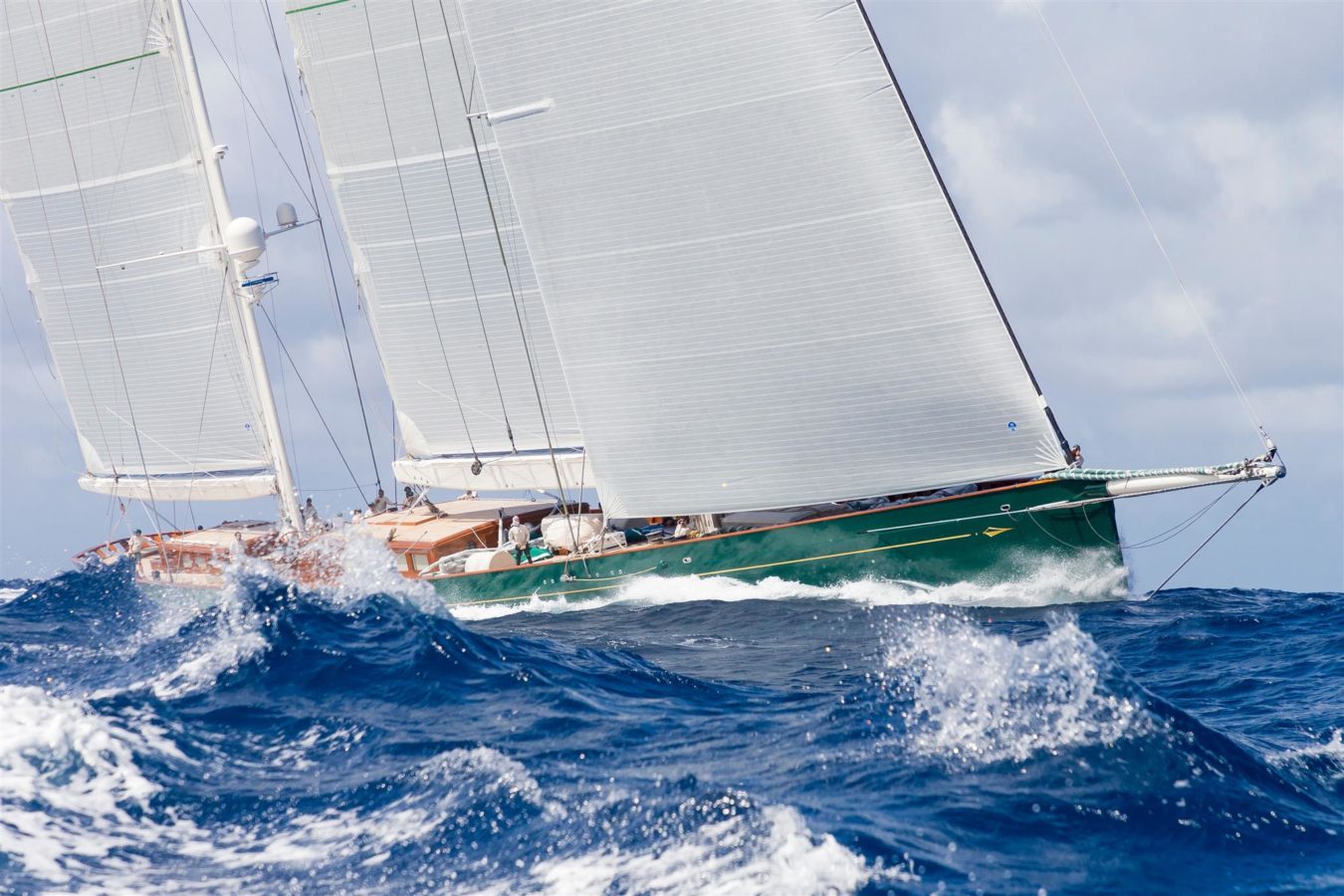
SUPERYACHTS FIND SUCCESS IN ST BARTHS
NORTH SAILS POWER HETAIROS TO OVERALL VICTORY IN ST BARTHS
Three Days of Racing Delivers Scoreboard Success
North Clients on Hetairos, the 67m Dykstra R/P, had a great regatta. Congratulations to the crew for a job well done, winning overall in Class A, just ahead of WinWin and My Song. 📸 Carlo Borlenghi / Borlenghi Studios
Winning North inventories filled in 12 of 18 podium positions, including the overall winner of the St Barths Bucket. Thirty-four yachts and 1500 sailors competed in the 2019 edition of the Bucket, an event known for its competitive, but Corinthian spirit.
Hetairos, the 67m Dykstra R/P bested her fleet and was also crowned 2019 overall champion. With three races in three days, North Sails clients found success across multiple classes. In addition to Hetairos, North sails outfitted Class B winner Sojana as well as crowding the podium across Class C, Class D, Class E and the dedicated Corinthian, non-spinnaker Class F.
Each year since 1995, St Barths plays host to the by-invitation superyacht regatta. This event is an opportunity for boat owners, their friends and a collection of highly accomplished sailors to enjoy this annual tradition. For this edition of the race, North Sails worked with world-renowned sailing photographer Carlo Borlenghi to capture sailing during the day and our pop-up service loft at night. Below is a selection of our favorite imagery from St Barths, which captures the spirit for this truly unique, Corinthian superyacht regatta.
📸 Carlo Borlenghi / Borlenghi Studios
📸 Carlo Borlenghi / Borlenghi Studios
📸 Carlo Borlenghi / Borlenghi Studios
📸 Carlo Borlenghi / Borlenghi Studios
📸 Carlo Borlenghi / Borlenghi Studios
📸 Carlo Borlenghi / Borlenghi Studios
📸 Carlo Borlenghi / Borlenghi Studios
📸 Carlo Borlenghi / Borlenghi Studios
READ MORE
READ MORE
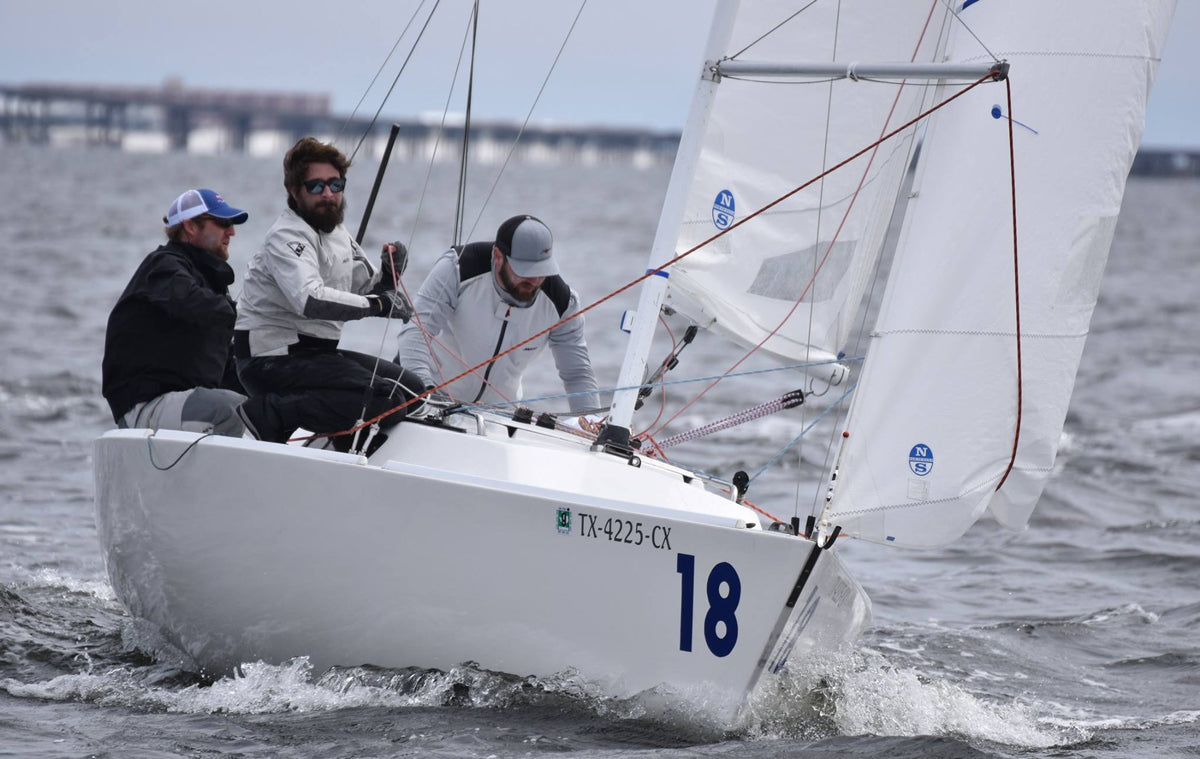
MAKING THE SWITCH
MAKING THE SWITCH
New J/22 Client Casey Lambert Explains What Made The Difference
Casey Lambert’s Blackburn Marine Racing, 3rd place at 2019 J/22 Midwinters. ©Chris Howell
One Design expert Mike Marshall interviews Casey Lambert after the J/22 Midwinters in Florida earlier this month. Casey recently switched to North Sails, and his 3rd place performance at the Midwinters caught Mike’s attention. Learn more from Mike’s Q & A.
Casey, you recently switched to North Sails and finished 3rd at the J/22 Midwinters. How did you go about setting the rig up for the new sails? What tuning tips would you have for others switching? What did you use for your base setting?
We initially used the North Sails J/22 Tuning Guide. The guide recommended starting with 26 on the uppers and 7 on the lowers. With this setting, we saw no sag, so the lowers were eased until we could see 1/2″ of sag. As a final result, we had 26 on the uppers with no reading on the lowers, 4-5 inches side-to-side measured at the dock. For any one switching to North Sails, I would start with the tuning guide to get a solid starting point, but don’t be afraid to make changes as all boats are a little bit different.
If you had to sum up the key characteristics of the sails when you thought you were going fast, what would they be?
I always try to keep the flow in the main even with tell tales flowing at all times. With that being said, I found the traveler had a lot more to offer than with my last sails. The jib was a bit more work, but by the end of the regatta we found that moving the car back and tightening the luff (no scallops) gave us the best performance with the conditions given.
©Chris Howell
You mentioned that you changed your forestay length for the North sails. What made you make that change and how much did you changed it? What is the length now?
After speaking with you we started at 4′ 11-3/4″. After sailing the boat twice in 0 to 5 knots with no other boats, we made some adjustments to give me a little bit of leeward helm. After sailing the boat in the practice race with a little more breeze I knew we had a problem. The boat had a huge weather helm forcing me to use the rudder like an emergency brake to keep the boat from rounding up. After discussion with Evan and Jesse we decided to take 5 turns out of the head stay (not a minor adjustment). We went into day one ready to make changes but we had speed and point, so we ran with it. We have not made a new measurement since the last changes.
After using the sails for four days now, what are the main differences that you have seen in the way that you trim the sails from your previous set? Mainsheet, backstay, jib car?
Mainsail – In the past, unless I had a crew sitting in, the traveler never left center. I found that I set the mainsheet and played traveler in all breeze allowing the headstay to stay firm and not bounce around.
Jib – The jib really likes the car back and a tight luff which we always kept some scallops in the past.
Clearly, you are very fast in the J/22, so as for the boat in general, what are the tips you would give other class members that were key to your success so far this season?
Jesse, Evan and myself have been sailing together for 15 plus years on many different boats. Our communication with each other is great! Over the years, we have traded spots on the J/22 which helps in changing gears. I trust them and they trust me.
Never settle for the way your boat is set up. Don’t be afraid to make changes… you will never know if you don’t try.
We never give up until the finish horn. When I find myself in the back I try to win my side of the race course. In large fleets one shift can send you from 20th to 1st in a matter of seconds.
At the 2019 J/22 Midwinters, North Sails designs were used by nine out of the top ten teams, including winners, Mike Marshall’s Bad News, Jeff Todd’s Hot Toddy in second and Casey Lambert’s Blackburn Marine finishing 3rd. Big congrats to Casey on his improvement!
Have questions about sails? Need expert advice? Contact Mike today.
©Chris Howell
READ MORE
READ MORE
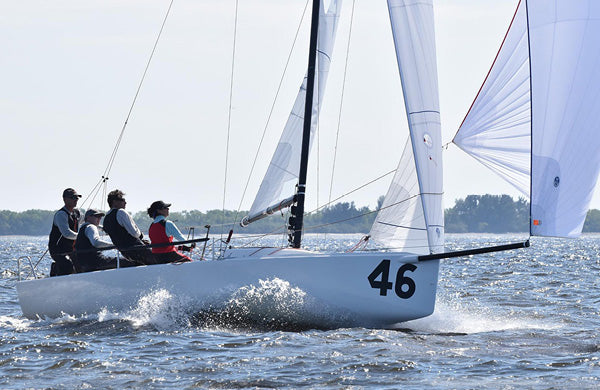
SPEED READING: MANAGING YOUR RISKS
SPEED READING: MANAGING YOUR RISKS
Maximizing Your Chances To Make Gains
Zeke Horowitz, skipper of J/22 Uncle Fluffy, 2019 World Champions. © Chris Howell
J/22 World Champion and North Sails Expert Zeke Horowitz explains how you can maximize your chances to gain through smart boat positioning on the racecourse. Sailboat racing is all about controlling what we can—boat speed, boat handling, preparation, and decision-making. But we can’t control everything. So we need to think about ways to manage risk so we can rely on good speed and conservative tactics. In this article, we’ll review strategies you can apply to your position decisions to ensure your boat is in the right place to make gains while avoiding big losses.
Pre Start: “It’s all about the homework”
Get out early to sail most of the first beat and figure out if there are any trends in terms of where the velocity is, how often the wind is shifting, current differences, wave differences, etc. Take note of the range of compass numbers on both tacks so you’ll know right away if you’re lifted or headed. Then, check the starting line. Is there a line sight? Is there a favored end based on compass bearings compared to wind direction?
Now you can relate this info to what you learned sailing upwind and decide on an overall strategy. Is there a persistent shift? Is there a side to race to based on current? Is it oscillating? With all of this info, decide which area of the line to start so you can be ready to make gains right off the line.
If there is a favored end of the line or side of the racecourse, it’s important to start near that end. But if the wind is oscillating, start in an area so you can sail on the lifted tack off the start, regardless of the favored end. If you know the wind is oscillating and in a left phase during the start sequence, the pin will be favored. But since the next shift will be a right phase, it’s probably better to start near the middle or even boat end, because you will have an easier time tacking right away to get on the port lift, and you’ll be closer to the next shift than most competitors. Maybe a few boats that make a risky start at the pin look advantaged early, but you are on the lift, in less traffic and headed towards the next shift, which will be a righty. Now you’re in a position to gain right away.
Starting in Oscillating Breeze: Pre-race homework says wind is oscillating and the pin end is favored. Boat at the pin is upwind at the start, but can’t tack onto the lift right away because of traffic. Boat at unfavored weather end tacks onto the lift and then immediately after the start on the first shift, and gains the lead.
Beats to Windward: “Game of Thirds”
I like to divvy up the beat into thirds. At the bottom of the beat, it’s all about positioning yourself so you can execute the game plan. If you’re in bad air, you need to decide if tacking for a clear lane is the move or if it’s better to suffer for a while in bad air to get going the direction you want. If there aren’t many shifts, or there isn’t a particular favored side, then lane management is everything and you should not sail for a moment in bad air if you can help it. But if you know you need to get to one side, you may have to sail in bad air to get over to that side at the bottom of the beat.
If the wind is oscillating, you may have to come to terms with the fact that you won’t have much clear air on this beat, because sailing on the lift towards the mark is more important than sailing in clean air. If you know you’re on a lift, duck a boat coming across on the header instead of tacking on its lee bow, even if it’s a big duck. Keep going the right way, staying in position to gain at the next cross.
For the second third of the beat, start looking for opportunities to consolidate. You’ll have an idea of where you stand, and you need to weigh your options for staying ahead of the boats behind you while looking for the opportunity to jump the pack just in front. If you can take separate a bit from any pack of boats, you’ll be able to sail faster. So look for a good opportunity to separate into clear water and avoid being the boat going slow in the middle of the pack.
Most importantly, look up the course past the laylines and start developing a strategy for the top of the beat. If you want to get to a certain side for the last portion of the beat, be disciplined about lee-bowing packs or taking smart ducks to ensure you’ll be one of the first to get out there. Also, look for opportunities to consolidate any gains you’ve already made on packs so you can put them in the bank.
As you near the top of the beat (the final third), think about what the last shift or pressure advantage will be. Often, you can make gains getting to the edges at the top, avoiding the cluster in the middle. As the fleet gathers under the top mark, the wind velocity dies there under “the blob.” Be a little more on an edge, and you’ll have an opportunity to gain. If you’re not in the lead pack, think about the boats that will round ahead and try to avoid that traffic. If possible, also try to avoid getting to a layline too early; if the wind shifts, you won’t make any gains.
Finally, as you approach the weather mark, start developing a downwind strategy. Will there be a long jibe? Is there a pressure or current advantage? Are you rounding in a shift that will dictate the favored jibe right away? Being decisive here can help you jump that pack just in front of you!
Best Pressure/Shift at the Top Mark: Port approach is often clearer but more risky. Watch for traffic and boats rounding the windward mark ahead. Look for an edge with more wind or last favorable shift.
Runs to Leeward: “The Train and Making Gains”
The top third of the run is all about escaping from the top mark. If it’s the first weather mark, the traffic of boats still going upwind and the “blob” representing the mass of the fleet as a whole make the area directly under the mark a no-go zone. Unless you see a massive right shift or you know the run is going to be all port jibe, do a bear-away set. Jibing early at the first top mark can be tragic, and the smart money calls for a regular bear-away set on starboard.
Keeping that in mind, though, if you’re clued into the last shift or the position of the leeward mark and you know port jibe is going to be strong, then don’t hesitate; call the jibe set and jump the boats around you so you can be the first on the favored jibe heading down the course.
On the other hand, if you feel the left side of the course is favored and you want to stay on starboard, then commit early to the high lane around the weather mark so you don’t risk getting rolled and forced the wrong way.
Things usually settle in by the second third of the run and you can focus on speed and positioning. Manage your lane behind you to always have clear air, but when it is time to jibe, position yourself to make gains by sailing artificially low for a few moments, moving the trailing competition high of you. While it looks like they are creeping up to get on your breeze, you jibe into clearer air, setting yourself up for the last phase of the run.
The most important thing to decide in the last third of the run is where you want to be for the next beat. If you know you have to go to one side, then that dictates the gate mark you’ll round. If it’s not clear, then try to observe if there is a favored gate (one more upwind than the other), and if that isn’t clear either, decide if one gate will provide a cleaner escape—fewer boats coming down that side of the course giving you bad air as you turn upwind.
You also need to position yourself relative to the nearest boats so you can have a clean rounding. Try to get to the inside of any packs to get mark room. Or look for the chance to split from the pack or the boat rounding just in front of you so that you have less traffic and more clear air as you round. If you’re in a pack of four, and three boats are going to the same gate mark, it usually pays to go to the opposite gate with more speed and clearer air. Even if you want to go the other way, you can come around and tack fairly soon. Now you’ve avoided rounding in a pack and you’re still going the right way. Rather than being in a position where you’ll likely lose distance on that pack, you’re positioned to make another gain. Just make sure you’re not sailing straight into a blob of boats coming downwind with spinnakers!
The name of the game here is being able to decide when the opportunity is to “stay on the train” to avoid a loss and balancing that with positioning the boat on the train so that you’re more likely to gain than lose. Above all else, none of this will matter if you don’t take the time to develop good speed. Good luck this season!
Making Gains at the Gate: If you want to go to the right side, round that gate mark. If there is a pack of boats close ahead, round the other mark and then tack with clear air to gain on all but the leader.
READ MORE
READ MORE
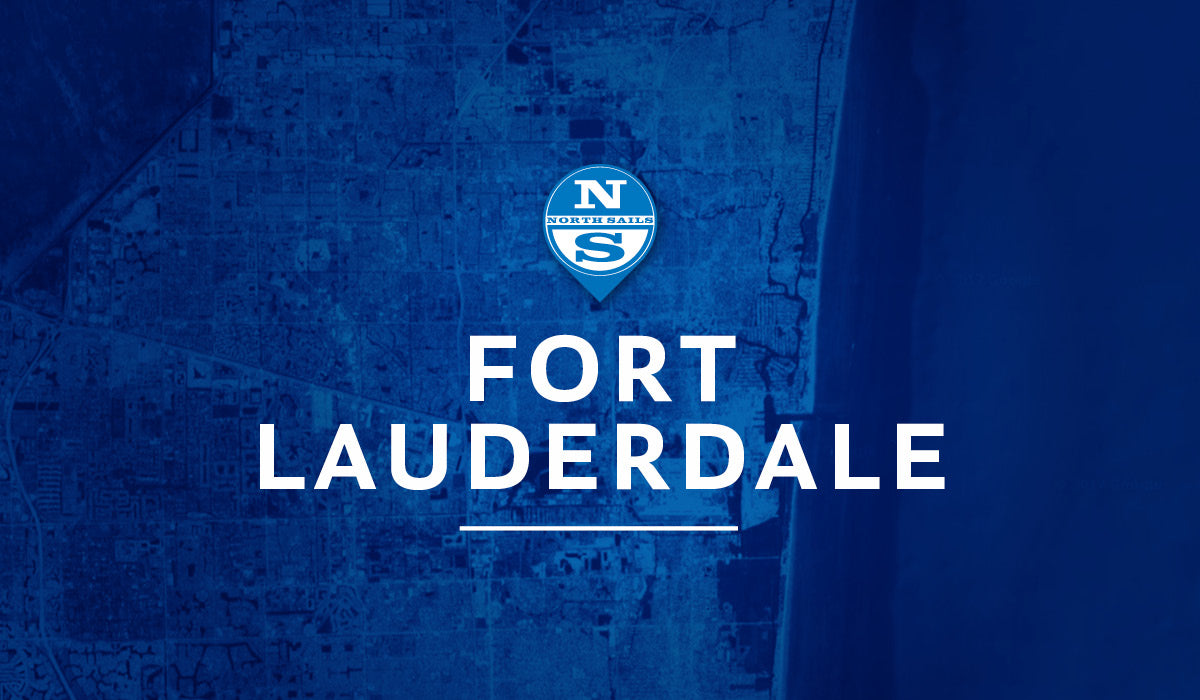
NORTH SAILS MERGES WITH DOYLE FORT LAUDERDALE
NORTH SAILS STRENGTHENS SOUTH FLORIDA PRESENCE
Combining World Class Customer Service & Products In The Southeast
The North Sails loft in Fort Lauderdale will merge with the former Doyle Sails East (Fort Lauderdale) loft to consolidate their expertise and personnel, giving sailors in South Florida access to unmatched service and product offering. Under the leadership of North Sails veteran Mike Toppa, the new combined team will be headed by Bob Meagher and Peter Grimm Jr, both hugely respected in the Southeast region.
Meagher, the previous owner of Doyle Fort Lauderdale, will take on the role of Site Manager for Fort Lauderdale and become the Southeast Regional Manager for North Sails. He will be supported by his longtime sales expert Peter Grimm Jr. Based out of the current North Sails loft in South Florida, they will now be able to tap into North’s patented in-house software programs and the full spectrum of world-leading products to ensure their customers get the most out of their boats and sails. Now integrated into North’s unrivaled global network, sailors in the region will also benefit from world-class service.
Commenting on the merger, longtime North Sails Florida leader Mike Toppa said: “As two management teams seeking to provide the best solutions possible to our customers, it made perfect sense to both parties to combine our efforts. I’ve always had a huge amount of respect for Bob and Peter and have complete trust having Bob in the operational leadership role. I am confident the new team will go from strength to strength as we build on each others’ knowledge, networks, and skills. Anyone with a boat in the region will undoubtedly reap the benefits and see the results.”
Bob Meagher has built a career helping people enjoy their boats. Two decades of sail consulting have led him to become one of America’s most experienced sail experts, especially in the growing market of cruising multihulls. He has a vast knowledge of sailcloth and sail handling systems across a wide variety of boats, providing captains and project managers with a clear understanding of the sail options available to these unique boats. His twenty years of business experience with fellow sailmakers around the country gives Bob deep understanding of the sailing industry in the Southeast U.S. and the industry trends shaping sailing throughout North America.
"I am confident the new team will go from strength to strength as we build on each others’ knowledge, networks, and skills. Anyone with a boat in the region will undoubtedly reap the benefits and see the results.”
Commenting on the merger, Bob concluded “For a long time I have felt we can give sailors better products, better service, and better solutions if we combined forces with North Sails. Once we decided we could make it happen, it has been a very positive experience and I am excited about the future, not only for our staff but for our customers.”
More than five decades of sailing and 100,000 sea miles give Peter Grimm the ability to help clients get the most out of their boat and sails. His long familiarity with owners, boat builders, spar builders, yacht designers, project managers, and captains of all experience make Peter a resource to educate clients not just about sails, but all the components needed to improve their performance and enjoyment, and his wins in races such as Montego Bay, Key West, St Barths Bucket, and the Palma Super Yacht Cup demonstrate his success. Peter's career has stayed on the cusp of the ever-growing superyacht market, from the largest 80 footers in the 80’s, to the 200 footers in the 2000’s. Constantly on the forefront of what is new, he is a regular fixture in superyacht yards and marinas of South Florida, and wherever these unique vessels gather.
Commenting on the merger, Peter explained: “Throughout my career, I have competed with North Sails on and off the water through a highly personalized, hands-on approach to help clients who race or cruise around the bay or around the world. The unique North Sails products add a new dimension to my tool kit. The unrivaled level of knowledge and client support within North Sails is an advantage I’m looking forward to bring to my Superyacht clients.”
To learn more about the new Fort Lauderdale loft and team, please contact us at 954-522-8840
READ MORE
READ MORE
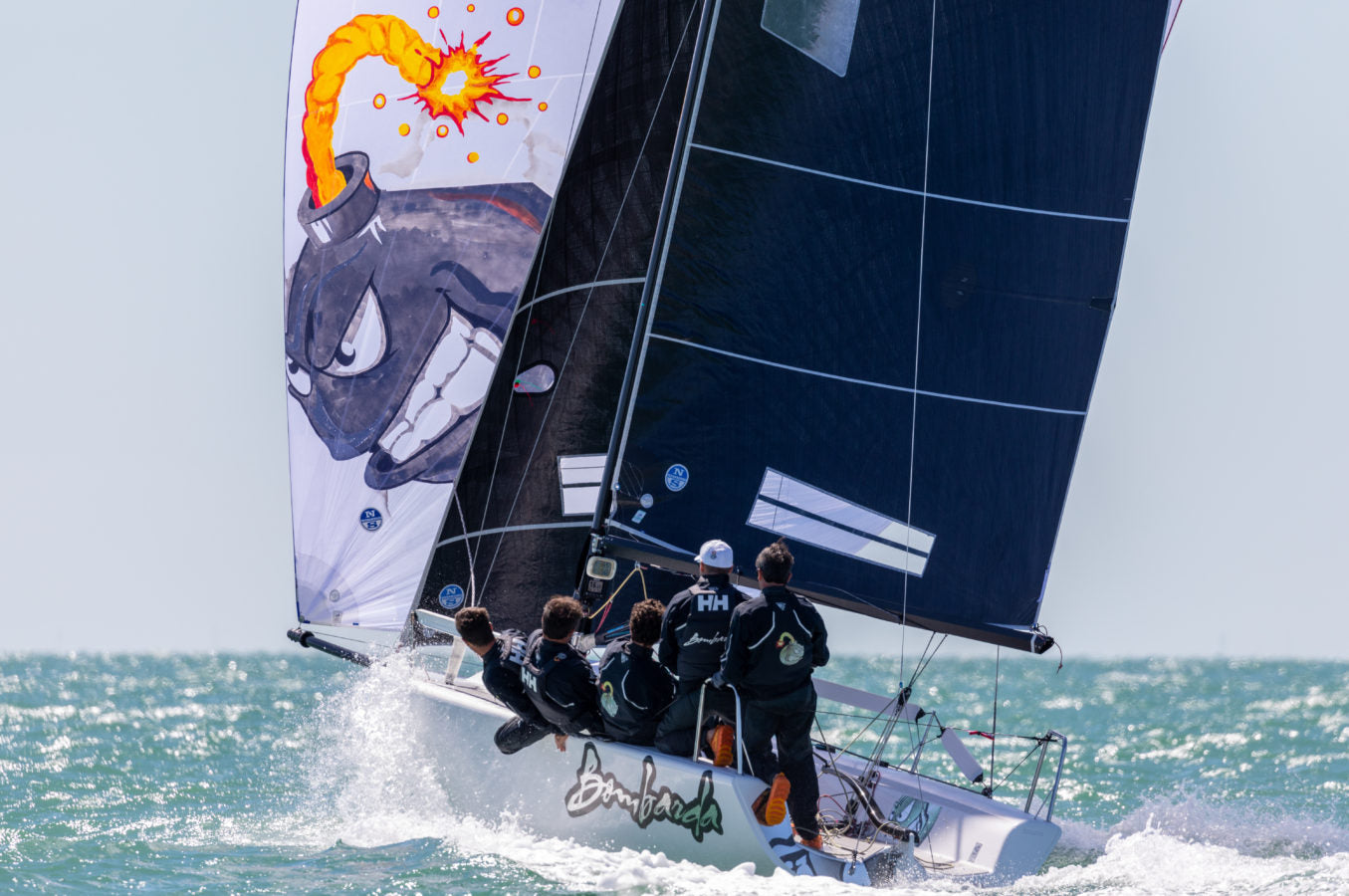
BOMBARDA WINS THE BACARDI CUP
BOMBARDA WINS THE BACARDI CUP
Expertise And Design Provide The Perfect Platform For Success
Andrea Pozzi's Bombarda, First Place Melges 24 Bacardi Cup 2019. © Mauro Melandri / Zerogradinord
With eight races and one discard, It all came down to the final race to determine the winner of the Melges 24 fleet and the 2019 Bacardi Cup, and it was going to be close. Andrea Pozzi’s Bombarda came out clean, one point ahead of the fleet after a consistent scoreline.
North Sails Expert, Giulio Desiderato is the coach for Melges 24 Bombarda, winner of the 2019 Bacardi Cup. Giulio campaigned with Bombarda for several years, and was tactician in 2017 when they held the number one spot on the class world rankings. He was also onboard when they took second place at the European Championship in 2016 held in Hyeres. This winter the Melges 24 specialist Matteo Ivaldi became the Tactician and he began coaching the team and has seen his teammate's performance progress as well as the North sail designs. Through practice and fine-tuning, the team is where they want to be and ready to take on the next challenge.
“As their coach, I’d like to say thank you to my team for such a great week. They sailed very well, and it’s been an honor to be by their side. Big congratulations to Andrea, Matteo, Ciampa, Carlo e Nicholas, they really have been the protagonists of this success.”
Sailors showed up ready to battle, and Miami served up pristine racing conditions that made it possible to get great races in the Melges 24 fleet. The level of competition remained high all week, and off the water, sailors enjoyed the camaraderie and making new connections.
Team Bombarda has worked hard in the lead up to the World Championships in Sardinia, Italy later this Spring. Beginning the season on a high note is not a bad start, but Giulio says there is still work to be done.
© Martina Orsini
“Our journey to the Worlds has just started, and we are happy about the results, but we know that we still have many things to improve. What’s been clear is the step forward that we have taken from the previous event we sailed in January. The biggest change that we’ve made was to our sail inventory, which has made a big impact on our performance.”
"Big congratulations to Andrea, Matteo, Ciampa, Carlo e Nicholas, they really have been the protagonists of this success.The biggest change that we’ve made was to our sail inventory, which has made a big impact on our performance.”
Since the very first day of training for team Bombarda, the team was fast and consistent. During the practice races before the regatta, they realized that they had all the ingredients to create the perfect, winning recipe that could get them a podium finish.
© Mauro Melandri / Zerogradinord
Andrea Pozzi, owner and skipper of Bombarda, commented;
“Sailing in the Melges 24 class is always a tough feat. I'm happy to be back in action with my team with the goal to prepare in the best way possible for the World Championship in Spain.”
“Winning the Bacardi Cup in Miami was a great experience. The venue is beautiful, and our results have given us even more motivation to improve. The relationship between Bombarda and North Sails is almost historical. We’ve been together in different campaigns over the course of several seasons. Especially with our win last week at the Bacardi Cup, I want to give thanks to North for the support and the services they have provided my team.”
“From the first moment we hoisted our new set of 3Di sails,” said Giulio, “we could easily adapt our old tuning to the new set up. Our goal was to be consistent, manage the risks, and try to stay in the front so we could avoid a large discard. We pulled it off!”
“Since the introduction of 3Di technology into the Melges 24 class two years ago North's designers Per Andersson and Mike Marshall have done a great job and made a ton of progress in class development”, said Giulio.
“Since the introduction of 3Di technology into the Melges 24 class two years ago North's designers Per Andersson and Mike Marshall have done a great job and made a ton of progress in class development”, said Giulio. The starting point of 3DL paneled sails was a benchmark in the Melges 24 fleet, but we now have advanced as far as delivering the best existing product into the class that has so far, made a huge difference in performance across the range for clients worldwide.”
“They’ve constantly been working on the shape and layout of the sails to improve the design since the very beginning. The starting point of 3DL paneled sails was a benchmark in the Melges 24 fleet, but we now have advanced as far as delivering the best existing product into the class that has so far, made a huge difference in performance across the range for clients worldwide.”
© Mauro Melandri / Zerogradinord
READ MORE
READ MORE
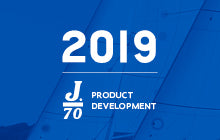
INTRODUCING THE NEW F-1 MAINSAIL FOR J/70 CLASS
NEW F-1 MAINSAIL FOR J/70 CLASS
Flexibility, Versatility, Balance, And Speed
The One Design team at North Sails are driven by our commitment to find solutions for our customers and to always find more speed and boat performance. This is why the new F-1 mainsail was tested and developed within the competitive J/70 Class and why it is now available to everyone. Developed to fit the Selden mast or a Southern Spars mast with a stiff set-up, the F-1 mainsail is a flatter design, balanced top to bottom to match mast bend in all conditions. Designed to be user-friendly, the F-1 is easy to trim, and tune, to produce maximum speed on the water.
“Development on the F-1 main started with sail testing sessions in the early spring of 2018, using the North Sails two boat testing telemetry system,” commented North designer Mike Marshall. “Using the results data and the power of the North Design Suite, were able to, in very few iterations, come up with a sail that much more effectively fits the Selden mast. An additional benefit is the vertical shaping in the sail is much more balanced to work well through the entire range of conditions.”
Commenting further on the development of the F-1 sail, North Sails One Design expert Max Skelley added “North Sails were invited to join Bruno Paquenelli’s Team Stampede to campaign for the 2018 J/70 Worlds in Marblehead. It quickly became apparent that the standard mainsail set up is quite different with the Selden mast. Primarily, in light air they were unable to flatten the main enough or get the draft far enough back to give the boat some helm; the shape looked full and draggy. We worked with Mike Marshall to flatten the vertical profile of the sail, and after several trials, we reduced the luff curve by enough to handle the very straight fore and aft mast set up the boat required in light air. The result: a very even sail shape was achieved, with resulting balance and speed.”
“Developed to fit the Selden mast or a Southern Spars mast with a stiff set-up, the new North Sails F-1 mainsail is a flatter design, balanced top to bottom that reacts to mast bend in all conditions. Designed to be user-friendly, the F-1 is easy to trim, and tune, to produce maximum speed on the water.”
At the J/70 Worlds, in a wide range of challenging conditions, Stampede’s upwind speed was outstanding and got the team top finishes, with equally strong results in 15+ knots of wind. As North One Design expert Eric Doyle noted “With the J/70 being so tender and light, we were able to flatten the main more than ever before, and this let us put the bow down and go fast when we needed to. The F-1 main allowed us great versatility in the big fleet. We could trim hard to point and hold our lane off the starting line without stalling the sail too much.”
“The F-1 proved it was ready for market after the 2018 J/70 Worlds,” explained Tim Healy, President of North Sails One Design. “The regatta was ultra-competitive, and the new F-1 finished an extremely close second place, just a single point away from winning it all. This battle-tested result was the conclusion to our sail testing.”
The F-1 mainsail is a new cross cut design featuring less camber when compared to the North XCS-2. Standard Features include one gaff batten, two full-length battens, two leech battens, vision and spreader windows, radial teardrop patches, spreader chafe patch, trim stripes, leech telltales, Class insignia, adjustable leech and foot cords, and roll bag. The F-1 sail is now available for any team competing at Charleston Race Week or for the summer season.
READ MORE
READ MORE

RBS SLICE BATTEN INSTALLATION GUIDE
RBS SLICE BATTEN
Installation Guide
North Sails RBS Splice Battens provide a convenient way to ship and stow 19mm and 25mm battens with lengths up to 7.4 meters. With proper installation, the RBS Splice battens will afford the same level of performance as standard battens, with minimal distortion to the sail.
NOTE: The splice connector is permanently attached to the front section of batten. DO NOT try to remove the connector from the front end.
Step 1
Lay out the battens with the labels facing up and the arrows pointing towards each other.
Step 2
Identify the front and back sections, making sure that the tapered end of the back section is aligned with the splice connector.
Step 3
With the arrows pointing toward one another, insert the tapered end of the back section into the splice connecter. Apply enough pressure to the back section to seat the batten completely in the connector.
Step 4
If the two sections are connected properly, the batten will be perfectly straight. If the batten is improperly assembled, the back section will be angled.
Step 5
Tape the junction of back section and connector.
To take battens apart, remove the tape and hold the back section of the splice connector. Flex the front end up and down, while exerting pressure in the opposite direction as the arrow.
For a short video demonstration, click here.
READ MORE
READ MORE

OPTIMISTI ULAZE U ZAVRŠNU FAZU KVALIFIKACIJA ZA REPREZENTACIJU
Optimisti ulaze u završnu fazu kvalifikacija za reprezentaciju
foto: Hrvoje Duvančić – www.regate.com.hr
Vikend 22 - 24. ožujka bio je rezerviran za održavanje posljednjih kvalifikacijskih regata za regije sjever i jug prije formiranja popisa sudionika kvalifikacijskih regata za formiranje reprezentativnih sastava Lijepe naše.
Kadeti sa sjevera su se okupili u Crikvenici, dok su južnjaci mjesto susreta imali u Makarskoj, a još jedna zajednička dodirna točka ove dvije regate je bila bezvjetrica.
Lijepi rano proljetni dani su rezultirali samo jednim odjedrenim plovom u Makarskoj i s dva u Crikvenici.
To ipak nije bilo dovoljno da bi konačni rezultati s tih regata bili valjani za uvrštavanje u odgovarajuće ljestvice. Klasičan uvjet valjanosti ovih regata je da se trebaju odjedriti minimalno tri plova. S obzirom da se to ovog vikenda nije uspjelo kvalifikacije koje su počele 1. rujna 2018. završile su nepotpunim programom.
Sjevernjaci su konačni poredak dobili nakon pet od predviđenih šest regata, dok su južnjaci imali još manje sreće s uvjetima na moru, pa su u konačnici sumu dobili s rezultatima četiri regularno odjedrene regate.
Regate koje su omogućile formiranje kvalifikacijske ljestvice regije Sjever su bile Rabačka, Kup Lošinja, ACI Kup, Sv.Nikola i Karnevalska regata. Ukupno je sudjelovalo 97 kadeta i kadetkinja iz Istre i Kvarnera.
Najbolje plasiran je Buba Pulek, član Uljanik plovidbe iz Pule. Ovaj petnaestgodišnjak je dominirao na kvalifikacijama i pobijedio u tri regate od četiri na kojima je sudjelovao i bodovna zaliha je bila više nego dovoljna da preskoči jedrenje u Opatiji.
Jednako uspješno je bilo još dvoje njegovih klupskih kolega, najbolja djevojčica na sjeveru je bila Lucija Škopac - 3. na kriteriju i Tol Tristan - 4. na kriteriju. Njih dvoje također je preskočilo Opatiju, a to je bio razlog zašto ih je Grigor Pettener s Malog Lošinja preskočio i kao najmlađi među prvih 14 na ljestvici zauzeo vrlo visoko drugo mjesto.
Da bi se kvalificirali na izbornu ljestvicu kadeti su se morali plasirati među najboljih 38 i to je pošlo za rukom predstavnicima čak deset klubova. Konačan raspored na ljestvici možete pronaći na ovom linku.
foto: Hrvoje Duvančić – www.regate.com.hr
Što se tiče južnog dijela hrvatske flote optimista kvalifikacije je odjedrilo 88 malenih dalmatinaca i dalmatinki, a 42 ih se plasiralo na izbornu ljestvicu.
Slično kao na sjeveru i ovdje je ovaj dio sezone prošao u znaku dominacije jednog imena. To je bila mlada Uskokova jedriličarka Noela Petešić. Ona će zapamtiti ove kvalifikacije po dvije pobjede i s jednom podjelom bodova s Petrom Marendić iz splitskog Mornara, koja u izborni dio ciklusa ulazi kao trećeplasirana na jugu.
Između njih, na drugom mjestu, je završio član JK Omiš, Josip Tafra. On je ujedno i najmlađi jedriličar među prvih osmero.
Bodovi su se skupljali na regatama u Dubrovniku, Primoštenu, na Hvaru i na Otvorenom prvenstvu Splita, a zbog orkanske bure nije odjedren Sv.Ivan u Omišu.
Točan poredak svih na ljestvici možete pronaći na ovom linku.
Osamdeset jedriličarki i jedriličara koji će se natjecati zajedno u nastavku sezone imaju dva okupljanja na sjeveru i dva na jugu. Riječ je o slijedećim regatama:
05 - 07. travnja, Memorijal Antolić Česić, JK Uljanik plovidba - Pula
12 - 14. travnja, Regata grada Poreča, JK Horizont - Poreč
03 - 05. svibnja, Split 1700, JK Split - Split
10 - 12. svibnja, Kup Vitrenjaka, JK Uskok - Zadar
Uz bodove koje će osvojiti na ove četiri regate u obzir će se uzimati i bodovi osvojeni na Prvenstvu Hrvatske, a konačan cilj svima je plasman u jedan od dva reprezentativna sastava. Prvih pet će se plasirati za jedrenje na Svjetskom prvenstvu koje će se od 6. do 16. srpnja jedriti na Antigui.
Slijedećih sedmero ide na Europsko prvenstvo koje se organizira u Crozon-Margatu u Francuskoj.
Jedino na što se treba pripaziti prilikom slaganja sastava reprezentacije je da ne smije biti više od četvero istog spola.
READ MORE
READ MORE
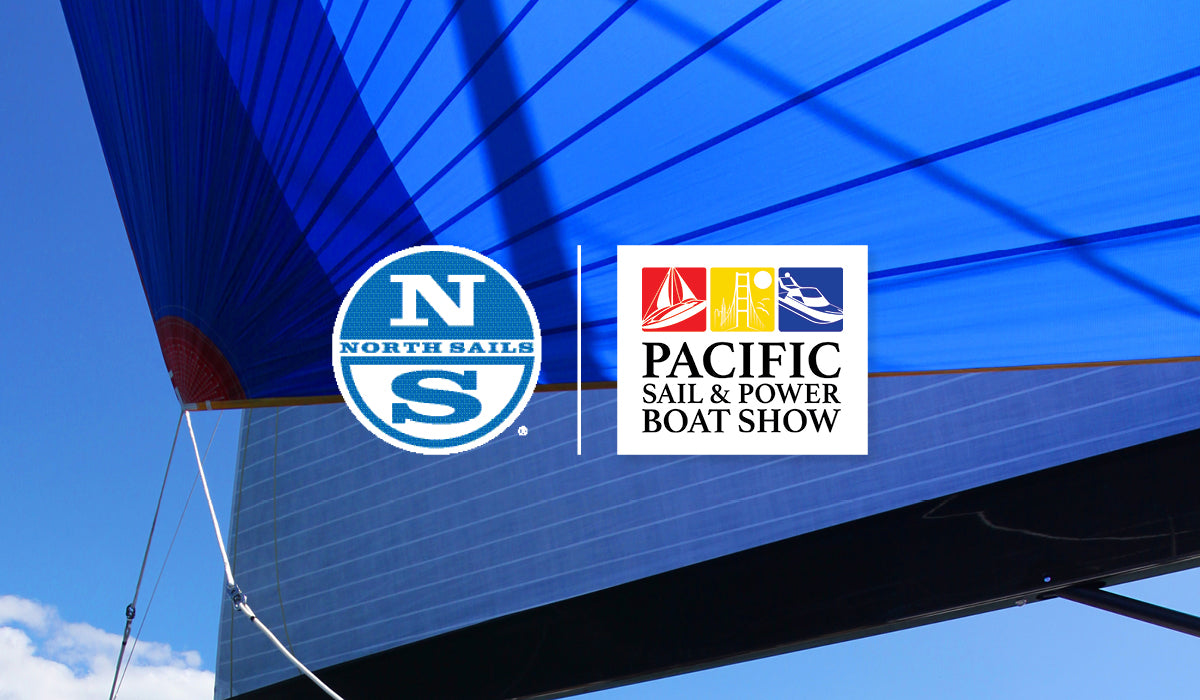
PACIFIC SAIL & POWER BOAT SHOW
TALK SAILS WITH YOUR LOCAL EXPERTS
Find Out About Helix, Talk Sail Care & Get Ready For The Season
READ MORE
READ MORE
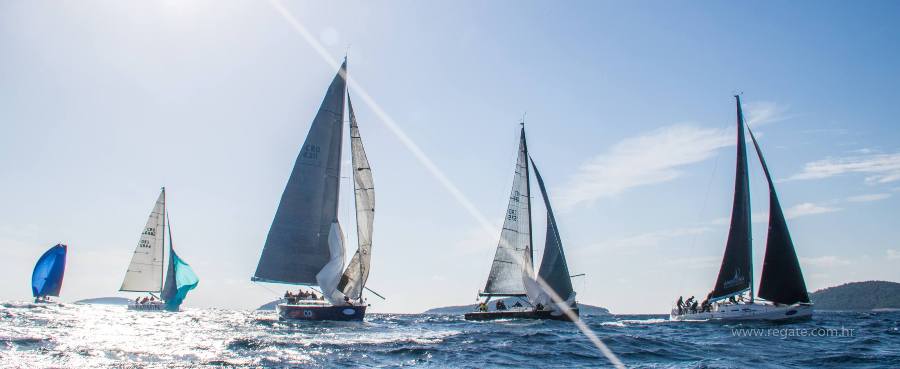
OGLAŠENA JE UVERTIRA ZA ORC SP U ŠIBENIKU
Oglašena je uvertira za ORC SP u Šibeniku
foto: Hrvoje Duvančić – www.regate.com.hr
U sklopu priprema za D-Marin ORC Svjetsko prvenstvo u 2019. organizatori iz Jedriličarskog kluba Val su odlučili regatu koju tradicionalno organiziraju početkom svibnja, a koja je i inače dio ciklusa regata koje se jedre za CRO ORC D-Marin Cup, podignuti na jedan viši nivo i iskoristiti je kao predigru i posljednji ozbiljni test pred SP.
Ove godine se odustalo od uobičajena dva dana i regata će imati tri natjecateljska dana.
Prijam jedrilica, okupljanje i prijave bit će organizirani u četvrtak 2. svibnja. Sutradan će natjecatelji koji možda stignu tijekom noći imati na raspolaganju još sat-dva vremena za prijave i pripreme, a na more će se izaći oko deset sati, da bi se stiglo na neko od regatnih polja na kojima će se jedriti SP četiri tjedna kasnije.
Regatni odbor će na raspolaganju imati mogućnost da kombinira s dvije zone. Jedna je s jugozapadne strane otoka Zlarina. U principu ista lokacija gdje se jedrila prva regata prošlogodišnjeg TP52 World Series. To je zona koja je poprilično otvorena i prostrana, a u slučaju juga i jačeg maestrala jedriličari mogu očekivati i malo veći val, dok je kurenat malo manje izražen nego u kanalima između otoka.
Druga zona koja je u kombinaciji je u Murterskom moru. Iako je dosta zatvorenija od ranije spomenute može se razviti poprilično jaka bura i maestral. Inače se u tom području jedrila Uskrsna regata dok se organizirala u Vodicama. U svakom slučaju nema problema po pitanju da li će biti dovoljno prostora za flote od 50-60 jedrilica.
Ostaje nam vidjeti da li će RO Šibenik ORC Cupa, a koji je dobio i prestižni aneks "Pre-Worlds", iskoristiti mogućnost kombiniranja održavanja ove regate na obja regatna polja, a treba napomenuti da su Valovci predvidjeli i mogućnost jedrenja jednog navigacijskog plova.
Inače se na regatama za CRO ORC Cup izbjegavalo jedriti navigacijska jedrenja. Ali u programu Svjetskog prvenstva su predviđena dva navigacijska jedrenja (čiji rezultati se ne mogu odbaciti), pa ako uvjeti na moru za vrijeme Pre-Worldsa ne budu odgovarali za postavljanje kvalitetnog štap polja, jedriličari ipak neće biti besposleni.
foto: Hrvoje Duvančić – www.regate.com.hr
Što se tiče broja sudionika očekuje se da bi ih moglo biti između 20 i 30. Od toga će većinu sudionika sigurno sačinjavati domaće posade koje su se prijavile za nastup na SP, a kojih je trenutno na prijavama čak 18. Također su neki sudionici iz daljih dijelova Europe najavili dopremanje svojih jedrilica što kopnom, što morem, te se očekuje da bi oni uz dio talijanske ORC flote koja je u velikom postotku u Jadranskom bazenu, mogli se odlučiti na testiranje Šibenskog akvatorija u uvjetima koji bi mogli biti čak i jednaki onima koji će vladati u prvom tjednu lipnja.
Svi zainteresirani Oglas regate mogu pronaći na web stranicama Jedriličarskog kluba Val.
READ MORE
READ MORE
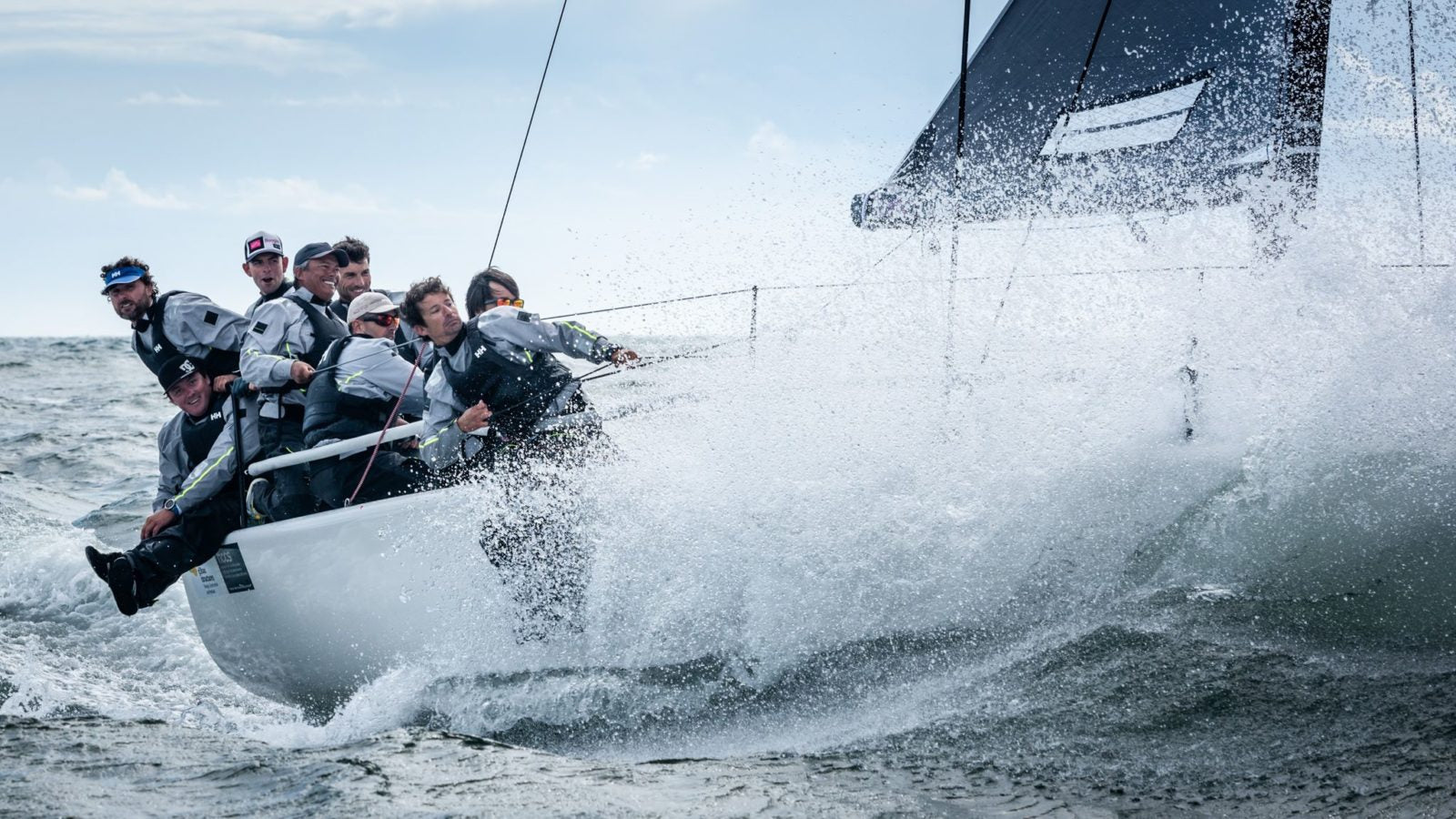
SUPER-CHARGED COMPETITION AND HIGH PERFORMANCE SAILING
SUPER-CHARGED COMPETITION & HIGH PERFORMANCE SAILING
North Sails Teams Up With Melges For The 2019 World League Season
📸 Melges World League / Mauro Melandri
The European Division of the Melges World League racing season commences on March 29th. In an event that was designed to super-charge competition in the Melges 20 and 32 classes, North Sails is proud to continue our partnership for the third consecutive year. As the industry leader in one design sails, North Sails plays an active role in delivering great events for all the sailors joining the Mediterranean-based circuit.
The 2019 season consists of 10 events, spanning eight months. This opening act will feature the Melges 32 class sailing on crystal clear waters in Villasimius, Italy, a venue known for its excelling racing conditions. In 2018, both Melges 32 and Melges 20 top titles were won by North powered teams; Matteo Balestrero’s Giogi securing the Melges World League title in the Melges 32 and Filippo Pacinotti’s Brontolo placing on top of the podium of the Melges 20 European Division.
📸 Melges World League / Mauro Melandri
Through our partnership, North Sails is committed to showcasing the World League events and bringing awareness to the high-performance Melges 20 and 32 classes. Melges World League content and event news will be shared across the North Sails social media channels, whose audience is unparalleled in the sailing world. In addition to sharing event news, North Sails class experts will be on hand at each event to help sailors by delivering support and collect first-hand feedback for continued product development. The combined online visibility and on-site support guarantee an enhanced experience for competitors and all fans of one design sailing.
Join Us Online:
Facebook | Instagram @north_sails @melges32 @melges20
📸 Melges World League / Mauro Melandri
READ MORE
READ MORE
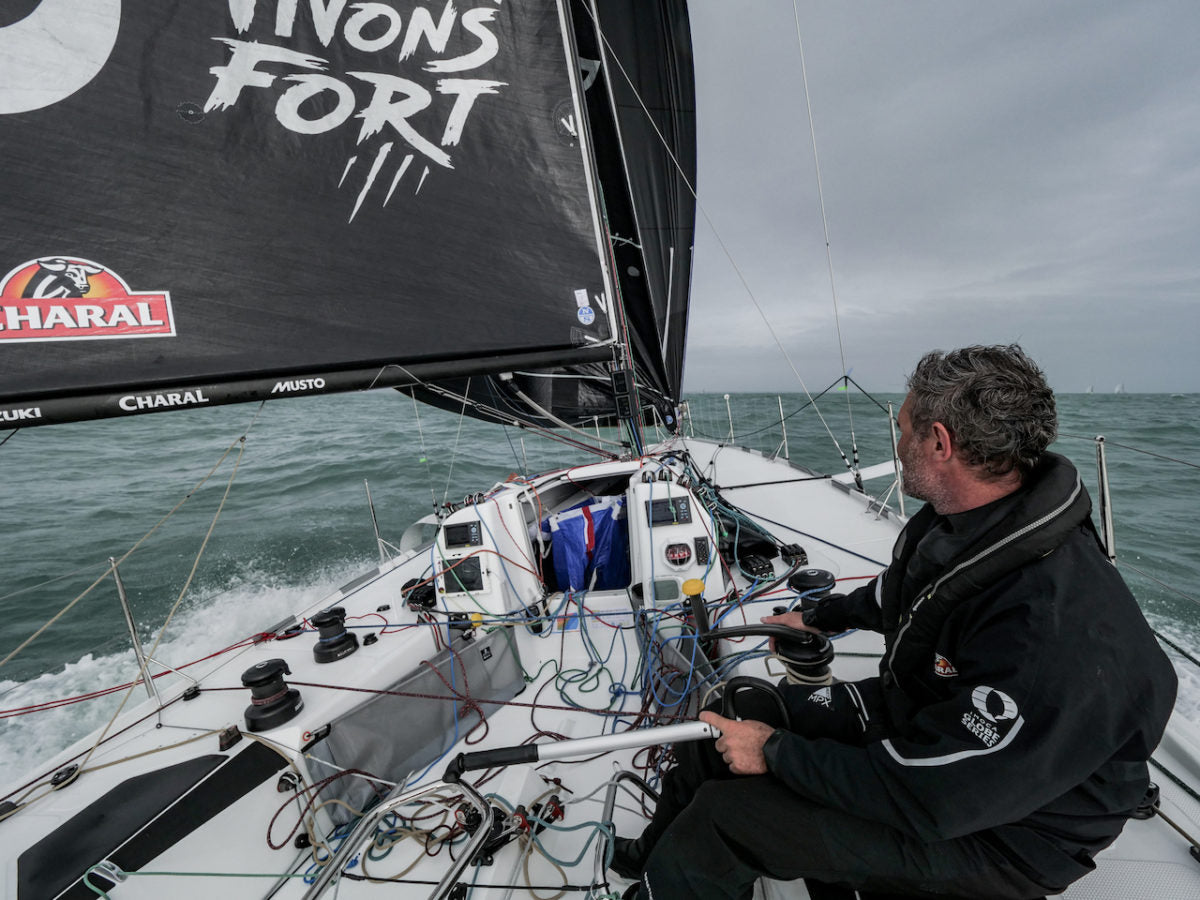
AVEC NORTH SAILS, JE PARS SEREIN
AVEC NORTH SAILS, JE PARS SEREIN
© Charal / Eloi Stichelbau
À moins d’une semaine de la Sardinha Cup (26 mars-13 avril), les Figaristes accélèrent la cadence et s’attèlent aux derniers préparatifs pour la première épreuve de la saison qui se disputera à Saint-Gilles Croix-de-Vie. Près d’un tiers de la flotte des Figaro Bénéteau 3 est équipé de voiles North Sails. C’est notamment le cas pour Charal de Jérémie Beyou, un habitué du circuit, et Banque Populaire d’Armel Le Cléac’h qui revient cette année sur la Solitaire Urgo Le Figaro après six ans d’absence.
Jérémie Beyou © Charal / Eloi Stichelbau
Armel Le Cléac’h se lance un nouveau défi pour la saison 2019. Après le chavirage de son trimaran Banque Populaire lors de la dernière Route du Rhum et en attendant la mise à l’eau de son futur Ultim en 2020, le vainqueur du dernier Vendée Globe prendra part à la 50ème édition de la Solitaire sur son Figaro 3 flambant neuf doté de voiles North. "L’arrivée de ce nouveau monotype à foils est une belle opportunité pour moi de revenir sur cette compétition difficile, six ans après ma dernière Solitaire, confie le double vainqueur de l’épreuve. Repartir avec des voiles North sur ce Figaro 3 paraissait comme une évidence. C’est une longue histoire avec la voilerie. J’ai confiance en leur travail, et je pars serein avec mes voiles North."
Pour ce marin accoutumé aux géants des mers, la Solitaire du Figaro reste une épreuve exigeante de haut niveau idéale pour ne pas perdre la main. "Naviguer sur un Figaro 3 est physique, on va chercher des limites d’un point de vue mental et sommeil, ce qui le rapproche des Ultims même si on ne va pas à la même vitesse et que le format de course est différent."
"C’est North Sails quoi, du 3Di!"
C’est avec le Pôle Finistère Course au large de Port-La Forêt qu’il s’entraîne à maîtriser et fiabiliser ce monotype signé VPLP, tout comme Jérémie Beyou, triple vainqueur de la Solitaire (2005, 2011 et 2014) qui signe sa 18ème participation. En parallèle à son programme Vendée Globe sur son Imoca Charal, Jérémie sera dès le 26 mars sur les pontons de Port-La-vie pour la première étape en double du circuit aux côtés du britannique Alan Roberts. Quant au choix de ses voiles, le skipper de Charal a fait confiance à la voilerie vannetaise. Derrière les voiles North Sails, c’est toute une technologie de longue date, une expertise et un savoir-faire que d’autres voileries n’ont pas encore réussi à égaler, précise Jérémie. Il n’y avait donc pas trop à réfléchir. C’est North Sails quoi, du 3Di ! Nos voiles plates 3Di sont adaptées à ce support technique et subtil et sont quasiment impeccables sans aucun défaut notamment pour la grand-voile et le foc de brise. On pourrait faire encore plus léger la prochaine fois, mais pour un premier jeu, c’est excellent.
© Charal / Eloi Stichelbau
Pour l’instant, l’objectif pour les deux skippers chevronnés est de poursuivre les tests en mer afin de parfaire le jeu de voiles. "On teste les voiles à tous les angles et à toutes les allures pour arriver aux meilleurs réglages possibles, explique Armel. J’échange énormément avec Quentin Ponroy, dessinateur de talent chez North Sails. Nous sommes dans la phase de finitions où on affine les détails pour obtenir un résultat qui me ressemble. Le choix des voiles pour la course doit être judicieux. Bien entendu, ces voiles vont forcément évoluer au cours de la compétition, et dans un an, elles seront peut-être complètement différentes."
Les échanges entre la voilerie et le skipper sont essentiels pour arriver au jeu de voiles final souligne Jérémie. "La voilerie, et surtout Quentin Ponroy, en charge des voiles, a fait un véritable travail en amont. On passe beaucoup d’heures sur l’eau à tester différents réglages en balayant les extrêmes. Quentin est également un bon marin et son ressenti apporte une véritable plus-value." Sur cette course, "tout se jouera au cm de réglage près", ajoute Jérémie, et la tâche sera ardue, d’autant que l’édition 2019 s’annonce acharnée entre le retour des ténors et la pléthore de jeunes talents. "On met cartes sur table cette année, et les places seront chères sur le podium, il faudra être très bon, conclut Armel qui participera à sa onzième Solitaire. Les anciens n’auront pas envie de ramasser les bouées et les plus jeunes de se faire malmener ! "
READ MORE
READ MORE

SPEED READING: SETTING GOALS
SPEED READING: SETTING GOALS
One Design Expert Zeke Horowitz Shares His Winning Formula
© Chris Howell
J/22 World Champion Zeke Horowitz explains how to put his winning formula to work for you this season.
If you’re a competitive sailor, you’ve probably read about the value of setting goals for your racing. By setting and trying to achieve your goals, you measure your progress as a competitor, whether the goal is to finish every race at a windy regatta, finish in the top half, score a finish in the top five, or flat out win the regatta.
It’s important to always be striving, but for most sailors, there’s usually one regatta each year where we really want to perform our best. Sometimes it may even be two years ahead. It might be the Fastnet Race or the J/70 World Championship. But it could just as easily be the Labor Day Regatta or the district championship for your one-design class.
If you haven’t named that event yet, do it now! Then follow these seven steps to be best positioned to peak at the right time and have your best result when it counts.
Step 1: Set up your team.
Your team is the most important part of your success as well as your fun. There is no substitute for sailing with people you enjoy and with whom you work well. Approach your team with the idea that you’ve got a season of sailing ahead of you with a goal of delivering your top performance at the big event. Get everyone on the same page and committed to an energetic effort to achieve this goal.
© Chris Howell
Step 2: Set up your schedule.
Look at the regatta schedule leading up to your big event. Take note of any events that have a high priority: Are any of them at the same venue as your big event? Are any local to where your boat is? Are any more likely to attract a big fleet? Send this full schedule to your team and try to work out which events make the most sense.
There is HUGE value in doing events with the ENTIRE team. You can always look for subs if someone can’t make it, but try to prioritize your regatta participation based on the whole team’s participation. Always include at least one day of practice as a “shakedown” before the regatta if schedules permit. If it fits at any events, try also to include a day of tuning practice with another team, so you can have a tuning partner and learn faster. A shakedown session and a tuning session could also be fit into the same, single day. Sailing before a regatta pays many benefits and can really help the whole crew be on point for racing.
© Bernie Kaaks
Step 3: What’s the budget?
This is obviously a big piece of the puzzle in our sport. You need to consider travel, logistics, food, boat equipment, sails, etc. Make sure your budget fits comfortably with your schedule. It’s often better to sacrifice a regatta if it helps your team with more room in the budget for equipment or more comfort at your other events. If you sacrifice equipment, time or comfort instead, you likely have a much less productive experience. I find having a top-quality experience at one less regatta is a good tradeoff.
Step 4: The Boat
In sailing, there are many elements that are not in our control—wind shifts, tides, competing boats, decisions made by race committees, etc. But one element that we can and must control is our equipment. The boat is the most important piece of that. Be realistic about the condition of your boat and make the changes needed to have the best boat possible. If you’re chartering a boat, do lots of homework, get pictures, and make arrangements for any upgrades necessary. Broken or non-functioning equipment is a massive time waster. Add in specific days to your schedule for boatwork. And don’t leave anything until the last minute. When you get to the big event, you need to be 100-percent confident that your boat is perfect.
Step 5: Sails
Depending on your class rules, you will have more or less room to get creative with sail purchases. But regardless, you need to be sure you have the newest sails possible for your biggest event. In some boats, that means having sails that are “broken in”; but even then you must make that part of your plan. Look at your event schedule leading up to the big event and decide when and where you should have each sail in use based on your goals for each event (see step 6). This is another element that you can control, and it’s important to do it as well as you can given the budget.
© Andrew Palfrey
Step 6: Goals within goals.
Your team is clear that your big goal is to peak at the big event. In the meantime, it’s critical to set specific and trackable goals for each practice day and each regatta on your path. Maybe the first regatta you want to work out specific crew communication and boat handling. Then work on starts and boat speed at the next one. Decision-making at the top of the beats, etc. It’s imperative to not only set these goals before every day on the water, but to then debrief them with your team after each race, each day, and each regatta.
Your goals for the next events will change based on your debriefs and based on what you learned at your last one. But you need to spend time working on all of the small details so that you’ve had a chance to learn your lessons and reflect on your mistakes before the big event. That way, your team can have confidence in doing all the little things well, and you can focus on the conservative tactics and superior boat speed needed for the big event.
Step 7: We’re finally here – the big event.
If you’ve done the first six steps well, then you know your boat, sails, and equipment are at 100 percent. You’ve taken the time to gain confidence in your speed and your boat handling. You’ve learned about your team and how to communicate effectively. You’ve determined roles for each teammate both on and off the water (who makes sandwiches, who puts the bow numbers on, etc.). Essentially, you’ve controlled all of the elements you are physically able to control.
Now your task is to have fun, continue to control the things you can, and make conservative, high-percentage decisions on the racecourse that allow your team to rely on its strengths. Continue debriefing after each race and each day throughout the event. Keep learning!
There is always going to be luck involved with our sport, and there’s not much you can do about it. In fact, most top sailors will tell you that it takes a bit of luck to reach the top of the podium.
With this approach, you’ll be able to put yourself in a position to achieve your goals. Whether or not you achieve this goal at the big event, treat it just like all your warm-up events and debrief it with your team. At that point, it will become another step along your path to the next big event, where you can choose to peak next year. Good luck, and have fun!
©Mauro Melandri | Zerogradinord
READ MORE
READ MORE
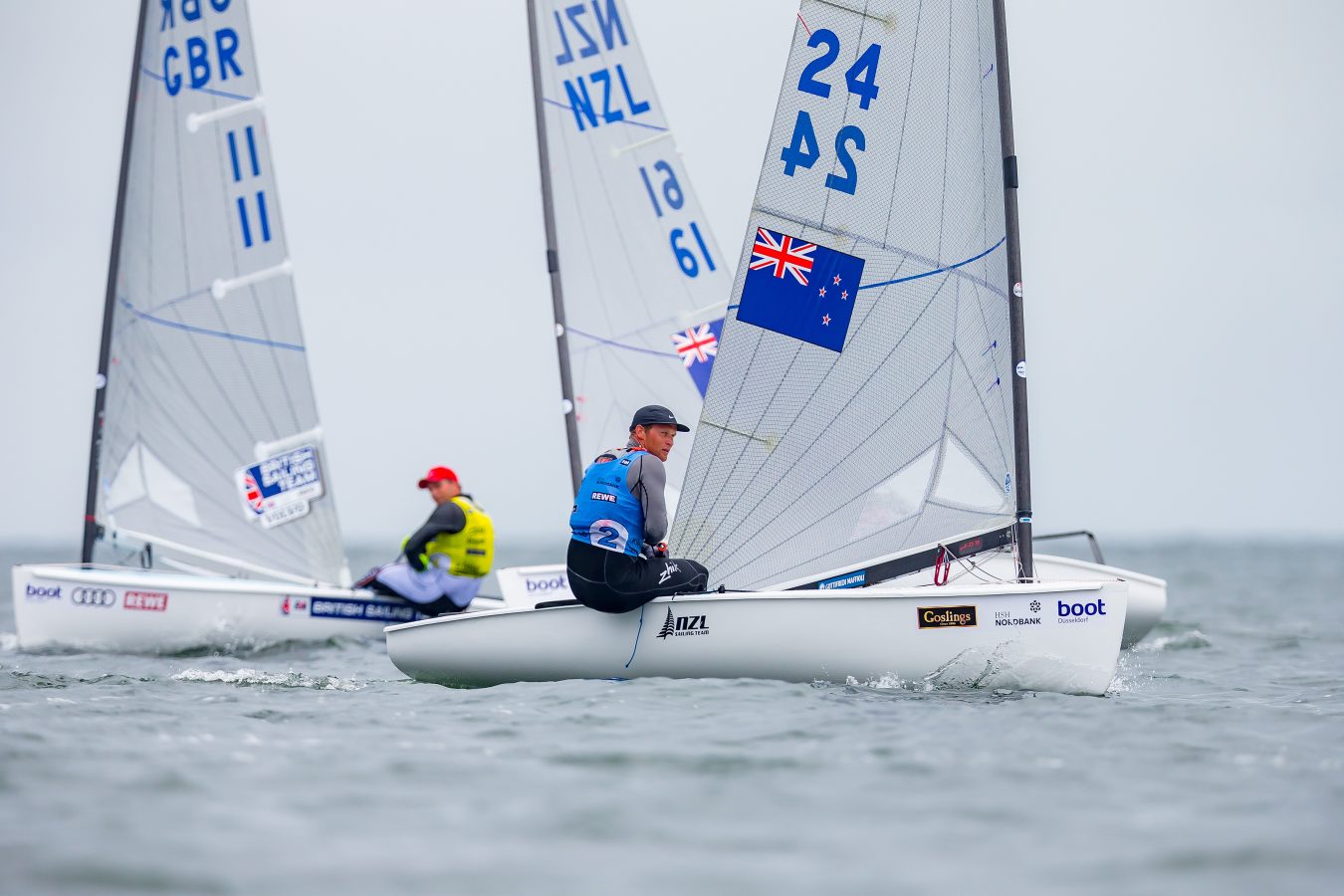
2019 FINN INVENTORY
2019 NORTH FINN INVENTORY
Optimized Designs for Sailing Conditions, Mast and Sailor Weight
© Sascha Klahn
The North Finn inventory is customized to complement each and every mast individually. Our Finn Radial designs are manufactured from North Sails’ exclusive NLXi Technora laminate, while the Cross Cut sails are manufactured from Maxx Aramid laminate. Find below our sail selection charts which shows the sail that best suits your weight, mast and sailing conditions.
WILKE & PATA MASTS
CONSTRUCTION
RADIAL
RADIAL
CROSS CUT
WIND RANGE
0-8 Kts
5-12 Kts
8-18 Kts
15-30 Kts
All-Purpose
All-Purpose
FABRIC
NLXi-02 Technora
NLXi-03 Technora
NLXi-03 Technora
NLXi-03 Technora
NLXi-03 Technora
Maxx 06F Aramid
100+ KG
MB-1GL
MB-1G
M-1
MB-1G
M-1
MX-6
96-99 KG
MB-1G
MB-1G
MB-1G
MX-7
92-96 KG
MB-1G
MB-1G Minus
MB-1G
MX-7
-92 KG
MB-1G Minus
MB-1G Minus
MB-1G Minus
MX-8
HIT MASTS
CONSTRUCTION
RADIAL
RADIAL
CROSS CUT
WIND RANGE
0-8 Kts
5-12 Kts
8-18 Kts
15-30 Kts
All-Purpose
All-Purpose
FABRIC
NLXi-02 Technora
NLXi-03 Technora
NLXi-03 Technora
NLXi-03 Technora
NLXi-03 Technora
Maxx 06F Aramid
100+ KG
MB-1GL
MB-1G
M-1
Xi-2
M-1
MX-6
96-99 KG
Xi-2
Xi-2
Xi-2
MX-7
92-96 KG
Xi-2
Xi-3
Xi-2
MX-7
-92 KG
Xi-3
Xi-4
Xi-3
MX-8
Standard Features: Class insignia, sail numbers, vision window, Epoxy battens, elastic batten pockets, plastic headboard, leech and trim tell tales, leech line, 7mm luff rope, long roll bag, World Sailing in-house measurement and class royalty label.
Optional Features (additional cost): Carbon battens, carbon headboard, stick-on pockets, adjustable elasticated luff and country flag.
For more information on the North Finn designs or to place an order please contact your local North loft. Please have your mast bend numbers available.
READ MORE
READ MORE
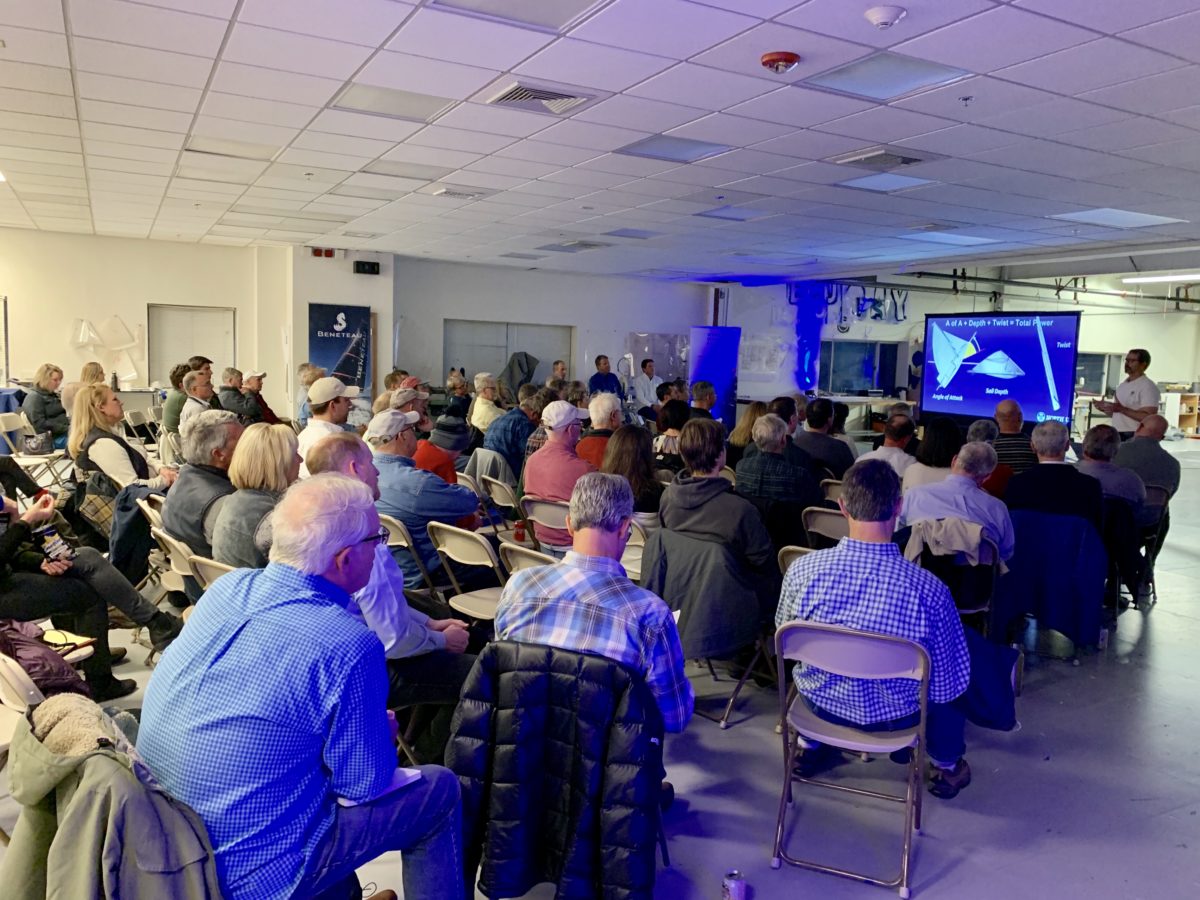
A NIGHT WITH OUR EXPERTS
A NIGHT WITH OUR EXPERTS
Winter Seminar With North Sails In Portsmouth, RI
North Sails in Portsmouth, RI hosted a starting strategy, sail trim, and tuning seminar to kick off the Spring sailing season. One Design President, and multi-World Champion, expert Tim Healy gave a technical presentation about headstay sag and prebend, and how that affects your angle of attack, sail depth, and twist. Going into a significant amount of detail on headstay sag, Tim shared the ways it can be controlled on any given boat.
Adjust your jib halyard
Adjust your shroud tension
Backstay tension
Mainsheet tension
Mast blocks at the deck (if your boat has it)
Moving your mast forward and aft are all ways to adjust your headstay length
When is headstay sag most ideal? Tim says when you have light to moderate wind conditions, or when you are looking for more power. When you are looking to get more power, headstay sag can also help get you more speed, allow you to point higher. Off the starting line, it can also contribute greatly with your accelerations. Learn more about headstay sag here.
One Design expert and sail designer, Mike Marshall, fresh off his J/22 Midwinters win gave the audience some great tips on starting line strategy. Even for Mike, starting isn't easy! He presented three questions you should ask yourself before every start.
Where do you want to start on the line? Boat, middle, or pin?>
Am I high or low in the box?
Am I leading or pushing?
The same processes can be done at every start you. With main concepts to think about things like where is the wind coming from , line bias, what are the tacking angles , where is the most pressure on the race course, and is there any current that can influence where you are at your final approach. Tim Healy contributed an excellent point to Mike’s overview, which explained the importance of being confident with slow boat handling at the start. Being able to maintain your place on the line, and not accelerate too soon can almost guarantee you a hole to leeward at the start. Both Mike and Tim agreed that patience was vital because some opportunities open up a little last minute, but can save you the stress of having to find an escape route after go. Learn more about starting strategies here.
Experts Tim Dawson and Henry Little were also there to support the seminar topics, giving their perspectives from racing on larger One Designs to 100-footers. All the the seminar topics can be applied to boats of all kinds, and all sizes.
There was a ton to learn from some of the best in our industry at the seminar in Portsmouth, RI, and the crowd brought some great questions that we can all relate to. Sailors who partake in local racing were in grand attendance, including local Laser sailors, Thistles, VX One, Shields, J/24s, PHRF, ORC, IRC racers. Thanks to our experts for a great night, bringing local fleets together in Rhode Island to get us all pumped for some great racing in one of the best places for sailing New England has to offer.
Questions about rig tune, racing, or sails? Contact your local loft today!
READ MORE
READ MORE
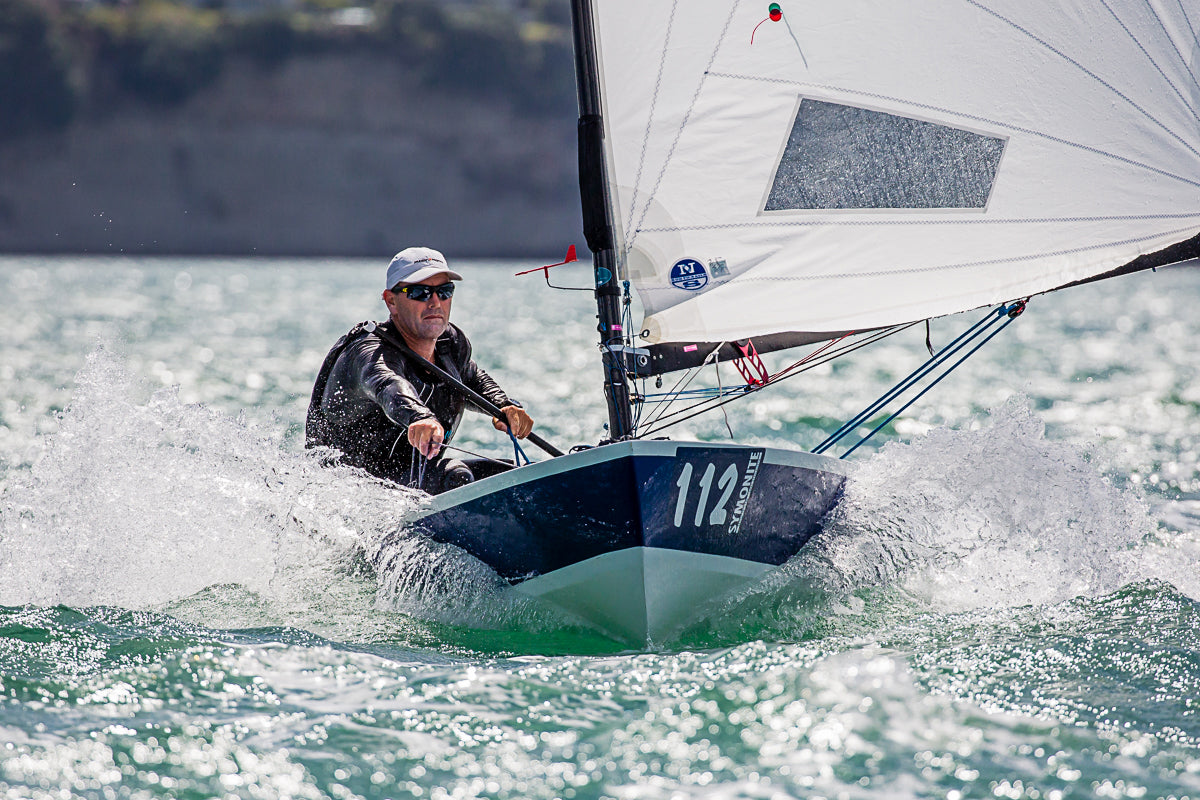
OK DINGHY WORLDS: PERSPECTIVES FROM THE NEW WORLD CHAMPION
OK DINGHY WORLDS: PERSPECTIVES FROM THE NEW WORLD CHAMPION
Dan Slater Explains How He Won The 2019 Title
© Robert Deaves
Dan Slater was an Olympian in the 49er and Finn classes for New Zealand when in 2015 he began sailing the OK Dinghy, which he describes as a “smaller, hard-chine version of a Finn Dinghy.” Age 43, Dan had long been working as a sailing coach while also running a watersports and dinghy specialist shop called The Water Shed and says that after his Olympic class sailing days, he’d begun to miss sailing in a competitive fleet. He built his own OK and found in racing it a good chance to stay sharp for professional sailing work.
When the OK Worlds came to Auckland in 2019, Dan admits he might have had a home field advantage. He had been sailing for 25 years in those same waters off Takapuna, where the America’s Cup racing was held in 2000 and 2003. But Dan was not the only sailor with a local edge. Some 25 to 30 boats race in his local fleet on Sunday afternoons and contributed dozens of competitive entries to an overall fleet of 110 Worlds competitors. They finished well, too, with only three non-Kiwis finishing in the top 10.
Conditions for the regatta were relatively normal for the summer season. “We were lucky,” Dan says. “We had wind from every direction of the compass. A couple of light races, a couple quite breezy, and otherwise generally 12 to 15 knots.”
The starting lines were 600 meters long, and it was often shifty. “I had to be in the middle of the line and make the call on where to start at two and a half minutes to go,” Dan says, “then get towards the end I wanted and find my position. At one start near the pin, I tacked after 20 seconds and crossed the fleet. In small boats, you have a lot of leverage on a line that long. And the beats are only a mile long.”
© Robert Deaves
Bold decision-making was required to succeed in a regatta such as this, but Dan’s speed was also excellent, and he sailed with extraordinary consistency for the first seven of nine races, winning one race and always finishing in the top four.
Getting in good physical condition made a big difference, Dan says, and in preparation for the regatta he lost five kilos and built up his conditioning.
Dan had been working with North Sails all four years since joining the class. The OK allows only Dacron or other woven cloth, but offers design flexibility, and sailors can choose two sails to measure in. Dan says his deal with North was to help develop an all-purpose design that everyone could use (with modifications to luff curve to match each sailor’s mast-bend numbers), and he got several local sailors involved including former Olympic medalist Rod Davis.
While Dan designed a variety of shapes, he ended up measuring in a light-air sail plus the all-purpose sail, the KP-1. “I used the KP-1 in 8 of the 9 races,” Dan says. “We had the perfect 12 to 15 knots, exactly what it was designed for.” The sail has a bigger range than other designs, he says, with a “twisty head,” but you have to be prepared to trim more, which is a change for many OK sailors.
Rod Davis used the same sail, finishing ninth overall and first in the Masters Division, and several other Kiwi sailors did well with the sail.
© Robert Deaves
On the last day of sailing, Dan had a pair of finishes in the 20s. “I made a meal of the first race,” he says. “There was a southerly fighting a westerly in the first race, with puffs from both sides, and at the start there was a massive right-hand shift. Some guys almost laid the mark from the start. I was down toward the pin and rounded the weather mark with only five boats behind me. The saving grace was that the other top guys were only about 10 boats ahead of me for the whole race, so nobody put heaps of points on anybody else.” Dan crossed the line in 24th, his discard race.
“In the second race,” Dan says, “I had a blinder start and was in control of the fleet. I knew Freddy was the only one who could beat me, so I just stayed close to him and didn’t worry about where we finished.” In that race, Dan finished 21st.
One of Dan’s takeaways from the championship was for local fleets, like his New Zealand group: “We need to look at the length of our beats in club racing,” he says. “We tend to do short laps and don’t really learn whether we are fast or slow.” He recommends some longer legs to prepare for major events.
For OK Dinghy sailors generally, Dan says, “Keep enjoying it! If you enjoy it, you tend to do more of it.” One way to do that is to make sure your boat is as comfortable as possible to sail, he says, which he planned to do for next season by widening his side decks to make hiking less painful.
Results: http://2019.okworlds.org/wp-content/uploads/2019/02/Results-Race-9.html
© Robert Deaves
© Robert Deaves
READ MORE
READ MORE
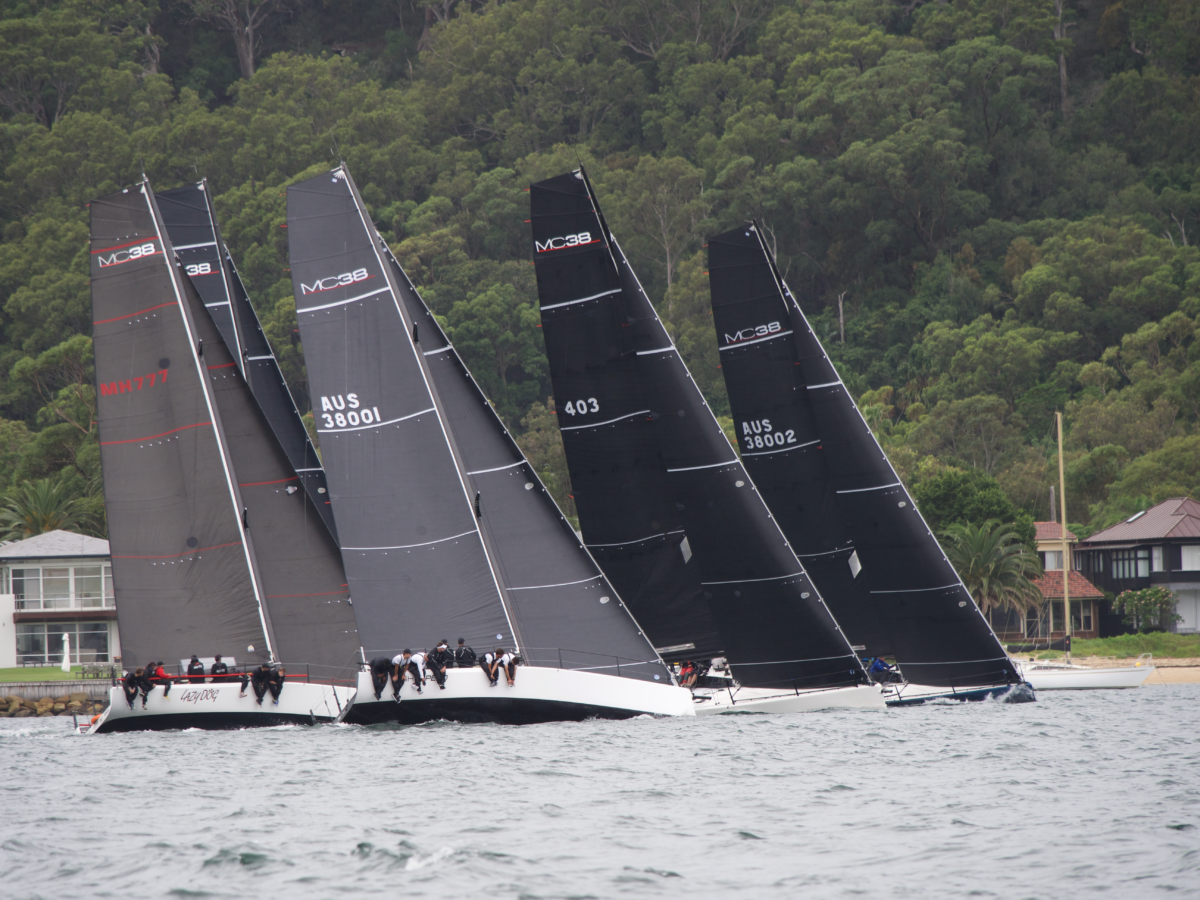
MC38 AUSTRALIAN NATIONAL CHAMPIONSHIP
MC38 AUSTRALIAN NATIONAL CHAMPIONSHIP
Clients Favor Pittwater Conditions Sweeping Title
© www.tillylockmedia.com
The MC38 Nationals were conducted in the waters of Pittwater in 2019 with variable conditions over three days which Pittwater is notorious for. The Maserati team with Tom Quick at the helm took out the regatta after a strong last day. Skipper Joe Turner had the following to say “We had an issue with our boat the week of the regatta so we missed our opportunity to test and commission our sails for the nationals. But the work we have done with North's over the past 12 months had paid off and the new sails were spot on out of the bag. Which got us out of a bit of trouble. We are really happy with our set up, the boat is consistently on pace in all conditions, just need to send it the right way more often! Neville has been a great leader for myself and our team. He took me on as boat captain/tactician with little one design tactical experience and over the past four years we have built a very solid team and program. His long lasting relationship with Cocko and North Sails has been a key to our success.”
"Neville has been a great leader for myself and our team, and his long lasting relationship with North Sails Michael Coxon "Cocko", has been a key to our success at the MC38 Australian Nationals"
© www.tillylockmedia.com
North Sails powered yachts Maserati, Dark Star, Lightspeed, Hooligan, Swish, Ginger and Ghostrider all equipped with North 3Di upwind sails and V-Series downwind. Not only were North Sails powering the top yachts in the class, they were also well represented with the following staff; Paul Westlake & Matiu Tehau on Hooligan, Billy Sykes on Swish, Richie Allanson and Noel Drennan on Ginger, Rob Greenhalgh and Kyle Dodd’s on Ghostrider.
© www.tillylockmedia.com
© www.tillylockmedia.com
© www.tillylockmedia.com
READ MORE
READ MORE
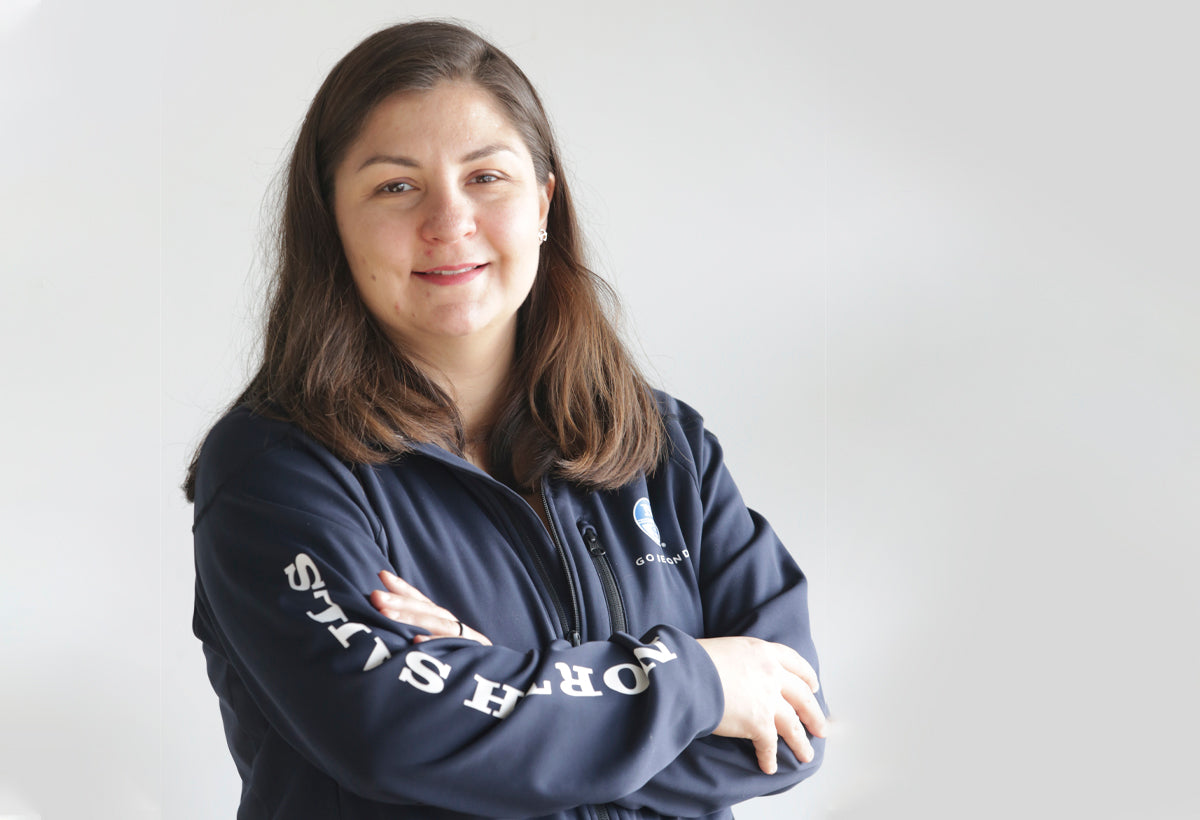
WHO WE ARE: DEANNA TREJO
WHO WE ARE: DEANNA TREJO
Get To Know Your Local Sales Expert
How long have you been involved in sailing?
I’ve been sailing out of Chicago since I was four years old when my dad decided to buy a Capri 22 Catalina. As the family grew, so did the boat, and we upgraded to an Alberg 35. We did Junior Fleet and graduated to Wednesday night beer can racing.
What boats/classes do you sail?
For the last 15 years I’ve been sailing the Rhodes 19 with active Fleet 12. I’ve also been sailing on a Dufour 36 P for the last two years, also competing in two Chicago Mac Races on that boat. My main position is jib trim, and I also make a mean breakfast burrito for the long distance races. I’m working on making a sailor out of my husband – we chartered a boat in Lake Superior for a lovely honeymoon.
What got you into the marine industry?
It was a lucky break that I ended up working in the marine industry. I was looking for a new job in 2013, and a friend told me about a temporary, part time position at North Sails they saw advertised in Scuttlebutt Magazine. I applied for assistant Office Manager, was hired, and survived my first Chicago Mac at North Sails the summer of 2013. In the end offered the position full time permanently as Office Manager.
What's your favorite aspect of working in the industry?
Being in the industry since summer of 2013, one of my favorite aspects is learning how many other people make a living based on their love of sailing and the variety of ways in which they carve out a profession – from dealers in faraway cities and towns, to local positions at different yacht yards, to sailing instructors and yacht club managers. It’s a bigger world than I had imagined. Another aspect I enjoy at North Sails is helping customers at events we host, such as the Chicago NOOD, Strictly Sails boat show, and North U. Seminars. Learning more about sailing is always a fun activity for everyone involved, and it’s a great way to get out of the office and meet our customers in person, which is valuable.
What's your favorite aspects about sailing?
My favorite thing about sailing is that it’s the easiest way be outdoors and get away from the city in a place like Chicago. It’s a whole different perspective on life once you get off shore. Second to that, I love making the boat go fast.
READ MORE
READ MORE

BAD NEWS WINS J/22 MIDWINTERS
BAD NEWS WINS J/22 MIDWINTERS
Interview with Mike Marshall, Todd Hiller and Zeke Horowitz
Team Bad News, 2019 J/22 Midwinter Champions. ©Chris Howell
The J/22 Midwinters were held at Fort Walton Yacht Club, FL. Sailors were surprised to find that it can actually get pretty chilly in Florida, especially on the panhandle of the state. Conditions proved to be quite tricky, with wild wind shifts and extremely varying pressure differentials across the course for almost every race. The RC certainly had their hands full trying to get proper races off due to these conditions, but they certainly got the job done well. Jackson Benvenutti (who sailed with David Muller, finishing 7th) caught up with team Bad News, the winners of the event, Mike Marshall, Zeke Horowitz, and Todd Hiller to see what the most important elements were in the given conditions to end up on top at the end of the event.
Mike, it’s certainly quite hard to drive the boat in those conditions and also control the mainsheet, traveler, and backstay all at the same time. What was your order of operations as you hit a puff, and then what did you do as the puff faded away?
First, nice work by Jackson and the rest of the team on Call the Ball for winning the last race of the regatta! As for handling the controls, I’m almost always on the keep-it-simple program. I only have two hands, and one of them is dedicated to the most important job I have – driving the boat fast. This means I can’t adjust mainsheet, traveler, and backstay all at once. So it’s about prioritizing. In this regatta, I felt that it was best to use mostly traveler. The puffs and lulls were very short and with very different velocities. By using the traveler, I could adjust the boom angle almost a meter in a very short time. This enabled me to depower quickly when the sharp puffs hit and power back up afterward in the lulls. Since I was using the traveler, the mainsheet didn’t need as much attention because the leech of the main was just moving to windward and leeward, not twisting more or less. (Also, this constant leech tension helped to keep a constant headstay tension.) With the traveler and mainsheet mostly under control, I adjusted the backstay in only the largest puffs or lulls or when I was trying to sail the boat in a high or fast mode. If I had the traveler all the way up or down, I would move to the backstay next.
I know this seems a little backwards to what you would normally do by playing the backstay, but I think that the change was justified given how big and short-lived some of the puffs were. That’s why I spent most of the regatta with the tiller and the traveler in my hands and the mainsheet over my knee. Occasionally, I would adjust the mainsheet, and even less occasionally, the backstay.
I only have two hands, and one of them is dedicated to the most important job I have – driving the boat fast. This means I can’t adjust mainsheet, traveler, and backstay all at once. That’s why I spent most of the regatta with the tiller and the traveler in my hands and the mainsheet over my knee.
Zeke, playing the jib is certainly a huge necessity on the J22, especially in the given conditions. Can you explain how and when you liked to ease and trim the jib as puffs hit and also through the big shifts? How did you and Mike keep in tune with each other during such big course changes in the shifts?
You’re right, accurate jib trim in the J/22 is possibly the most important facet of upwind boat speed in shifty/puffy conditions. It’s imperative to keep an active jib sheet to help the driver maintain a balanced helm and steady heel angle. I was the tactician upwind as well, so balancing the concentration on looking around while trimming the jib can be difficult. But I would look for opportunities when I knew we weren’t tacking for a while to really dial in my focus on the jib. I would stare at the tell tales so that if we got a lift and the outside tell tale started to flick, I could immediately ease the jib between 3-9 inches so that the bow could easily come up in the lift without Mike having to push the tiller too hard.
Conversely, if a header hit and the luff of the jib started bubbling, I could give the winch handle a little pump to artificially over trim the jib to help the bow go down. I would also try hard to ease the jib in a puff even if it wasn’t a huge shift. If the boat was beginning to heal over, I could burp the jib 1-3 inches which opens the leech, keeps the head stay straighter and helps to de-power. It also gives the bow an easy opportunity to come up and feather through the puff which can be very effective in flat water. As soon as the boat was coming back to its normal heal angle, I would trim the jib back in. Mike and I would talk about the feeling in the helm as I would move the jib to make sure we are staying on the same page and that what I was feeling was accurate with what the helm was dictating.
Busy starting line at the 2019 J/22 Midwinters. ©Chris Howell
Todd, you were the eyes and essentially the tactician downwind. Can you explain how you managed clean lanes, making sure you weren’t in dirty air? What tools do you use to do this?
Managing clean lanes downwind was particularly challenging at this event as any breeze that presented itself generally would go around (outside perimeter) of the race course. There were four basic items I would consider downwind.
1. COA (Course of Action): It was important to determine what our next move was as we approached the weather mark. Based on where saw the maximum pressure determined whether we would set and extend or jibe immediately at the weather offset.
2. Execution: Maintaining a clean lane downwind, it was important to track how the fleet would set up behind us. As traffic accumulated after the weather offset, this would dictate whether we had to stay high to keep a clear lane or potentially jibe to separate from the fleet. As simple as this may sound, but our windex was an invaluable tool and it was important to stay in check with which direction it was pointing. Using the fleet as wind indicators helps too.
3. Pressure: If Zeke felt light on the spinnaker sheets, then I would quickly look up and assess whether we needed to step up a lane or suggest a jibe. The overcast conditions made it difficult to see the actual breeze or if your mind was playing tricks on you. At times, as a sanity check, Zeke and/or Mike would look back to confirm my observations.
4. Weight: My position on the boat downwind was critical. If we needed to head up, I would shift my weight to leeward and use the curvature of the hull to steer the boat. Likewise, when we needed to head down, I would move my weight to weather. My goal downwind is to have Mike steer as little as possible and make sure Zeke had descent pressure on the spinnaker sheets.
Todd, how do you communicate to Zeke and Mike downwind? Can you give us a common conversation that might be happening at any point on a run?
A common conversation downwind would be that I would ask Zeke how the pressure was in the spinnaker sheets. Again, my goal was to mitigate any excessive steering with Mike. I would constantly call pressure coming his way. As soon as he had it, I would either shift my weight to weather to steer the boat down or if we decided to extend forward we would keep the boat flat. At about 2/3 of the way down the leg, based on our upwind observations we would determine which gate to round. At any point into our approach to the leeward gates it was then decided which was closer. If we needed to adjust our upwind game plan, then it was at this time when we would execute our maneuver. It was also important to keep an eye on the downwind traffic. If a majority of the fleet were on any particular side, we would quickly decide if the juice was worth the squeeze sailing upwind in dirty air to get to the favored side of the upwind beat.
Jeff Todd’s Hot Toddy, 2nd place. ©Chris Howell
Mike, what did you do to prepare the boat before the regatta? What were the three most important things to get your boat in shape before putting her in the water?
The good news for me is that I know this boat very well, and I always know what condition it’s in when I leave it after the last regatta. One of the keys to good boat prep is to have the boat ready to sail whenever you are. At the end of an event, I try to fix all the things that need attention before I put the cover back on. This means fewer things to think about when getting ready for the next regatta. When I arrive at the next venue, I have to think about only three things: the bottom of the boat, the rig, and whether everything I need is onboard.
To prep the bottom, I wash the road dirt off with soap and water. Then I polish the bottom with some PTEF. Step 1: Done. Next, I step the mast and return the rig to my base setting using the caliper numbers that I’ve written inside the hull. Step 2: Done. Finally, I check through all the lines, safety equipment, radio, compass, and other gear to be sure that nothing essential is missing and that nothing extra is on the boat. I have a checklist for doing this so that I don’t forget anything. Step 3: Done. It seems pretty simple when put in these terms, but simple and straight-forward is what I aim for. Anything more complicated is just asking to become a time sink that could take away from potential practice time on the water.
Who was in charge of rig tune for the event, and how did you decide to set it up given the varying conditions?
Zeke – It was fun working as a team on the rig tune discussion. We only ever let Todd touch the turnbuckles (except for the couple times we adjusted it between the warning and the prep!) but we talked about it as a team and we even took turns sighting up the rig to confirm what the sag was looking like. Mike knows the tendencies of this rig better than either of us so we let him have the final say, but we would all give our opinions based on what we saw. We found we had a more forgiving groove with the rig on the looser side so we always erred towards being able to set up for the lulls and survive through the puffs. We knew we had great “base” numbers and from there we stuck to the 2:1 ratio of uppers to lowers.
Teams powered by North finished 1, 2, 3, 4, 6, 7, 8, 9*, 10. Congratulations to all!
Learn more about the North Sails products for the J/22 class.
Full Results
Casey Lambert’s Blackburn Marine Racing, 3rd place. ©Chris Howell
North Sails J/22 expert Jackson Benvenutti trimming the spinnaker on Call the Ball. ©Chris Howell
Mike, Todd and Zeke, winners of the 2019 J/22 Midwinters. ©Chris Howell
READ MORE
READ MORE
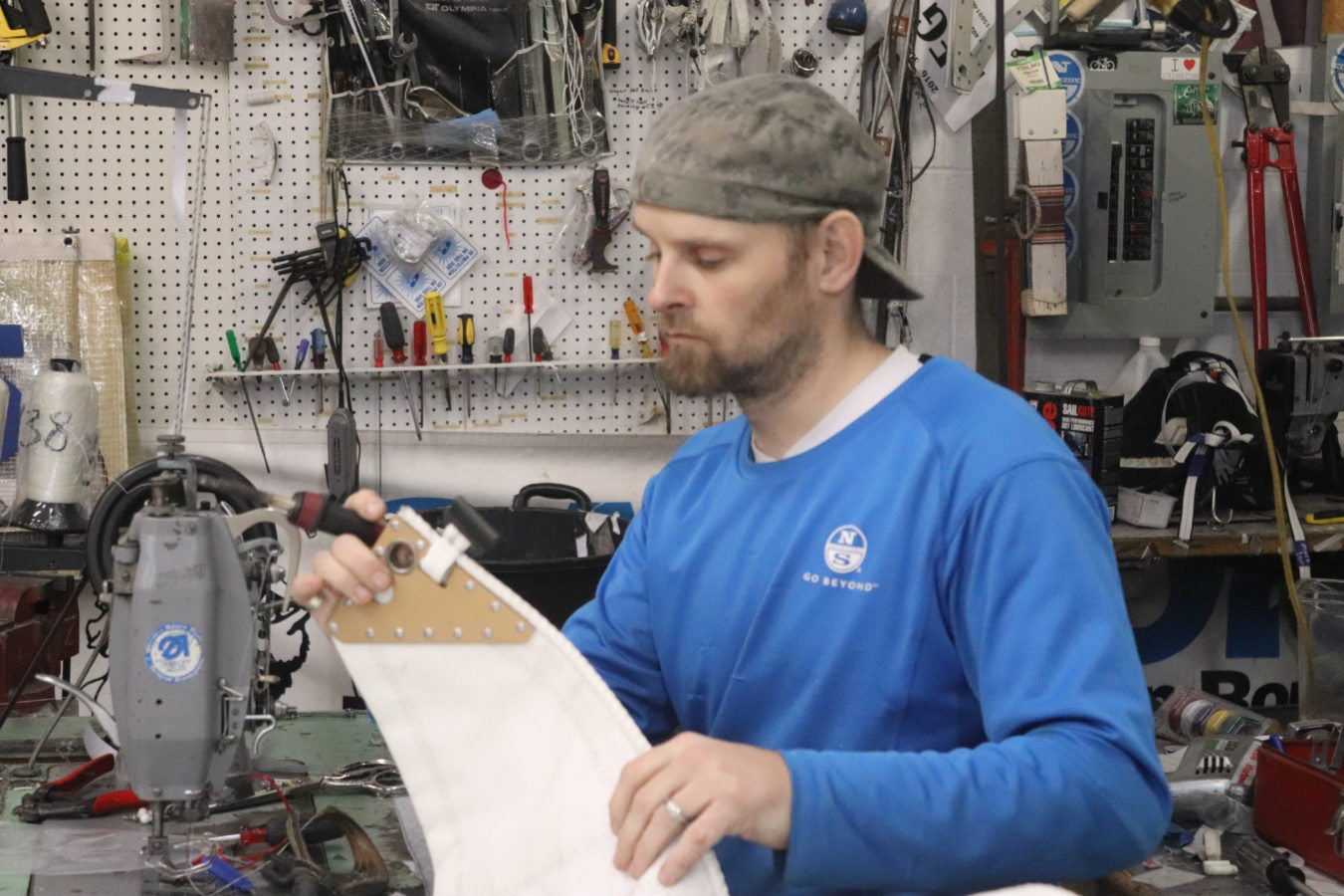
WHO WE ARE: LUKE LOGAN
WHO WE ARE: LUKE LOGAN
Get To Know Your Local Service Expert
What do you sail?
Anything from Cruising boats to racing. I grew up sailing on my family's Chesapeake 32 and Cal 36, and I've been sailing since I was a kid.
What got you into the marine industry?
Growing up on the water, I was drawn to a "profession" that integrated my own passion to be on/around the water, with helping people to further explore what sailing has to offer in the form of recreation and relaxation.
How long have you been in the industry?
Having been in the industry for over 20 years, I especially take pride in going the extra mile for customers, and maximizing their time on the water, in whatever form that may be. Whether its sailing, windsurfing, or kitesurfing, I will take great pride in offering you the best sail care that the Great Lakes has to offer!
READ MORE
READ MORE
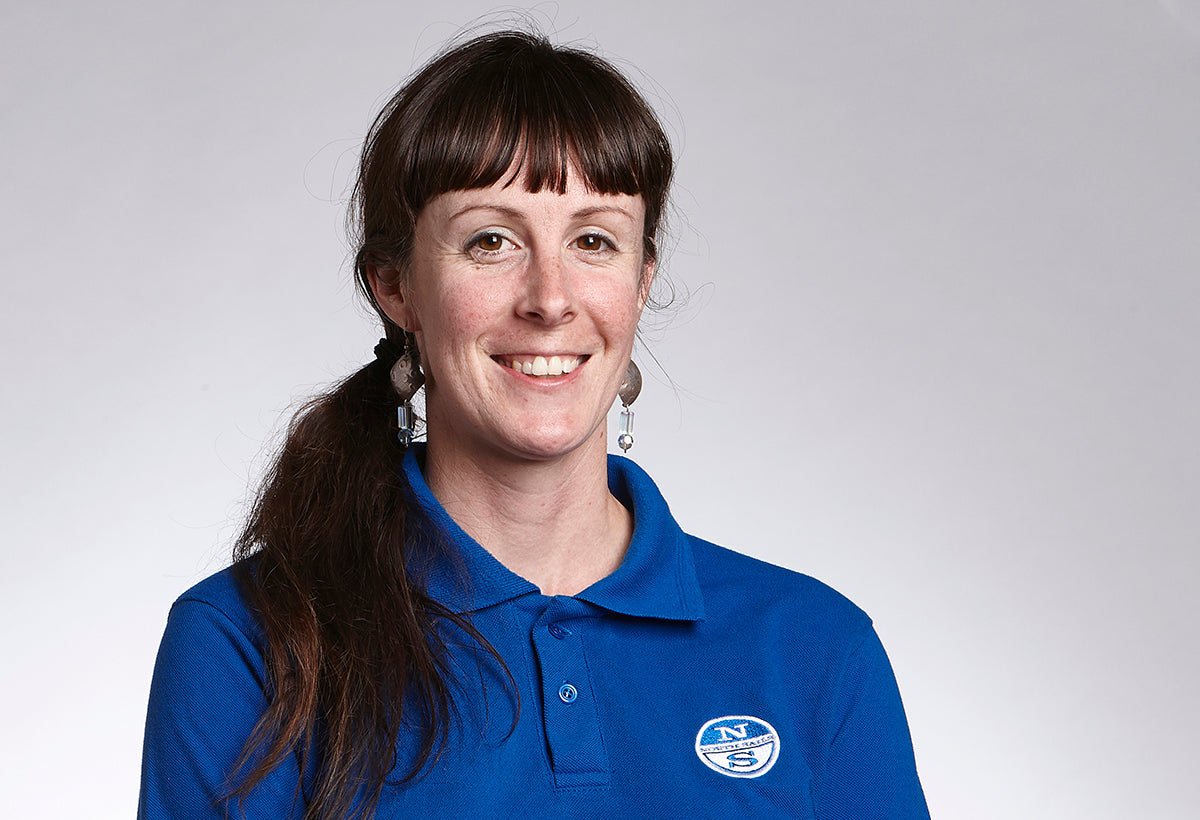
WHO WE ARE: CHELSIE STRONG
WHO WE ARE: CHELSIE STRONG
Get To Know Your Local Team
How long have you been with North Sails and what lead you to pursue a career with the Detroit office?
I am the newest member of North Sails Detroit with only seven months under my belt. I was interested in working for a sail maker due to my parents and in particular, my father’s passion with sailing. Although my parents sold their modest sailboat shortly before I came into the world, I still grew up instilled with a high respect for the sport and craftsmanship involved in boat building and sail making. I thought that working for a reputable sail maker in Detroit would be a unique opportunity to sort of reconnect with my family’s past.
Why do you believe your background makes you a good fit for North Sails Detroit?
I see a lot of parallels with my personal background to the marine industry. I was a swimmer my whole life and am still a very avid water sports person. I love the great lakes and the beauty that our region offers, being the largest freshwater resource in the world. So to me, whether it be by sailboat, canoe, kayak or other vessel, being out on the water is one of my favorite places to be. I also spent many years working in the aquatics industry where I honed my customer relations skills which I believe is a very large part of the north sails mantra- providing excellent customer service.
What excites you about your future with North Sails?
Two things come to mind: One being my adult sailing lessons that I will take at Bayview Yacht Club this spring. The second being North Sails Sustainability push and the #GoBeyondPlastic campaign. I feel like learning to sail is something that should have happened for me many years ago; so I am ready to finally get out there and learn how to use the wind to power a boat. Although sailing is already a pretty sustainable activity, North is taking it a step further and doing its part to help remove harmful plastics from the oceans (and lakes) and to help each loft become more sustainable in daily practice. I like that North is being part of the solution, not the problem on this subject.
What have you learned thus far about the sail-making industry?
Well, I have learned a lot. Bill Lesnek, our service manager has been teaching me the lingo and a lot of basic technical stuff about sails and boats which I find fascinating. Karl Kuspa has started introducing me to the sailing community of our area so I am getting to know the people. I have also learned how much science is going into sail making today and much about the history of sails and materials used. I can also see that North Sails is a deep company with a lot of very passionate, hard-working, and friendly people that are always there to help when you need it.
READ MORE
READ MORE
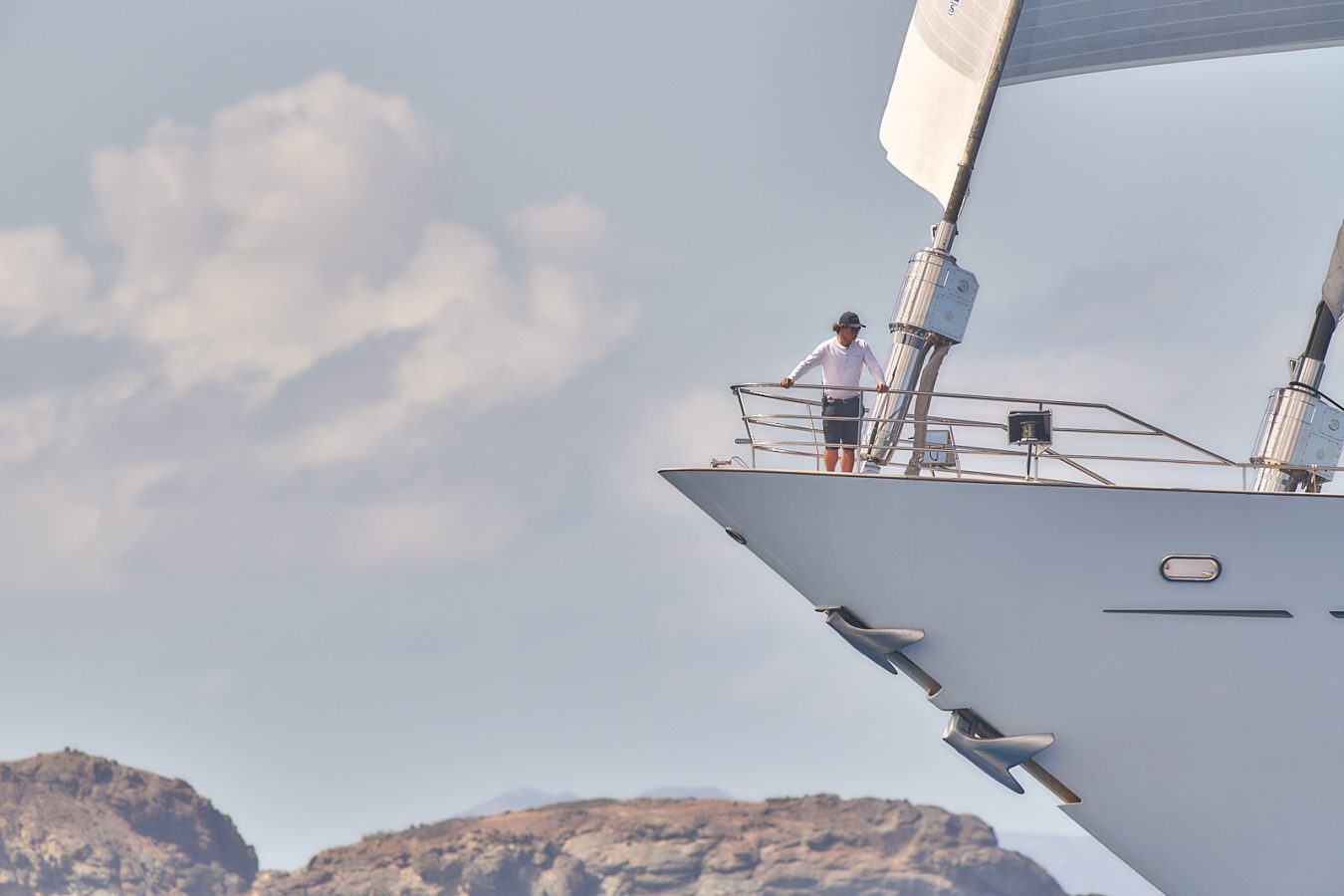
2019 ST BARTHS BUCKET PREVIEW
ADD ST BARTHS TO YOUR BUCKET LIST
North SY Expert Quinny Houry Sets The Scene For This Must Sail Event
📸 Michael Kurtz / St Barths Bucket
The St Barths Bucket has a placeholder on many calendars within the North Sails network. This annual superyacht regatta is a ‘must do’ for more than just its tropical location. The Bucket is considered one of the most Corinthian events of the superyacht circuit, mixing great sailing with a casual vibe that is enjoyed by owners, their guests and the crew who help sail these modern superyachts.
Taking our cue from the event, North Sails is onsite (and onboard) to make sure all 36 yachts taking part in the 2019 St Barths Bucket are race ready throughout the four-day event. Palma-based Superyacht expert, Quinny Houry will be sailing on Missy, an MM330. We called Quinny in advance of his trip to collect his thoughts on the 2019 event, and why, the Bucket has a place in Quinny’s schedule since 2003.
Quinny, set the scene for those of us who have not been to the Bucket before.
The St Barths Bucket is the Corinthian Superyacht event of the modern era – a mix of owners, pro sailors and guests onboard all the boats. The owners are very comfortable to bring their boats because they’re with friends. For the pro sailors, it’s just an amazing place to be out on the water. The island lends itself to ideal superyachts racing, and also the infrastructure to support an event this size. Anybody who loves sailing, and gets an opportunity to do the event, should.
The Bucket is similar to a golf Pro-Am tournament because although there’s competition, and you have some of the best sailors in the world, everyone on the water is having fun too. The most amazing thing about the racing is you’ll have an America’s Cup helmsman, and Olympic gold medalist sailing on your boat; it’s the equivalent is being able to go around a Grand Prix track with Lewis Hamilton driving your car. Owners really see the potential of their boat, whereas when you’re cruising it, you don’t see the potential because you don’t have world class sailors sailing it.
When I’ve sailed with Shirley Robertson, who’s won two Olympic gold medals, and she’s on the boat giving the debrief, the owner is sitting there listening to her give her views on the race you’ve just had and they really feel part of it. It is an amazingly unique event.
📸 Claire Matches / St Barths Bucket
The 2019 entry list has 36 superyachts signed up. Knowing the scale of these yachts, 36 seems like a massive number. How do the event organizers manage traffic on the start line and around the race course?
The superyacht racing rules are written for the safety of the boats and their crew. There are two things; one you don’t have a fleet start, so there’s only one boat on each start, and then you have a 40-meter rule – which means that if you go within 40 meters of another boat, it’s considered a collision. That said, 40-meters is essentially a boat length and exceptionally close in real life when you’ve got 200 tons going towards another 200 tons!
But there is also respect and an understanding that this is a Corinthian event. So the racing, although hard, it’s still comfortable, and there are different levels of participation. Some people push quite hard but the majority enjoy sailing around the island seeing how they fare against other similar boats.
North Sails has set up a pop-up service loft for the past few years. What does this level of support mean for our clients and the event?
In the old days the local sailmaker would bring his sewing machine down to the dock, and then guys like me would work all night getting a sail fixed. But the reality is that since putting the service facility in, with everything being in one place and organized, it has made it a much nicer experience for the owners and boat captains.
One of the great things about North Sails is that it’s big enough that we have the resources to put a pop-up service loft on the island for the event. If you imagine the logistics of putting in a service facility that can deal with sails that weigh over 200 kilos, it’s no easy task but we really believe it gives our clients the best possible service. North Sails is really the only company that has the horsepower to be able to do that, and we are proud to offer it to our customers.
So you really look at it and go, “Oh, thank goodness North is there.”
📸 Michael Kurtz / St Barths Bucket
READ MORE
READ MORE
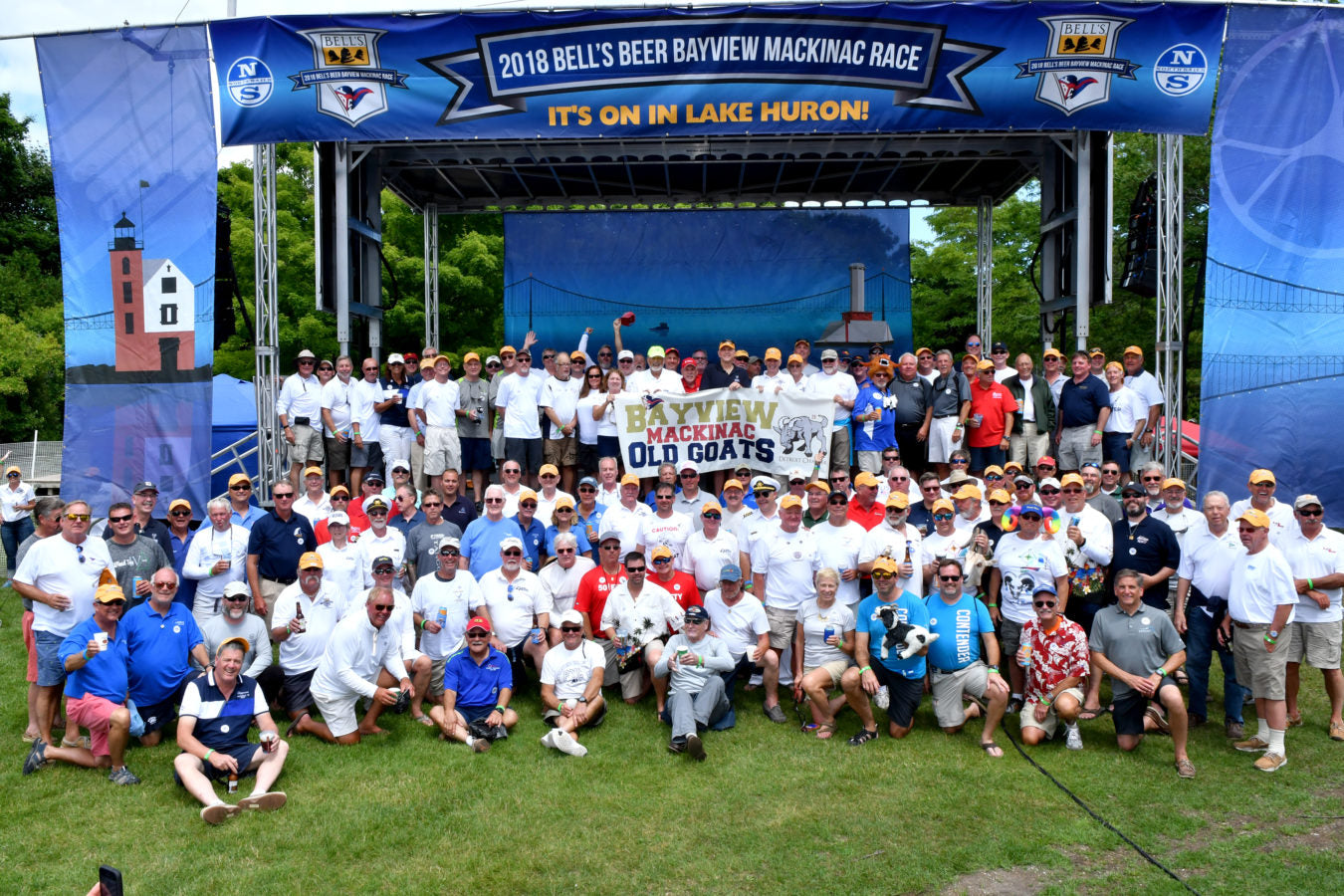
BAYVIEW MAC STRATEGY WITH KARL KUSPA AND BILL GLADSTONE
BAYVIEW MAC STRATEGY
Tips on Sail Selection, Routing and More for Upcoming Bayview Mac
© Martin | Photoelement
On Thursday March 14th, North Sails Detroit finished up their Winter Seminar Series with a stop at Bayview Yacht Club. Once again Bill Gladstone from North U was the featured speaker with Karl Kuspa from North Sails Detroit joining him to discuss Bayview Mac Strategy, Sail Selection, and Routing. North Sails and Bayview Yacht Club are pleased to be partners for this event and the Bell’s Beer Bayview Mackinac Race.
“When you partner with the best everybody wins,” said Commodore Sandy Fullerton of Bayview Yacht Club.
Commodore Fullerton goes on to say “North Sails shows up bringing the brightest and the best. They pack your house! Everybody gets charged up. You learn something new, confirm what you know, shake off the winter and get jacked up about Sailing! Thank you North Sails.”
With a full house of 150 people on hand it is easy to understand the enthusiasm. Sailors traveled from across the entire region to attend this two hour event. “Attending the recent North U seminars at BYC was amazing. As the Race Chair, I was particularly pleased to see the area’s that attendee’s came from. We had racers from Buffalo NY, Cleveland OH, Chicago IL and Toronto Canada. It was great to witness this kind of interest from other sailors working to hon their skills for the upcoming sailing season and 2019 Bell’s Beer Bayview Mackinac Race” states 2019 Race Chair Bob Nutter.
© Martin | Photoelement
The three seminar series was a first for North Sails Detroit with the first two events being held at their new loft. “With the way our loft is laid out, it is a no brainer for us to host events like this.” says Loft Manager Karl Kuspa. “Throughout my entire 30 years in the marine industry I have always tried to give back. I am just happy that I work for a company that allows us to continue to do so.” In all, over 300 people attended the three events covering topics such as sail trim, tactics and of course, the Mackinac Race.
While most people have their thoughts towards Summer, North Sails Detroit has already started the planning process for next Winter's Seminar Series. We have a lot of ideas for next year. It is going to be great!
READ MORE
READ MORE
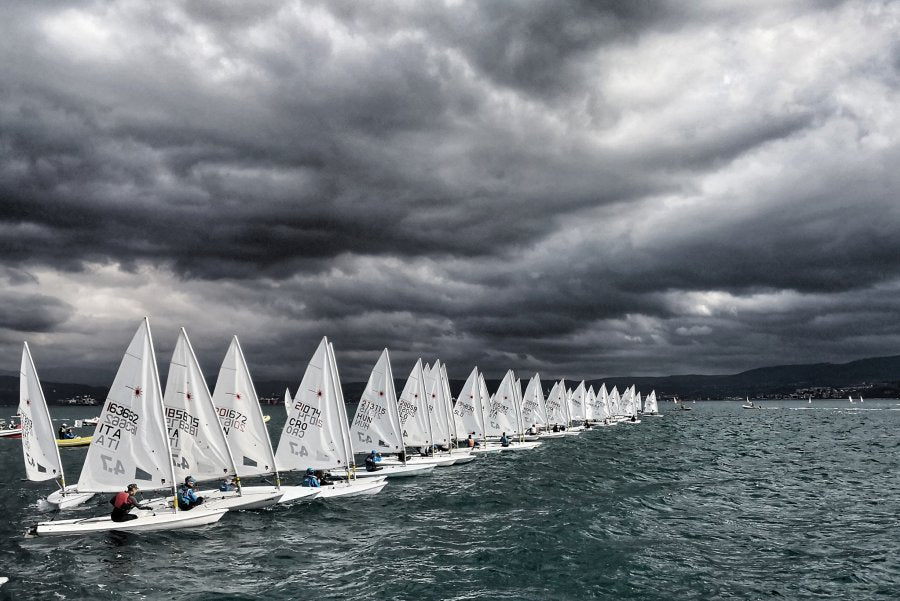
CRO JEDRA FENOMENALNA NA EUROPA CUPU U KOPRU
CRO JEDRA FENOMENALNA NA EUROPA CUPU U KOPRU
foto: Franjo Jurić
Čak pet medalja na tri postolja u generalnom plasmanu su hrvatski jedriličari donijeli iz Dežele! Sve tri kategorije klase Laser su zastupljene u ovoj brojci, a riječ je o prvoj ovogodišnjoj regati iz ciklusa Europa Cupa.
Pa da krenemo po redu:
Laser Standard - ukupno 24 natjecatelja:
- Mario Novak (JK Split, Split) - 1. mjesto generalno
- Marko Smolić (JK Val, Šibenik) - 2. mjesto generalno i 1. mjesto U21
- Dominik Perković (JK Labud, Split) - 2. mjesto U21 i 4. mjesto generalno
- Juraj Radačić (JK Val, Šibenik) - 1. mjesto U19 i 15. mjesto generalno
- Lukšić Antonio (JK Opatija, Opatija) - 2. mjesto U19 i 20. generalno
Laser Radial - ukupno 88 natjecateljki i natjecatelja:
- Karmen Perković (JK Labud, Split) - 1. mjesto generalno i 1. mjesto U21
- Roko Copić (JK Val, Šibenik) - 3. mjesto generalno i 2. mjesto U19
Laser 4.7 - ukupno 101 natjecateljka i natjecatelj:
- Ursula Balas (JD Val, Crikvenica)- 1. mjesto generalno i 1. mjesto U18
- Nika Manestar (JD Val, Crikvenica) - 2. mjesto U18 i 4. mjesto generalno
Ovako velik broj natjecatelja je izgleda pozitivna posljedica promjene sustava bodovanja. Ranije se koristio sustav koji je u obzir uzimao i nacionalne regate u pojedinim državama, pa su se koristili koeficijenti u kojima je značajan element bio i broj sudionika na njima, pa su u konačnici najviše profitirale države s velikom bazičnom flotom poput Italije, Francuske, Njemačke. To je bilo vrlo nepovoljno za one s manjim brojem jedriličara u klasi, pa je zbog toga jedno vrijeme Europa Cup gubio na popularnosti.
Sadašnji sustav boduje vrednuje samo regate Europa Cupa i to na način da se uzimaju po tri najbolja rezultata. Posljedica je da se prije održavanja natjecanja poput Europskih i Svjetskih prvenstava dobije mnogo realnija slika o formi natjecatelja, a i općenito o očekivanjima na tim velikim regatama. A kako je Hrvatska domaćin jednoj od regata iz ciklusa, kao što je i postojanje nekoliko regata u susjednim nam državama, to je odlična prilika za mlade natjecatelje koji tek stupaju na međunarodnu scenu da na njima skupljaju iskustvo natjecanja u velikim flotama.
U tri dana regate standardi su uspjeli odjedriti 5 plovova, dok su radiali i 4.7 odjedrili po plov manje. Lako razumljivo s obzirom da su ove dvije skupine zbog broja jedriličara bile podijeljene u po dvije grupe.
Vrijeme ih nije posebno mazilo, jednako kao što ni na ostatku sjevernog Jadrana vrijeme nije bilo baš bajno za jedrenje. U isto vrijeme se u Opatiji trebalo odjedriti Prvenstvo Hrvatske za klasu IOM, ali nisu imali nikakve sreće s vjetrom. Za to vrijeme na srednjem i južnom Jadranu je puhalo umjereno i jako jugo.
Ali prepustimo riječ treneru šibenske ekipe, inače tajniku juniorskih klasa, Teu Piasevoliju:
Kopar je područje u kojem su uvijek prevladavali lagani vjetrovi, uglavnom sa zapada. Slična prognoza je bila i za ovu regatu, lagani zapadnjak i jugo u dolasku. A s druge strane jugo u Kopru nije baš dobra prilika zbog geografskog položaja. Ne puše paralelno s obalom kao kod nas, već na svom putu nailazi na Istru preko koje treba prijeći, pa se ne uspijeva probiti. Tako da je to jugo tamo specifično, promjenjivog smjera, rupičasto, različitih pritisaka na različitim mjestima regatnog polja. U tim uvjetima je ključ ostati stabilan, održavati koncentraciju i izdržati to u glavi. Ovaj put je dodatna otežavajuća okolnost bilo i to što se prvi dan nije napravio niti jedan plov, a drugog dana samo jedan plov po termičkom zapadnjaku. Tek trećeg dana je prevladalo jugo koje je imalo snagu oko 5-6 čvorova, pa do refula od petnaestak čvorova. Na kraju se ipak uspjelo napraviti 4 i 5 plovova, jer je vrlo važno imati odbacivanje u takvim uvjetima jedrenja da bi se dobila što realnija slika. Ja sam super zadovoljan nastupom mojih jedriličara. Marko, Juraj i Roko su mladi i u naponu snage, a ovaj rezultat im je došao kao vrlo lijepa nagrada za naporne treninge koje smo imali tijekom ove zime. A što se tiče hrvatskog jedrenja mogu reći da smo apsolutni pobjednici ove regate jer smo odnijeli pobjede u svim kategorijama! Mislim da program rada sa sustavom kampova i zajedničkim treninzima svih laseraša pokazuje svoje rezultate. Npr. u Radialu je vrhunski doživljaj vidjeti da u jednom plovu u grupi pobijedi Copić, onda idući plov pobijedi Bruno Gašpić, pa plov odnese Božo Golubić... stvarno vrhunski za gledati to sa strane. A opet, iza jedrenja svi dolaze jedan do drugog i sportski i prijateljski čestitaju jedni drugima. Mišljenja sam da tako trebamo nastaviti i dalje i da se naši jedriličari još više zbliže, zajedno treniraju. Uvjeren sam da je to jedini način da naši jedriličari ostanu u vrhu i budu među najboljima u svijetu. Ako se zatvorimo u sebe i svatko krene individualno trenirati imat ćemo regate samo između nas samih a to nigdje ne vodi.
Teo Piasevoli, JK Val - Šibenik
U Laser Standardu bodovna situacija je bila takva da su se već od starta naša tri jedriličara našla na vrhu. To su bili Mario Novak, Marko Smolić i Dominik Perković. Između njih se još ubacio i slovenac Matej Valič i samo su nijanse odlučivale. Najbolji primjer je da su Novak i Smolić nakon 5 jedrenja imali jednak broj bodova, a odlučilo je to što je Novak uknjižio jedno prvo mjesto, dok je Smolić samo imao dobar bodovni skor, a da bi drama bila još veća do uspoređivanja rezultata na taj način je došlo u posljednjim metrima posljednjeg plova:
Uvjeti su bili baš teški i stvarno je bilo teško održavati konstantne rezultate, pogotovo u nedjelju. Vjetar je mijenjao smjer doslovno po stotinjak stupnjeva. Svaka orca je bila drugačija, ali često sam jedrio u Kopru pa sam očekivao takve uvjete i odluke Regatnog odbora da će puštati regate po svemu. Tako da sam bio spreman na to i to sam pokazao tog posljednjeg dana regate. Koncentracija mi je bila na odgovarajućoj razini u cijeloj regati. Posebno mi je drago što sam značajno popravio starteve. Na svakom startu sam se uspio pozicionirati u vodećoj grupi i tijekom jedrenja ići naprijed u poretku. Jedini kiks se desio u zadnjem plovu kad smo se zadnju orcu spojili s flotom Lasera 4.7. Taj plov sam bio vodeći i kad smo se spojili s tom drugom flotom ostao sam u vakuumu između dvije jedrilice i tu su me dvojica uspjela prestići. Moram pohvaliti i konkurenciju. Znao sam da je Dominik po ovim uvjetima vrlo opasan, Mario je isto bio vrlo konstantan, samo je jedan plov loše otvorio ali mu se to na kraju odbacilo. A zadnji dan je Valič napravio dva prva mjesta i dodatno zakomplicirao situaciju na vrhu.
Marko Smolić, JK Val - Šibenik
Osim spomenutih jedriličara u ovoj grupi treba spomenuti i solidan nastup Jurja Radačića i Antonia Luksića, najmlađih jedriličara u floti Standarda.
U floti Laser Radiala Karmen Perković je bila neprikosnovena. Izuzevši drugi plov (koji se odbacio), do pobjede je došla s jednim trećim mjestom i dvije pobjede. Koliko je dobro jedrila govori i podatak da je ona u kategoriji U21, a u floti je bilo i vrlo iskusnih seniorki.
Na drugom mjestu je završio finski jedriličar Otto Dahlberg, a na trećem mjestu član JK Val iz Šibenika, Roko Copić:
Bili su dosta zeznuti uvjeti. Prvog dana nismo jedrili jer je bila bonaca, a drugog dana jedva jedan plov. Polje je tada bilo vrlo teško. Vladali su različiti pritisci na različitim mjestima, a tek trećeg dana po dosta težim uvjetima uspio sam biti konstantan i dobro jedriti. Konkurencija je bila vrlo jaka. Svatko je mogao naći uvjete koji su mu odgovarali, od teškaša pa do laganijih jedriličara. Karmen je regatu vrhunski odjedrila. S njom sam zadnji dan bio u istoj grupi. Prvi plov dana kada sam ja pobijedio ona je otvorila 17. mjestom, ali je nakon toga složila dvije pobjede za redom. Bila je stvarno konstantna na čelu flote i stvarno je zasluženo prva.
Roko Copić, JK Val - Šibenik
A među najmlađima, u inačici 4.7 jedrilo je čak 20 CRO jedara. Slično kao i na hrvatskim regatama, najbolja je i ovaj put bila Ursula Balas, a klupska joj je kolegica Nika Manestar završila na 4. mjestu s jednakim brojem bodova kao i trećeplasirani talijan. Koliko je matematika nemilosrdna pokazuje detalj da je Nika, nakon odbacivanja, na četvrtom mjestu završila samo s trećim mjestima.
Zato je Ursula imala lakšu jednadžbu i do pobjede dolazi s dva prva mjesta i jednim drugim.
Naš najbolji momak u skupini bio je Luka Vuković (JK Labud, Split) s 8. mjestom u generalnom poretku. Ostali naši juniori su se većinom ravnomjerno rasporedili po ljestvici.
Slijedeća regata Europa Cupa se jedri u Švicarskoj u Luganu.
READ MORE
READ MORE
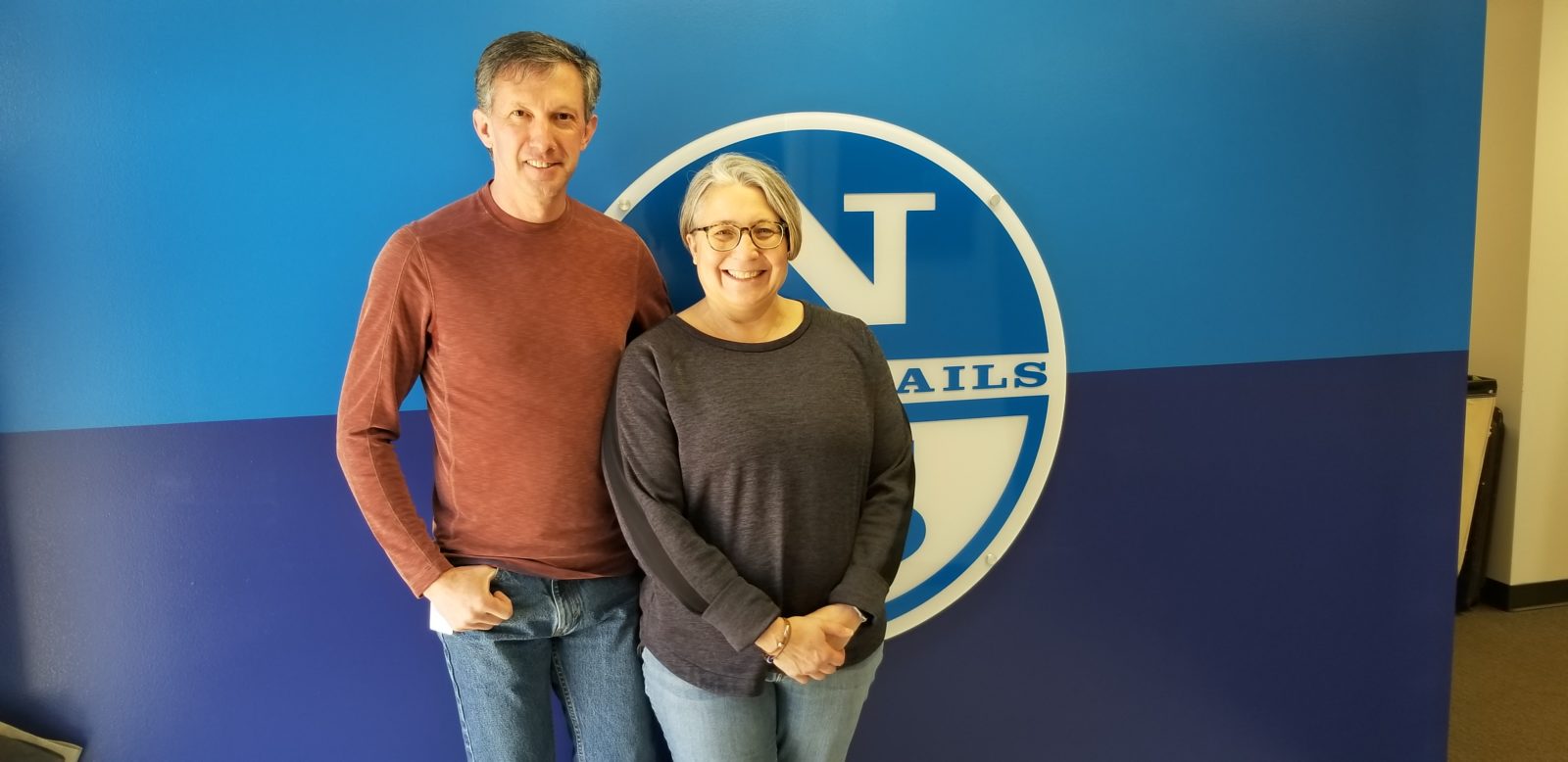
THE WILD GOAT ADVENTURE
THE SCURRS AND THE WILD GOAT ADVENTURE
Dipping Their Toes Into The Cruising Lifestyle
We caught up with our clients, Shari and Robin Scurrs to hear about their cruising adventure down in the BVI's and how this is just the beginning of their lifelong dream as live-a-boards.
What inspired you to start cruising?
Shari: Robin’s brother owns a 36 ft Beneteau, which was apart of a charter program in the BVI's, not having any clue, never ever been on a sailboat. After that we started sailing yearly with Robs brother in Puerto Rico. One of the last trips, New Years Eye, had gone to a small island in Belize.
They started chatting with the boat next to them and end up meeting husband and wife couple that live on the boat. Where ever they go, next town, next country, the whole sailing community ends up there too. There is this sailing community of live a boards up and down the Caribbean.
Robin: After that night, Shari started on this idea; "Hey, we could do this more," and that was five years ago. People thought we were talking garbage and didn’t think we could pull it off.
What steps are you taking to prepare for this journey and what kind of resources will you be utilizing in the prep stage?
Robin is in a position where he’s been in the schools for over 30 years - and he can now retire at 55. We can go anywhere; we have a home that we inherited in Florida, which we keep as a home base and we rent the property when we're not there. Between the pension and the condo, things kept falling into place for us to start living the cruising life.
Can you elaborate on your planned route? How did you decide on it? Sailing through the Apostle Islands then south along the east coast to a destination in Florida.
Robin: We’re planning on casting-off sometime in July, since I retire in June. We’re going to sail around various ports in Michigan and eventually get down to the Bahamas for next winter. I'll go due east until the temp starts to drop, and then turn right. From there, we'll head due south, depending on the winds, there's multiple places to check-in and make landfall.
Shari: In July, we're going to go up to the Apostle Islands and Lake Superior along the Pictured Rocks. From there we'll hit Isle Royal back down the channel in CA, lake Huron and the Georgia Bay Area, then eventually make our way out of the St. Lawrence Seaway.
What made you choose a 1981 S-2 11.0/36 ft, and why do you think it's ideal for your new cruising lifestyle?
We started our hunt for a boat with a short list; friends found a boat and recommended it. Well kept freshwater boat, kept in Lake Michigan, made in Holland, MI. Good solid fiberglass with no coring of any kind.
Robin: It was an older boat, and the couple that owned it had planned to live a board and had fixed the boat up on a budget. They added dinghy davits, they added solar, an inverter, and refrigeration. They refinished everything, and added a chart plotter and radar. It really had all that it needed for us.
The minute I went down below, I was done. What's attractive about it is it’s an older boat, it has all this wood.
This boat reminded them of Robin's brothers cottage - all wood. Shari commented, "I go below and I’m in my happy place. I’m at the cottage." They had never sailed it, but they bought the boat, a year ago in December. The boat purchase happened sooner than they had expected. They added AIS, changing the ports and using the additional budget to continue to outfit the boat. After much debate, they decided upon Wild Goat as the name due to Shari’s fondness to goats.
What is your background/experience in long distance offshore sailing?
Robin: We have no offshore experience other than watching other people on YouTube do it. They make it look like if you pick your routes and choose your weather wisely it’s not that bad. It’s obviously a very intimidating thing for the first time. People are afraid of it which is a perfectly valid response because obviously bad things happen to boats in the ocean. We have a wealth of weather information for help to do route planning and communications options that simply didn’t exist even 20 years ago, so I’m not terribly concerned, but it is something new for us and will be learning experience.
What led you to the Detroit team of North Sails to inspect and repair your sails in preparation for the trip?
Shari saw the North Sails logo on one of the sails that came with the boat and did a web search. She found North Sails Detroit and filled out an online request form. She knew North was a big company with a good reputation. When we called her back she was impressed with how we took the time to answer all of her questions. On her first visit to the loft, she was greeted with a tour which left a good impression on her. She said she felt like we treated her like family from the first phone call to the completion of the service work on their sails. Not to mention the mutual connection loft manager Karl Kuspa had with a good friend of hers associated with Two-Hearted Ale.
How long do you anticipate this trip lasting? What are your plans once you arrive at your destination?
Shari has big plans. She is eyeing up the many maps she has plastered on her walls with places like Bimini and the Galapagos circled. Robin is helping with the logistics aspect. She is very optimistic about making it to many far flung places. Robin has to remind her about the logistics aspects, but won’t rule out any ideas right away.
What is the biggest motivation that keeps pushing you onward to make this happen?
Robin: There is that magical moment when you pull out of the slip, or wherever it may be, and you head out and turn up and you raise the sails, fall off and get the boat propelling under there, and then you turn the engine off. It’s the magical moment where it's just the sound of the waves and the wind and the boat moving, it's like silence and it's calm.
Shari: I wanna say by sailing you’re not flying into an airport, you’re not being taken to the touristy areas. When you come in on a sailboat, you come in to the same place that the fisherman do. You're immediately gonna see the local part of it…the real stuff. You open yourself up to really seeing what a place is about. Traveling by a boat, you are just automatically a couple steps ahead. We love to travel and the adventure that comes from being on the road.
READ MORE
READ MORE
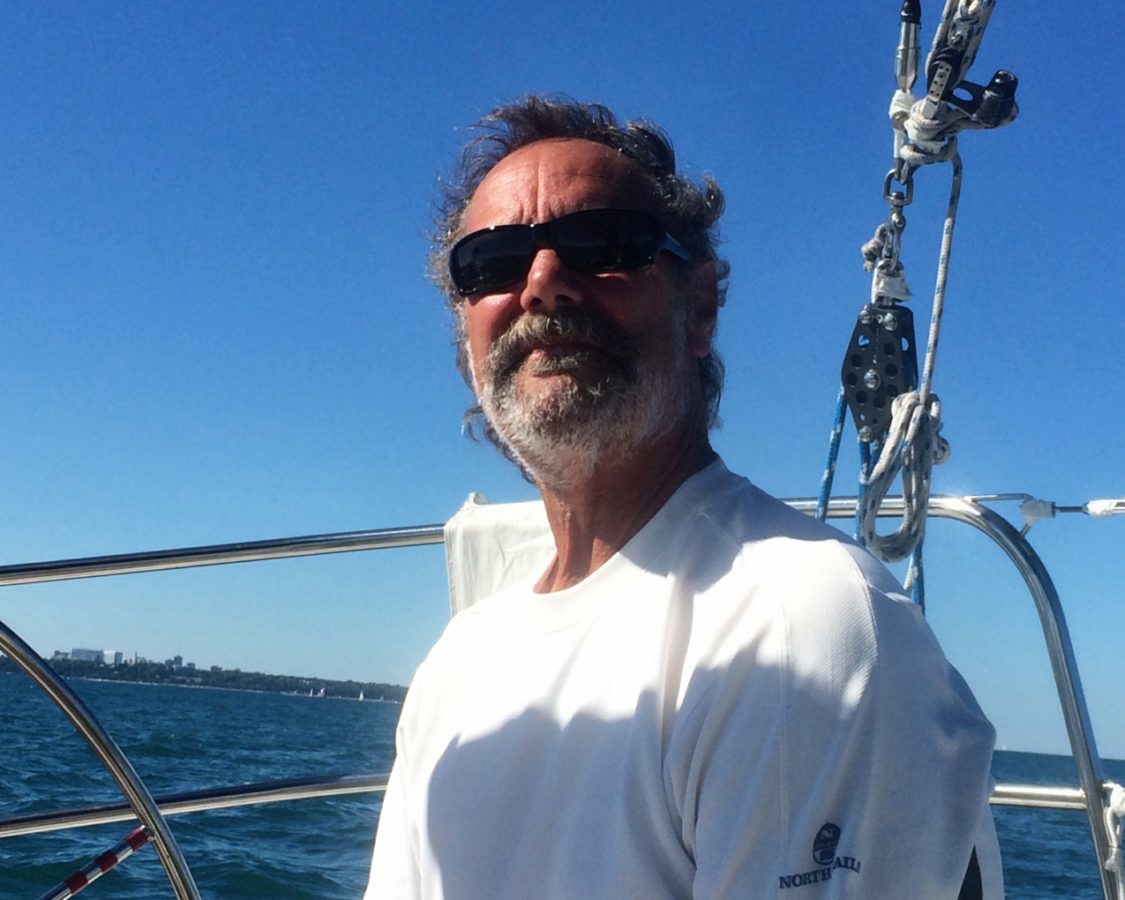
WHO WE ARE: TOM PEASE
WHO WE ARE: TOM PEASE
Get To Know Your Local Sales Expert
How long have you been sailing? What classes do you compete?
I was introduced to sailing when my dad bought his first boat, a Flying Dutchman, when I was about five years old. I really started to get involved when he moved up to a 26 ft keel boat and joined the local yacht club and started racing on the weekends and in the Wednesday night beer can series. Going through the club’s Jr program, I sailed and raced many different single handed and crewed centerboard and keel boats.
What boats/classes do you sail?
As a Jr we had access to and raced Butterfly’s, Lasers, Flying Juniors, 470’s, Lightnings and International 210’s. As part of the North Sails team, my focus had been primarily offshore racing on the Great Lakes in MORC, PHRF, ORR (and IOR back in the day) and one design offshore classes.
What got you into the marine industry and what do you like about it?
North Sails Midwest was our local loft and one day I walked in and asked for a job to make some money to go to school. I started as a shipper and worked my way through the ranks of handwork, service manager, designer, and sales. The new challenges always kept the job fresh and there were plenty of opportunities to learn from the talented North Sails team. Because of the connections, I've had the chance to sail with numerous clients on many different boats across North America- which has been quite rewarding.
How long have you been working in the industry? What keeps you coming back for more?
I’ve been in the industry for nearly 40 years, starting in the 70’s in boat yards and at North Sails. I took a 10-year break from 1995 – 2005 to see what the ‘real world’ was all about. I discovered neckties and suits were not my thing and rejoined North Sails where I get to work with clients that are passionate about their hobby and the sport.
What's your favorite aspects about sailing?
There’s no one single answer to this question; If it’s cruising with my wife, it’s the freedom and relaxation of going with the flow and throwing a timeline out the window. When I’m racing it’s the competition and working with the team to show our best for the day or event, and the satisfaction of coming into the dock and being able to say we gave it our all and it was pretty good.
READ MORE
READ MORE
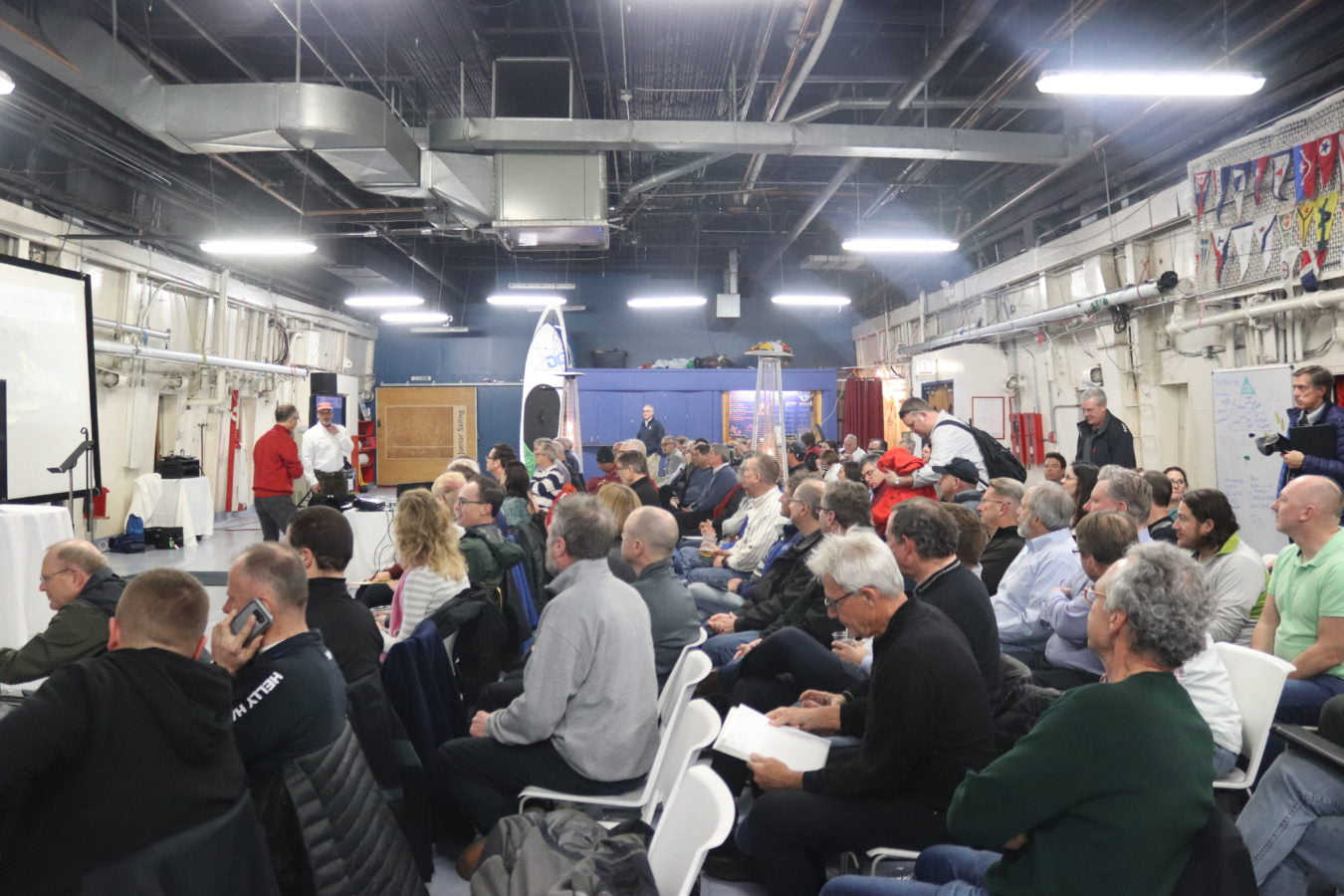
CHICAGO MAC STRATEGY WITH PERRY LEWIS AND BILL GLADSTONE
CHICAGO MAC STRATEGY
Perry Lewis And Bill Gladstone Of North U Share Advice For The Chicago Mac
The lake was still frozen in patches around the old ice breaker home of Columbia Yacht Club. Our Midwestern sailors can't wait for winter to be over, and 120 of them trekked out for this sold out race seminar. We had a wide range of experienced sailors attending and it was a great opportunity for all to dust off the snow and salt in anticipation for the 111th CYC RACE TO MACKINAC - JULY 13, 2019.
Continuing our North U. winter seminar series, Perry Lewis and Bill Gladstone hosted the Chicago Mac Strategy seminar at Columbia YC last Wednesday. Perry shared his 40+ years of knowledge and expertise of racing the Chicago Mac and Bill took us through the very useful routing software, Expedition, to plan strategy for a race like the Chicago Mac with his many years of experience also racing this one-of-a-kind event on Lake Michigan.
Want to make sure your sails are ready for the race? Connect with our team from the Chicago loft to see how they can help you and your sails be race ready!
READ MORE
READ MORE
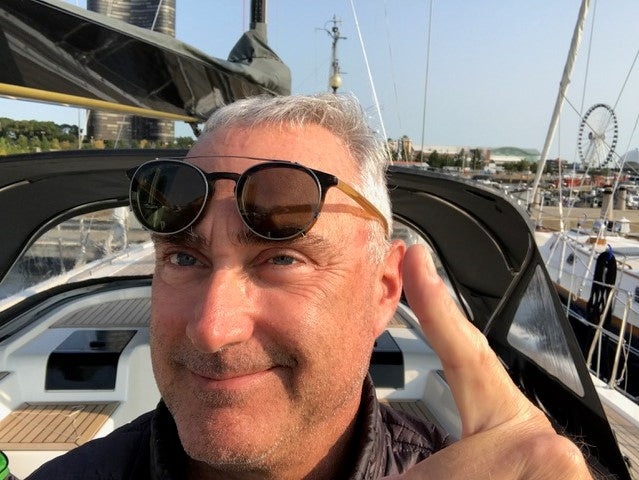
WHO WE ARE: KEITH CHURCH
WHO WE ARE: KEITH CHURCH
Get To Know Your Local Sales Expert
What background do you have in sailing?
I learned how to sail a Sailfish and Sunfish in Barrington Rhode Island. As a boy I was fortunate to be able to go to sailing camp at Camp Monomoy on Cape Cod. While in High school, I built a 110 foot Sloop, “The Sloop Providence”, in Portsmouth, RI. While in college I sailed on the Black Pearl, Barclay Warburton’s H-Brig Schooner out of Bowen’s Wharf in Newport RI. Mr. Warburton assigned me to civilian crew; sailing the Coast guard Ship the Eagle out of Groton, CT to the port of Baltimore, MD.
What boats/classes do you sail?
I have sailed in PHRF regattas on many boats, my favorites being the Express 37 , GL70’s, and most recent enjoyed cruising on an XP 55 out of Chicago. I’ve always enjoyed the level of competition of One Design sailing on Penguins. I have raced on J/Boats, Sydney 38s, Farr 40s, Farr MUMM 30s, and more.
What got you into the marine industry?
When I was very young I would go to the boat yard in Barrington, RI and hang out in the ship’s store glazing over the shinny marine hardware and listening to the stories being told by the old salts. While in grade school I built models of hydroplanes. In high school I built, during the summer, a 110 foot Sloop, “The Sloop Providence” in Portsmouth RI. I started boat shows in Chicago in the mid 80’s and managed the Ship’s Store in the largest boat yard in the Midwest. A number of years ago I helped bring the 33’ daysailer; the e33 to market.
How long have you been working in the marine industry?
I've been in the industry for 45 years, and I've been selling sails for 10 years.
What do you love most about sailing and what keeps you coming back?
At first I was driven by the idea that I could move anywhere and do this kind of work. I felt like I had something to offer and contribute to this industry by making old technology products more desirable or by bringing new products to market. Ultimately, my goal is just making our customers happy with the best available options, which is North Sails. The people keep me coming back. I enjoy the interaction on the boat whether I am learning or teaching someone else, or competing for the prize.
READ MORE
READ MORE
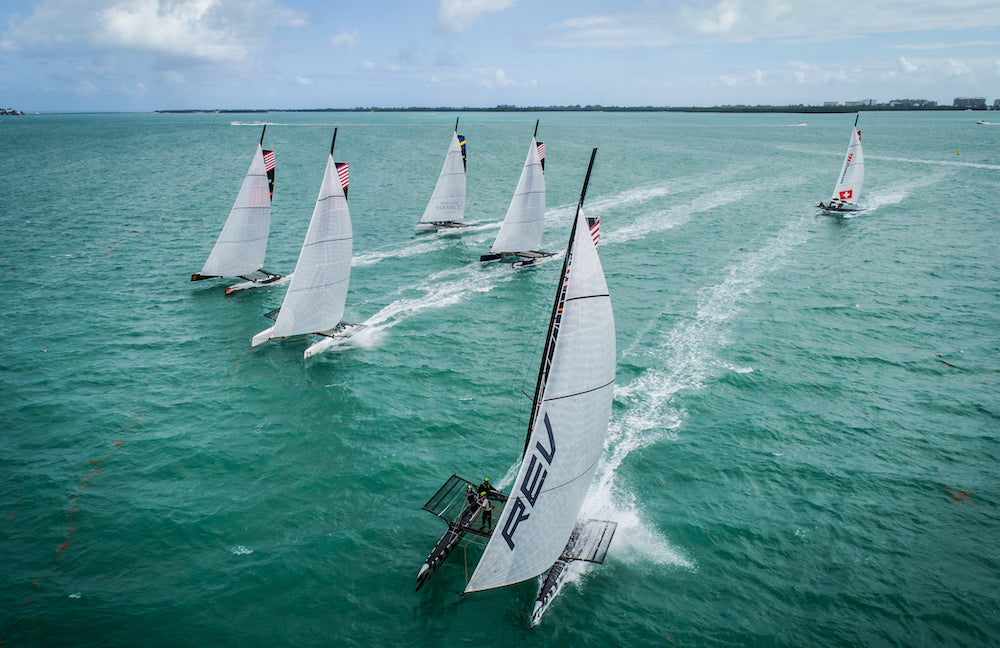
M32 SAILING IS HEATING UP
M32 SAILING IS HEATING UP
The Road To The Worlds Is Always Exciting In These High Adrenaline Cats
📸 M32 World / Felipe Juncadella
Eight M32s will meet in Miami for the fourth and final event of the 2019 class Winter Series. A single point separates the top two boats, who have their eyes on the “Rooster” series trophy.
After Miami, M32 seasons are heating up on both sides of the Atlantic. In North America, the fleet will compete at Charleston Race Week before heading north to Newport, Rhode Island, for the NYYC Annual Regatta, the inaugural Midtown Cup. Meanwhile, the European fleet will start their season with two regattas in Italy before heading north to Holland and Sweden. Both European and North American seasons culminate with the 2019 World Championship in Riva del Garda, Italy at the end of August.
The M32 is a fast, fun, one design catamaran class. Designed in 2011, this dynamic class saw dramatic growth two years later when Aston Harald Composite, under the leadership of sailing enthusiast Hakan Svensson, acquired design and production rights. Through his involvement with the Volvo Ocean Race, Hakan knew North was the right choice to supply one design sails for the class. Since 2014. North Sails have provided fast, consistent sails for the entire class.
📸 M32 World / Felipe Juncadella
“The North 3Di RAW mainsail has been an excellent product,” said Dave Doucett, Director of M32 North America. “It’s a great value because owners are delivered a fast, yet bombproof sail that is competitive for several seasons. Class sails are built to the exact specifications of the strict one design class rules.”
With an owner-centric mentality, the class has planned a sailing schedule that provides easy logistics to amazing sailing venues. Owners in both North America and Europe are able to hone their speed and boat handling skills during a full regatta schedule in global sailing hotspots, and also close to home with their local fleets.
A strong M32 fleet is expected on the start line at the 2019 Worlds. Located at the northern end of Lake Garda, Riva del Garda is one of the best-known yacht racing venues in the world. Northerly wind in the morning and the southerly Ora kicking in the early afternoon, combined with the funneling effects of the mountains, provide the perfect flat water, strong wind sailing conditions for these high-performance catamarans.
📸 M32 World / Felipe Juncadella
Throughout the 2019 M32 European Series, manufacturer Aston Harald will have two circuit boats available. The first will be loaned to a ‘development team,’ which might be a youth, women’s, or local team looking to try a professional racing circuit. The second will be a test boat for teams coming from monohull classes who wish to experience high adrenaline racing against a mix of pro and owner-driver teams. The M32 Europen organisers can set up potential owners and teams with M32 crew, as required: Contact Mattias Dahlström: mattias.dahlstrom@astonharald.com
In North America, potential new owners and teams will have the opportunity to test sail an M32 at the New York Yacht Club Annual Regatta (June 14-16) and The Midtown Cup (July 12-14) in Newport RI. Test sailing will also be available at the North American Championships in Miami FL (November 15-17). Contact Dave Doucett: dave.doucett@astonharald.com
For more about M32 sailing in 2019
Race Schedule | M32 Web | Facebook | Instagram @m32official
📸 M32 World / Felipe Juncadella
READ MORE
READ MORE
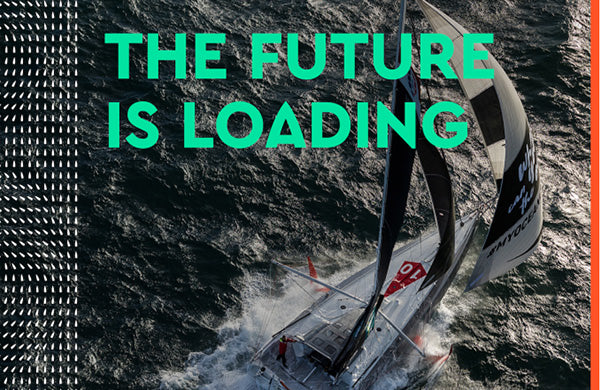
WATCH THE OCEAN RACE TAKE FLIGHT
Building on over 45 years of tradition and heritage, The Ocean Race is the world’s premiere, fully-crewed, around the world race.
Since the first Whitbread Round the World Race in 1973, through 20 years of the Volvo Ocean Race, this offshore classic has always attracted the world’s best sailors.
Now known as The Ocean Race, the next edition is set to start from Alicante, Spain in 2021, with two classes of boats: the fantastic, foiling IMOCA 60s and the one-design VO65s, which produced the closest race in history in the last edition.
To catch up on the latest developments and learn what’s been going on behind the scenes since the last race, join The Ocean Race for its online launch on March 21st at 1900 UTC.
Bookmark These Links:
Web | YouTube | Facebook | Facebook Live
READ MORE
READ MORE
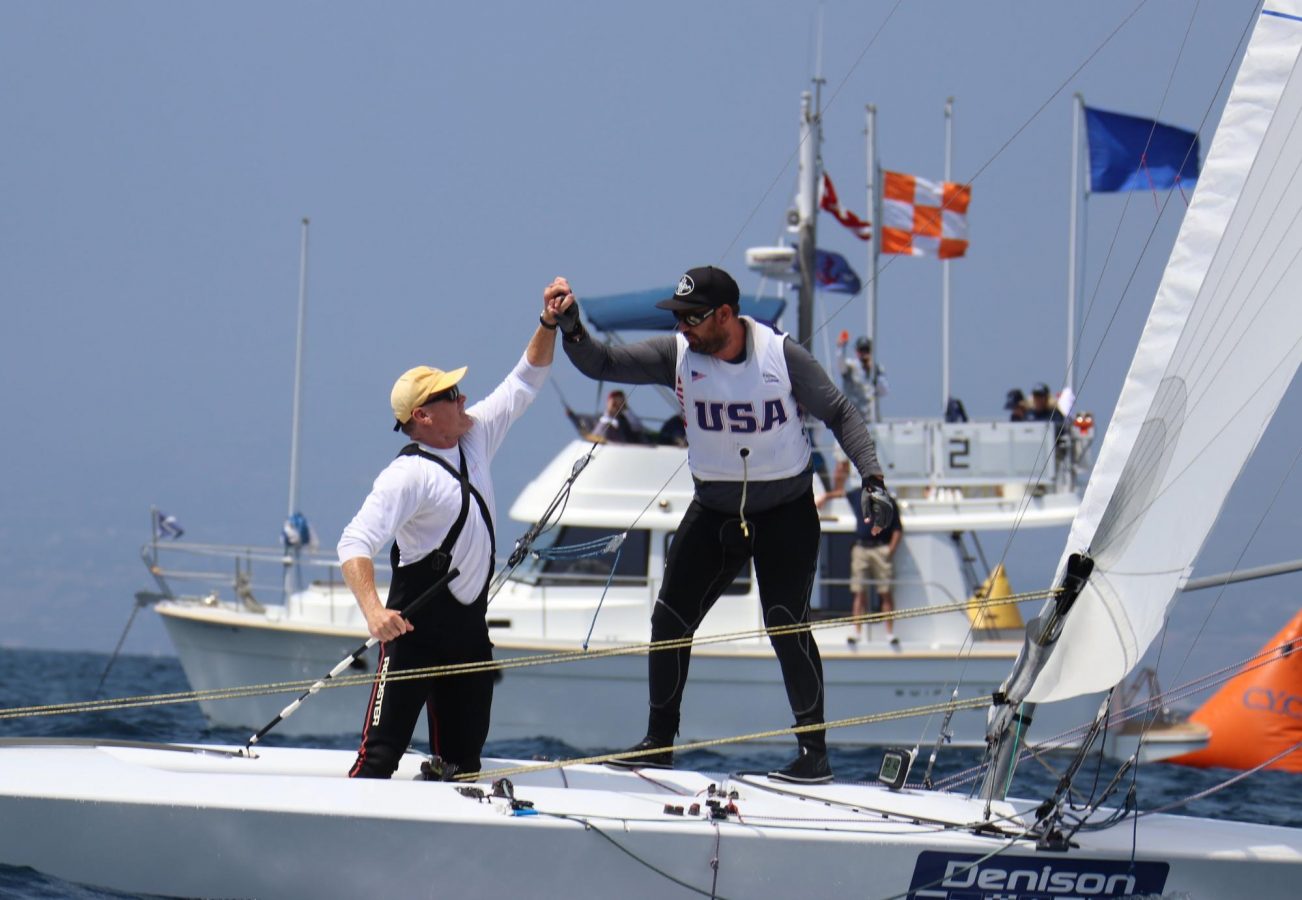
STAR CLASS LEADER ERIC DOYLE
STAR CLASS LEADER ERIC DOYLE
After Three Decades, Eric Keeps Coming Back To The Star
© Bronny Daniels
Even after almost three decades in the class, 2019 Bacardi Cup champion Eric Doyle thinks there’s still plenty left to figure out. “It’s the best platform for learning about sail shape and rig tune,” he says. “There’s quite a bit of pumping and kinetics involved. And there’s a bit of keeping the rig upright as well.” Combined, those challenges have kept him in the Star boat—and, between regattas, doing long bike rides to improve fitness and focus.
Eric started sailing as a kid on the Mississippi Gulf Coast, “Because it was so bloody hot you kind of had to be on the water in order to survive.” During college in Mobile, Alabama, he sailed Stars for the first time with the local fleet. “When I got out of college and was done racing small boats, I thought that the Star was just the coolest thing ever and started racing them.”
“When I got out of college and was done racing small boats, I thought that the Star was just the coolest thing ever and started racing them.”
That led to an Olympic campaign ahead of the 1992 Games, and that in turn led to an important phone call.“Vince Brun called me and said, ‘Hey, why don’t you come work for North Sails in San Diego, there’s a great Star fleet out here. I think it’ll help your career.’ So I packed up, pulled my Star boat out here, and started working for him.” In 1999, Eric won the Star World Championship and his first Gold Star. “129 boat fleet, that was a highlight for sure.” More recently, he and crew Payson Infelise won the 2018 North Americans. “We’re feeling pretty strong right now. So, hopefully we can continue rolling along.”
© Bronny Daniels
Since first starting at North in 1992, Eric has done some big boat sailing as well, including an America’s Cup campaign with Dennis Conner and two with Oracle. But in 2017 the opportunity came to return to the Star—and to San Diego. Now, as Class Leader for North Sails, he’s brought his Cup experience back to help improve one design sails. “It’s taken me two years to get the sails where they are now. We have made some nice improvements.” For 2019, North is offering a completely new Star product line.
As class leader, Eric is responsible for identifying the improvements he wants to make and communicating them to the design team. Then he tests the sails with a tuning partner to quantify if the changes worked. “We did quite a bit in the lead up to the 2018 North Americans,” he says. “And it all turned out pretty good. We were much faster in lighter air.” (For more about the process and results, read Star Sail Design R&D)
Eric’s plans for 2019 include two regattas in Europe: the Star Europeans on Lake Garda, and the Worlds in Porto Cervo. “We’re going to try and do those, and hopefully have a good result. And keep on in the fall after that.” Because even after thirty years in the Star, Eric knows there’s still plenty left to learn.
© Bronny Daniels
READ MORE
READ MORE
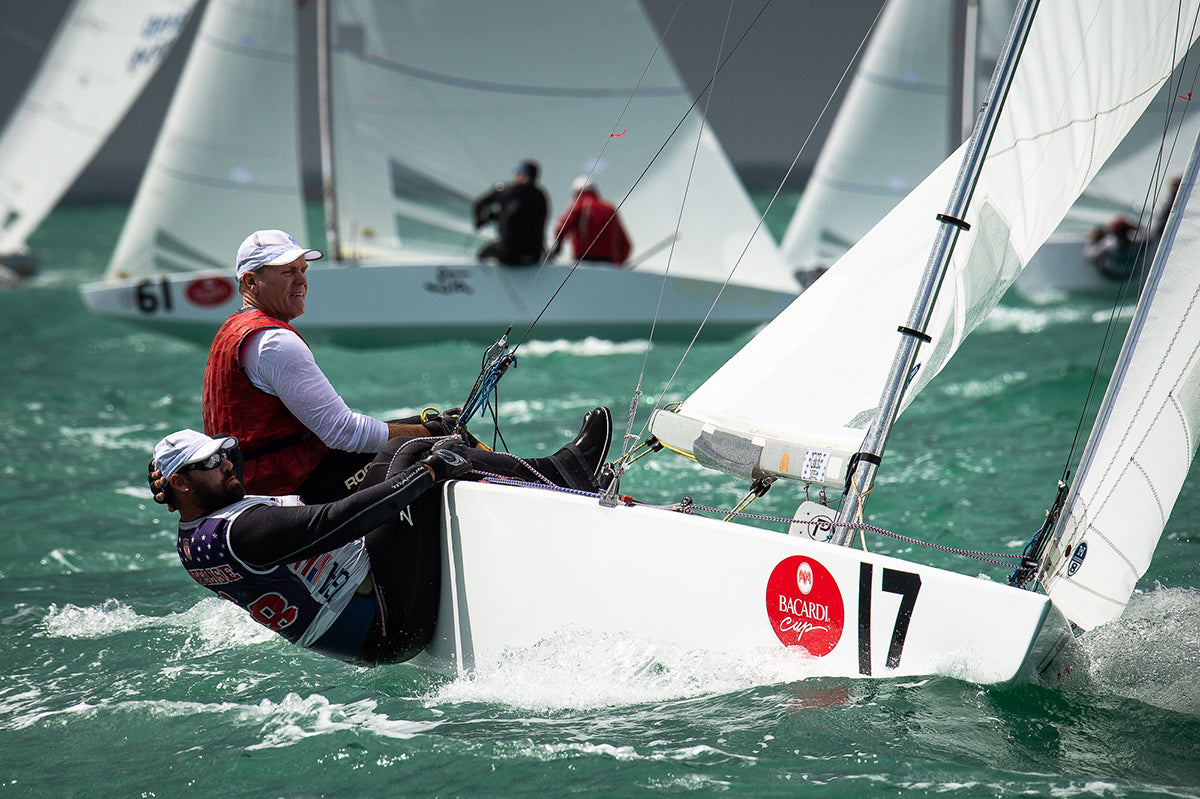
STAR SAIL DESIGN: R&D
STAR SAIL DESIGN: R&D
Upgraded 2019 Sail Inventory Explained By Eric Doyle And Mike Marshall
© Martina Orsini
North Sails has been making fast Star sails since the very beginning. “The first sail Lowell North made, was a Star sail,” 1999 Star World Champion Eric Doyle points out. “And we’ve been refining them ever since.”
As the Star Class Leader for North Sails, Eric devoted the past two years to figuring out how to make this hundred-year-old class go just a little bit faster. Recently he proved that was time well spent with a decisive win at the 2019 Bacardi Cup. “We were really pleased with our performance throughout the wind range,” Eric explains, adding that he used the new M-25 mainsail for the entire event.
“The mast section is quite small and the sail area is quite big,” he continues. “So small changes make a big difference.
“It’s such a great platform for learning what changes you can make and the effects they have on sail shape and boat speed.”
Matching Sails to Rig and Smoothing
After a few years away from the class to work with the Oracle America’s Cup team, Eric says it took more than a year for him and his crew to get back up to speed with the top teams. “The rigs are stiffer now. So they’re a little easier to control and they don’t break as often.” That meant sails had to evolve as well. “We’ve revamped the whole product line this year.”
North Sails designer Mike Marshall adds some detail. “We matched the luff curve to the new masts and made a couple other little design tweaks here and there to really up the range of the sails, and fix some issues they were having when they would trim too hard,” Mike says. “Certain areas would be closing, so we made a couple of tweaks. And then we made some panel layout changes.”
In addition to making the sails fit on a stiffer mast section, another goal was to reduce any bumps. “Aesthetically smooth sails are key,” Mike says. “So we made a couple of changes, especially in the jibs and some detailing. Such minor things that can really cause a problem, it’s impressive sometimes how small it can be. We worked hard on that.” Also, improvements in technology have made it possible for designers to reduce weight without threatening the sail’s structural integrity. “What if we don’t like the weight of the aluminum headboard?” Mike asks. “Can we put something in there that’s going to give the stiffening but be a quarter of the weight? How do we make that smooth? You’re making the sail as light as you can, without compromising the loaded structure.” And as Eric and Mike agree, all those little changes add up to a faster Star sail.
© Martina Orsini
Sail Testing
Sail testing done right—two well-matched boats, and a coach—is time-consuming, but it’s the only way to quantify improvement. First, says Eric;
“We have to do a lot of sailing to get as fast as the top guys and feel comfortable throughout the wind range, and with our settings. Then we have to identify our weak spots, and what we think the problem and/or solution is.”
An example is the stiff mast he was using when he stepped back into the Star two years ago. “We were pretty fast in the medium conditions, but when it got really windy, we struggled to make the sail flat enough. So, we analyzed the sails with a sail digitizing program, and compared them to what we had in the past. Then we changed the sail and went back out to find the same conditions.
“We had a big problem in really light air,” Eric continues, “and we really weren’t sure if it was the mast or the sails. At the 2019 Midwinters we changed both at the same time, something we normally don’t do, but we had a pretty good idea of what was needed. The sail was a little bit knuckle forward, so we reduced the luff curve a bit. The pictures and the coaching showed us that was the thing to do.” The result? “We were much faster in lighter air.”
Eric feels lucky to have John McCausland as a tuning partner. “He’s a great sailor, former world champion. We’ve been tuning together for 20 years. I don’t like to leave the dock without him, because we’re super-efficient. We know how to set up, and make changes, and wait for each other. And he shares everything openly, so it’s really great.”
Mainsail Design Details
The M-25 mainsail
“Our standard M-25 main, we had to get it to fit the stiffer mast and not give away too much on older masts that are more flexible. It is slightly flatter then the previous M-16 model, and it has a little tighter mid-leech with a bit more twist in the top. It’s a good all-around mainsail for the entire wind range.” The M-25 is the only mainsail Eric used to win the 2019 Bacardi Cup, though it’s not the only model available.
For the lighter winds of North America, there’s a North mainsail M0-5, made entirely of minimum weight cloth. “It’s a little more powerful to help get the crew over the side a little quicker, which is key in the Star. If you can get the crew over, you’re going pretty fast.”
Jib Design Details
All of the redesigned jibs are radial, which improves both longevity and wind range. “The J-115 Full Radial Jib really excels in flatter water,” Eric says, adding that it was their choice for most days at the Bacardi Cup. “It can sheet really hard for maximum pointing.”
On one of the light days in Miami Eric used the J-6 Wave Jib, which is better in bumpy water. “It powered through the big fleet chop with ease.” He recommends the J-6 for West Coast sailing, where they often get swell overlaid with chop. “It has more power down low and a wider entry angle to help make a wider groove when you’ve got to steer around the waves.”
There’s also a J-2, “for one of those days when you’re wondering if they’re going to send you out or not in 20 or 25 knots. It’s heavier cloth and full radial construction, and it’s quite fast. It’s really nice when you don’t want to destroy your light jib-which you can do pretty easily on a big breeze day.”
North has been winning Star world championships since 1957, so making already fast designs even faster takes a lot of effort. “We’ve improved what we felt was already pretty good,” Eric says. “It’s a lot of time and testing. But I think we made some nice steps this year.”
READ MORE
READ MORE
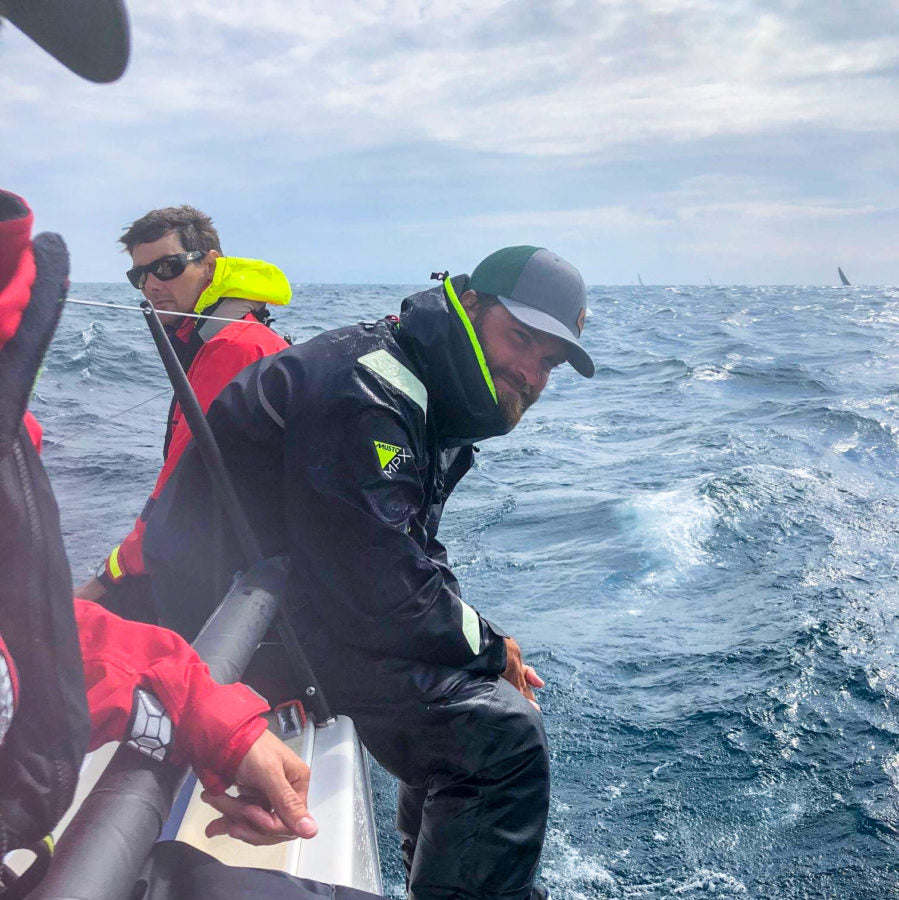
WHO WE ARE: BLAY SHOENHERR
WHO WE ARE: BLAY SHOENHERR
Get To Know Your Local Sales Expert
How long have you been sailing? In what classes do you compete?
Sailing has always been in my family and I started at at seven in the junior program at Grosse Pointe Club. By age nine, I was ready advance to a more serious program and joined the Bayview Yacht Club junior program where I raced competitively in Optimists, Flying Juniors, and 420s.
I joined the Grosse Pointe South Sailing team when I started high school and raced 420s all four years competing in both fleet and team racing. At the same time I raced actively in local Detroit fleets including, J/35s, Beneteau 36.7 (Multiple North Americans), J/120s, NA 40s, J/105s etc. I have completed 15 Port Huron Mackinacs (1 overall, 1 first in class, and 12 Chicago Mackinaws-with one first in class finish in 2018 in the J/111 fleet). Over the years I have race on many performance boats including, Ultimate 20s, Melges 32s, Melges 24s, TP52s, and Santa Cruz 70s. I currently am active in the Melges 24 class and 'll be racing a TP52 this summer in the Great Lakes circuit.
What's your background in the marine industry? What do you like about it?
I started working on race boats at age 17 and continued with various race programs in the summers through college. I currently work as a marine technician focused on sailboats and rigging at a local northern Michigan boat shop. My favorite aspect of working in the marine industry is the technology and the people. There is always something new to learn as the industry evolves. Being able to share my knowledge and solve problems with clients and the community is truly rewarding.
What keeps your coming back for more?
The competition and family nature of the sailing community keeps me coming back. Every time I'm on the water I learn something new.
What's your favorite thing about sailing?
My favorite thing about sailing is the camaraderie. It’s an amazing community and has rewarded me with lifelong friendships.
READ MORE
READ MORE
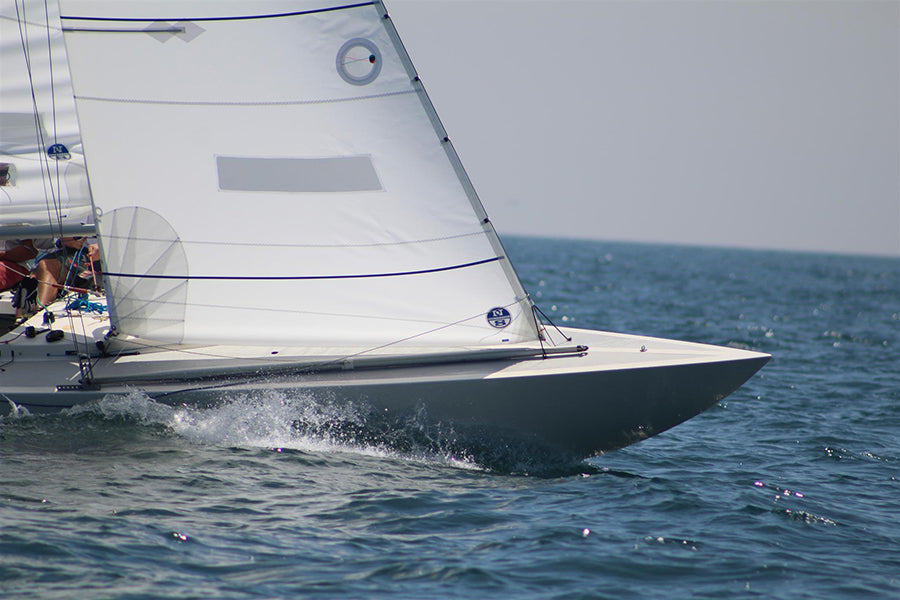
ETCHELLS SUCCESS FOR NORTH SAILS IN GEELONG
ETCHELLS SUCCESS FOR NORTH SAILS IN GEELONG
Top Of The Fleet Powered By North Sails At Victorian Championship Regatta
While the Etchells Victorian Championship regatta in Geelong, Australia last weekend brought mixed conditions, the results for Magpie, skippered by Graeme Taylor and his crew Richie Allanson and James Mayo, remained consistent. Finishing top of the podium, they won four out of six races, (placing second in the other two), followed closely by North’s own Charlie Cumbley in Tango with Chris Hampton and Sam Haines. Third was Jean-Claude Strong’s 1435, with Tom Slingsby, Marcus Burke and Kate Devereux crewing. Charlie Cumbley, Etchells Class Expert:
''North Sails light and heavy air jib designs proved their versatility and success during the regatta, handling well in a range of wind strengths, from 5 to 35 knots.''.
Visit our Etchells class page for the latest results, tuning guide and to contact your local expert.
READ MORE
READ MORE
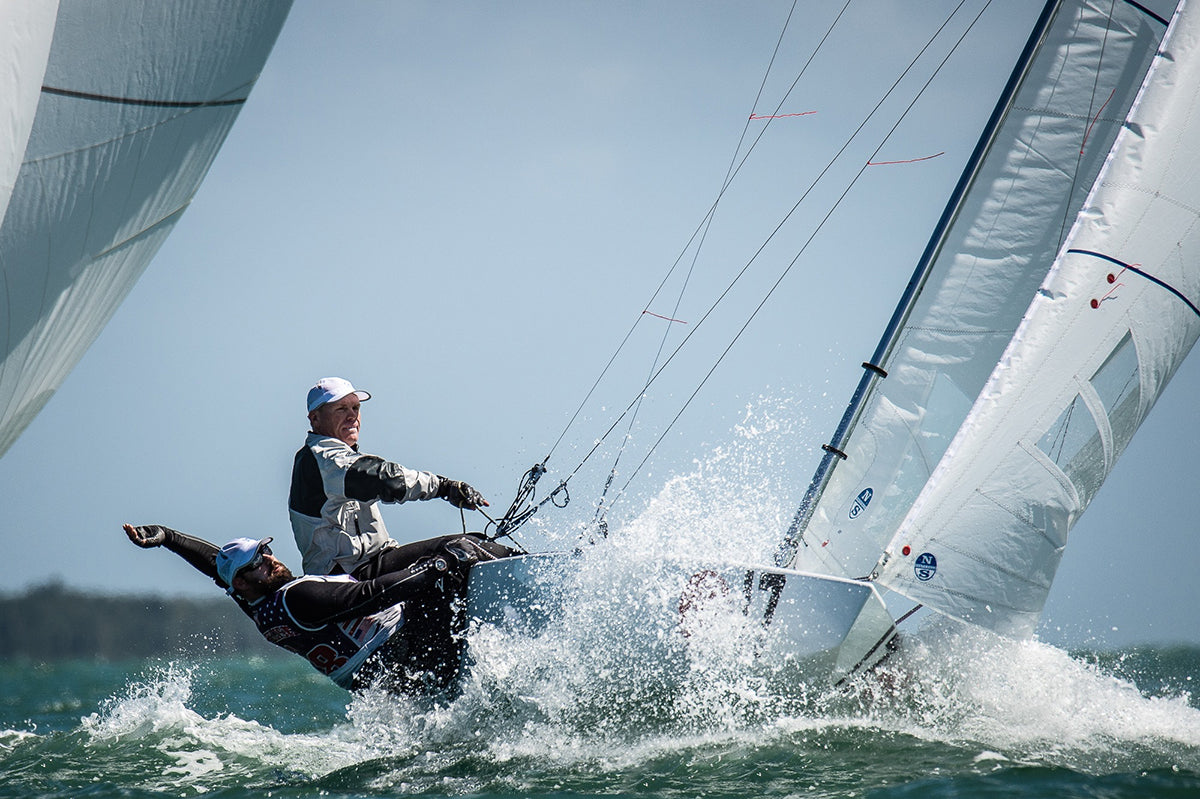
NEW STAR DESIGNS DELIVER IN MIAMI
NEW STAR DESIGNS DELIVER IN MIAMI
Eric Doyle Wins Bacardi Cup With M-25 Mainsail And J-115 Full Radial Jib
Eric Doyle and Payson Infelise, 2019 Bacardi Cup Champions. © Martina Orsini
Eric Doyle and Payson Infelise won the 2019 Bacardi Cup Invitational, beating out seven World Champions and multiple Olympic medalists by never crossing the finish line worse than fourth. Coral Reef Yacht Club and the beautiful Biscayne Bay host this prestigious event every year, and Miami did not disappoint; sailors had warm weather and great breeze almost the entire week.
THE RACING
Racing began on Monday with a shifty southerly breeze. Defending champions Diego Negri and Sergio Lambertenghi showed they were serious about winning again by decisively taking the first race. After a day off with not enough wind for racing, Polish Olympic champion Mateusz Kuszierewicz/Frithjof Kleen redeemed themselves from a first race OCS to take the gun in race two. Great breeze arrived Thursday, and the French duo of Xavier Rohart/Pierre Alexis Ponsot won a hard-fought victory in race three. Midway through the series, Doyle/Infelise hadn’t finished out of the top four and were leading the series by a nice margin.
On Friday, Paul Cayard and six-time Bacardi Cup champion Magnus Liljedahl really hit their stride and won races four and five by comfortable margins. Doyle/Infelise had not yet won a race, but with no finish worse than fourth they went into the final race with only Cayard/Liljedahl a mathematical threat for the championship. When they rounded first and spotted Cayard/Liljedahl uncharacteristically far from the leaders, Doyle/Infelise were able to retire early and enjoy a quiet victory sail back to the dock. Kuszierewicz/Kleen won a hard fought battle against the always fast team of Eivind Melleby/Josh Revkin, and those two teams filled out the other podium spots.
The Star Class is known to have a deep fleet of very talented sailors from all over the World ©Martina Orsini
THE CREW
A good crew is critical to winning Star regattas, and Eric says he’s lucky to sail with Payson. “We always have a good time on and off the water. He basically runs the show downwind. At the bottom, it’s just a basic question: do we go left or right? What do you like? And we go that way. It’s great to have someone to bounce ideas off of, and it’s almost always correct. We’ve been sailing together five or six years, so everything happens automatically with very few distractions. Anything goes wrong, it’s no big deal. We just move on.”
Eric and Payson celebrating after the final race. © Martina Orsini
LOOKING AHEAD
According to Eric, 2019 is going to be a really big year for the Star. “At the European Championships in Garda in May, there’ll be the traditional Star racing until the last day, and then the top ten boats go into a Star Sailors League knockout series. Then we have the Star Worlds in Porto Cervo, which everybody is excited about. I don’t think it’s unreasonable to expect 100 boats at each of those events.”
And the North Sails product line will be ready to perform. “We had 5-20 knots and we used one main the whole time,” Eric says. “I felt as fast as anybody throughout the whole wind range. Many customers commented on how well it worked in all conditions, easy to trim and set up and most importantly, fast. And that’s what we’re aiming for.”
The awards ceremony © Martina Orsini
READ MORE
READ MORE
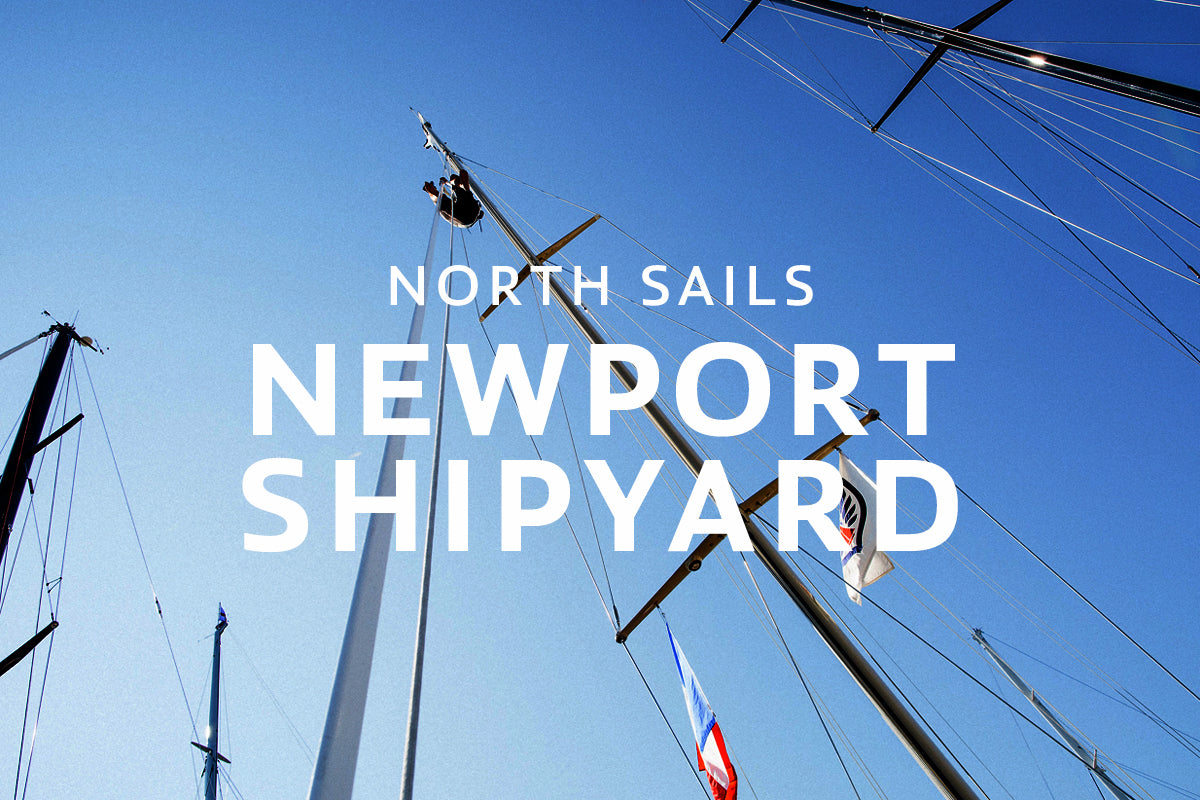
NORTH SAILS AT NEWPORT SHIPYARD
NORTH SAILS AT NEWPORT SHIPYARD
New East Coast Sales Office Opens May 1 In Response To Growing Demand
North Sails is pleased to announce the opening of a new sales office in Newport, Rhode Island. Located in the heart of the vibrant Newport Shipyard, the team believes that this location will give Grand Prix, One Design, Multihull, Cruising and Superyacht customers an easy and bespoke solution for all their sailmaking needs.
The new office will work alongside the expansive North sales and service center only 15-minutes away in Portsmouth, Rhode Island. As Newport Harbor and the surrounding area are hosting even more major events, many of which are based from the Shipyard, the new office allows clients easier access to a North Sails expert. They can also drop sails off, have them repaired and pick them up without ever leaving the Shipyard. Mike Toppa, a North Sails Superyacht specialist will head up the team. A two time America’s Cup winner, Toppa combines his vast knowledge of the industry, the players, and the products available across a broad spectrum of the market making him the perfect fit for this new venture.
Mike Toppa commented: “This office in the Newport Shipyard will be an advantage for our clients. It makes so much sense to enable them to drop in to talk about their needs and their sails in a place that is so easily accessible. We believe a drop-off and pick up point here eliminates a time-consuming step and makes it easier for our customers, and gives them more time to enjoy their sailing while in Newport. It’s hugely beneficial to be at the heart of where our clients are, to ensure that we continue to understand what they need, both now and also for the future.”
“This office in the Newport Shipyard will be an advantage for our clients. It’s hugely beneficial to be at the heart of where our clients are, to ensure that we continue to understand what they need, both now and also for the future.”
Ken Read, President of North Sails, added: “Newport is a dynamic sailing hub and where our global head office is also based. It is the right time to be offering this sort of service to our clients, with so much going on this summer in Newport, including the 12 Metre Worlds, the New York Yacht Club 175th Anniversary Regatta and so many other world-class events. Our vision as a company has always been to pair industry-leading products with unmatched client support. The Shipyard office reaffirms our commitment to provide the best possible service to all types of sailors. We look forward to seeing old and new customers, and also friends and colleagues over the coming months.”
READ MORE
READ MORE
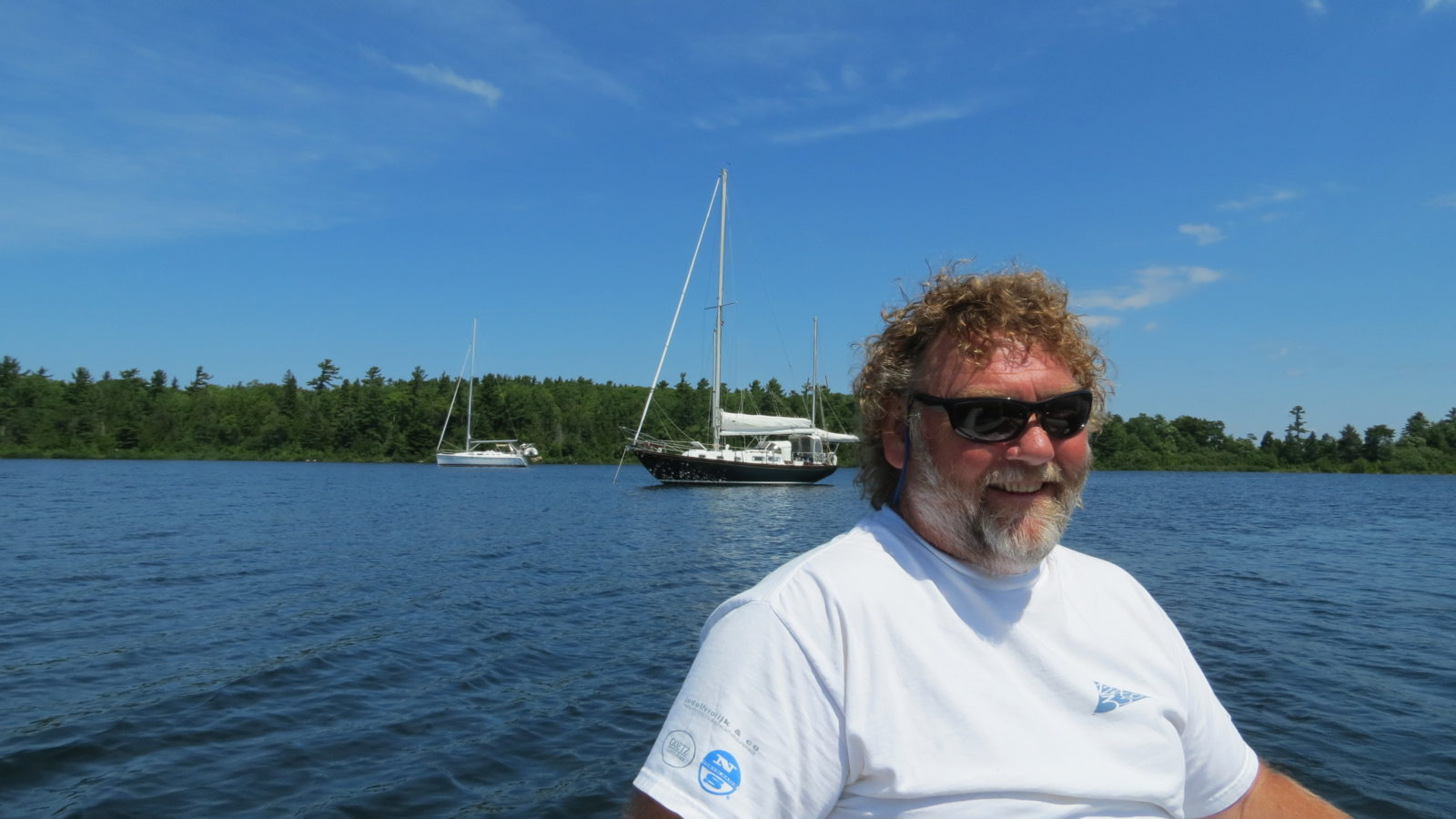
WHO WE ARE: JOE PARKER
WHO WE ARE: JOE PARKER
Get To Know Your Local Sales Expert
How long have you been sailing and what classes do you compete in?
I have been sailing for 40+ years. I have sailed in many PHRF events over the years on boats from 22' to 70'.
I have sailed in the IOR One-Ton NAs and Worlds. I've also raced Beneteau 36.7s, Catalina 22s, Tanzer 26s, J/24s, J/35s, International 110's, MORC and Great Lakes 70' fleet.
I have competed in five Key West Race Week events, a number of Harbor Springs regattas, more than 20 Bayview-Mackinac races, 15 Chicago-Mackinac races, three Ft Lauderdale to Key West races, six doublehanded Lake Huron Challenge races. I've also raced in multiple Detroit NOOD regattas and countless local PHRF races on Saginaw Bay and Tawas Bay. My wife Debbie and and I have cruised all over the lakes and along the eastern seaboard as well for 40 years.
What's your background in the marine industry? What's your favorite aspect of working in the industry?
I have been in the Marine Industry for 36 years. I started a small boat repair business (Bay Boat Works) in 1982. I built small boats and repaired boats of all kinds. I added sailboat rigging into the business in 1988 and still do rigging today.
I started selling sails as a local rep in 1986 and have done that continuously since then.
In 1990, Meade Gougeon asked me to join the team at Gougeon Brothers Inc (makers of WEST SYSTEM Epoxy) as a Technical Specialist. While there, I helped boatbuilders around the world develop and implement improvements in boatbuilding technology. During that time, I also continued to operate Bay Boat Works and sell sails locally on Saginaw Bay. I retired from Gougeon Brothers as PRO-SET Epoxy Product Manager in mid 2014 but operate Bay Boat Works today.
I am very enthusiastic about the Marine Industry as it provides many challenges for the technically-minded individual. My interest spans the entire range of the marine industry from materials to boatbuilding methods to cordage and rigging and of course to sails and sailmaking.
What keeps you coming back for more?
I truly love being on the water. Every day is somehow different than every other day. Often I am asked how long it took me to learn to sail and I simply respond with: "my entire life; I am not done learning how yet"
What's your favourite thing about sailing?
I guess I do not have one favorite thing about sailing. I love to cruise and see new (and old favorite) places. I love to race, particularly with fun people at any level of competition. And as unusual as it may sound, I love to work on boats and find the most elegant solution that I can to any problem at hand.
READ MORE
READ MORE
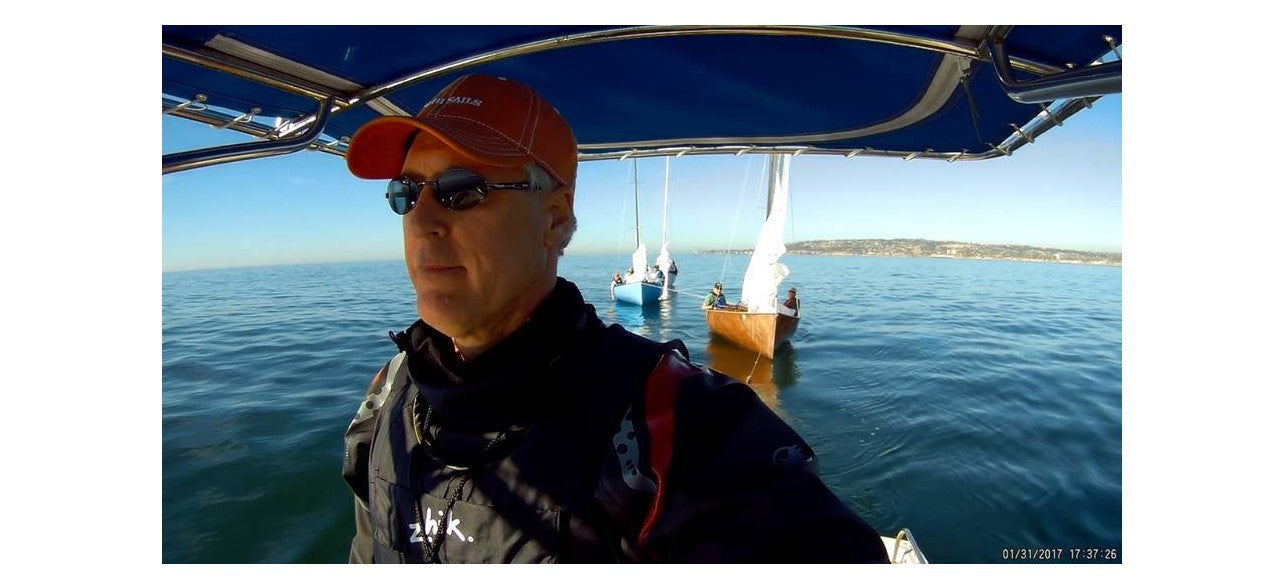
WHO WE ARE: DAN FIEN
WHO WE ARE: DAN FIEN
Get To Know Your Local Sales Expert
How long have you been sailing? What classes do you race?
Over the past 50 years, I have sailed with numerous fleets including IC dinghy, Lightning, Laser, Thistle, J/24, Farr 30, Soling and PHRF. My experience has lead me to three One design National titles and a US Sailing Championship of Champions gold medal over the last five years. I also have a Professional Mariners 50-Ton, Near Shore, Masters License, with Sailing and Towing Endorsements from US Coast Guard.
What's your background in the marine industry? What's your favorite aspect of working in the industry?
I have coached beginners and Olympians and enjoys supporting sailors at all experience levels. When consulting I hope to increase racers and casual cruisers enjoyment of sailing by making their experience simple, safe, and successful. Further, as a member of US Sailings Diversity and Inclusion Committee I believe that awareness of and access to, sailing by all socioeconomic groups should be our sports' main priority.
What's your favourite thing about sailing?
I enjoy the competition and camaraderie in this sport but is fascinated by how sailing challenges many fields of science and every engineering discipline. As a professional engineer by training, I view the opportunity to solve problems in our sport as a life long and even infinite endeavor.
READ MORE
READ MORE
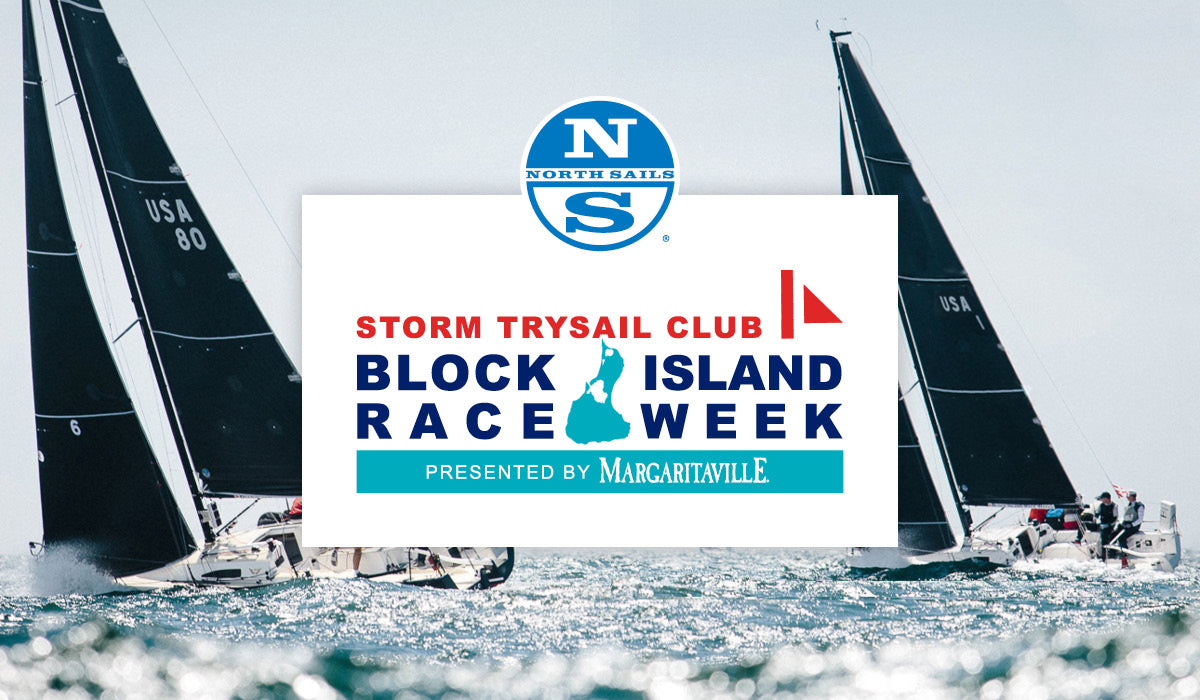
BLOCK ISLAND RACE WEEK 2019
BLOCK ISLAND RACE WEEK 2019
North Sails Returns With Expert Coaching, Weather Forecasts & Pop-up Service Loft
North Sails is excited to continue our support of Block Island Race Week. The race, entering its 28th edition in 2019, is one of the Northeast’s most anticipated and attended regattas. The expansion of racing formats is set to attract a wider variety of boats this year, with the regatta estimating over 150 entrants, ranging from grand-prix teams to family-friendly cruisers.
North Sails has a long history with Block Island Race Week, outfitting and supporting a significant number of boats, including many clients with race victories. In the last edition, North clients took the top podium spots in 11 fleets, including first place J/105, Bruce Stone's Good Trade and first place in ORC, Lincoln Mossop's The Cat Came Back. Partnership, Seabiscuit, and Ranger took home 1st, 2nd and 3rd in the PHRF 1 division and the One Design fleets saw great success, with north clients claiming 1st – 3rd in the J/109 Corinthian fleet.
Expert Coaching
The PHRF and the performance cruising fleets will have the chance to take advantage of North Sails expertise on the water. Our coaches will be out to provide guidance, tips, and post racing debriefs, focusing on boat handling and sail trim. Find out more and register for our Three Free program.
Daily Weather Forecasts
Partnering with Gowrie Group, North Sails will be providing complimentary daily weather forecasts, available to all entrants. Register to receive daily weather briefings sent directly to your inbox each morning.
Regatta Repair
Our Certified Service team will be returning this year with our pop up sail loft, located in the Block Island Maritime Institute, adjacent to Payne’s Dock, from June 22nd – 29th. Open to all boats for overnight sail repair, the North Sails service loft offers every crew the peace of mind when it comes to sail care matched with expert service.
Storm TRYathalon 5K
Switch your sailing shoes for running shoes on the lay day. Part of the Storm TRYathalon, North Sails is hosting the first annual 5K at 8:30am on the designated lay day. No excuses not to take part in this short morning jog OR sprint. Starting at the North Sails pop-up service loft in the Block Island Maritime Institute, the race loops 5K and ends at the regatta tent at the Narragansett Inn. For those with a competitive streak, the winners will be greeted with North gear awards. Register fast as the first 100 entrants will receive a North Sails hat.
READ MORE
READ MORE
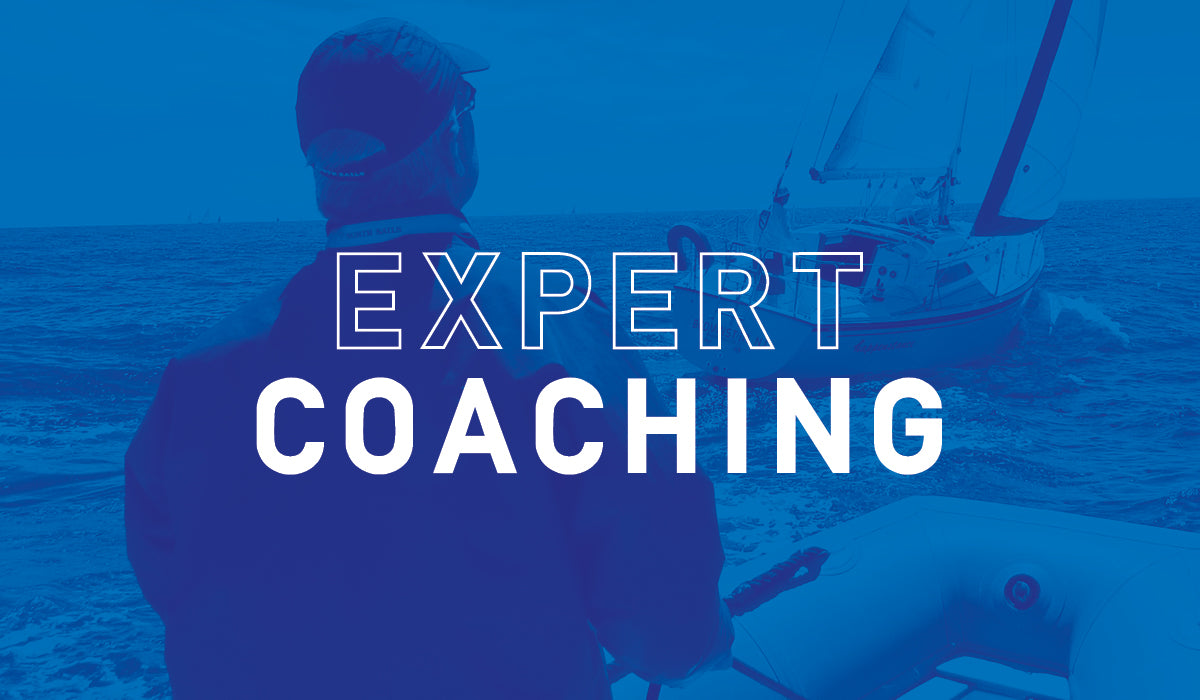
BIRW EXPERT COACHING
GO BEYOND AT BLOCK ISLAND RACE WEEK
Expert Analysis With Winning In Mind
North's sailing and technical experts will be on-hand to provide free expert analysis, race commentary, and coaching at Block Island Race Week, June 23-28. Crews in the Performance Cruising fleets will be able to take advantage of North's live race commentary and our Three Free program, specifically designed to help improve boat handling and sail trim.
Those who register for the Three Free complimentary coaching will receive photographic analysis on at least three angles of boat handling and sail trim taken during racing. Crews can then follow this with an in-person consult with the North Sails experts on the morning of the next race day.
Combined with our daily weather forecasts, delivered to you in partnership with Gowrie, our North experts can walk you through the race day on what to expect weather wise and can help you improve your boat and sail performance for the next race.
READ MORE
READ MORE

BIRW WEATHER SIGN UP FORM
DAILY WEATHER FORECASTS
Powered By North Sails & Gowrie Group For Block Island Race Week
READ MORE
READ MORE
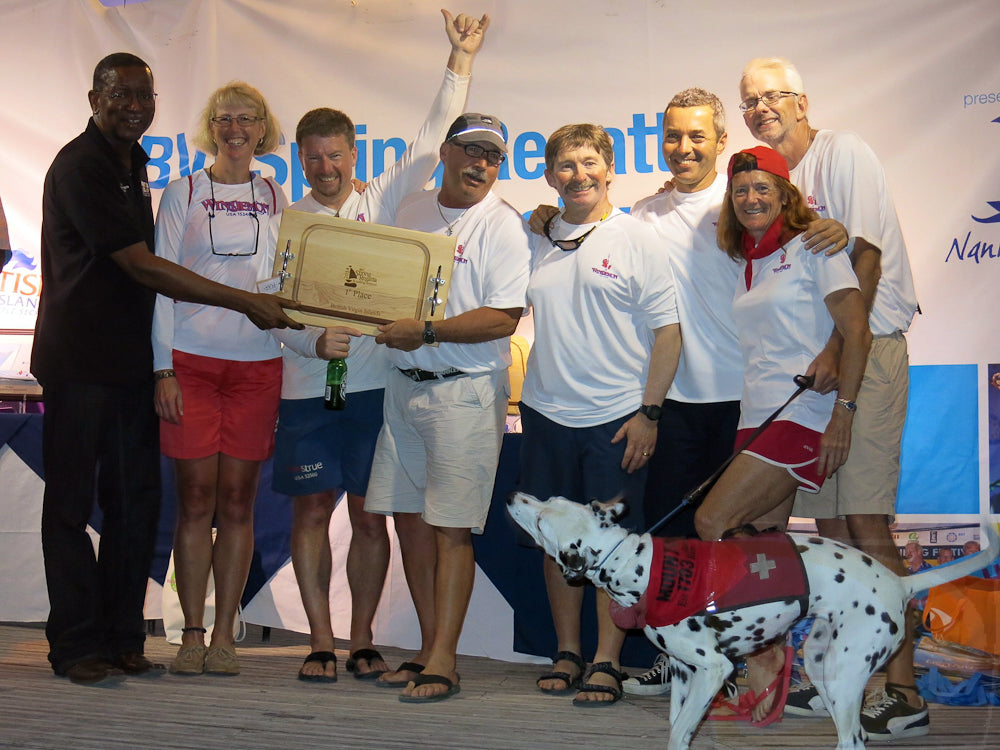
WHO WE ARE: PERRY LEWIS
WHO WE ARE: PERRY LEWIS
Get To Know Your Local Sales Expert
What got you into sailing?
My dad is a nuclear physicist who also loved fooling around in boats, and designed & built his 1st 33-footer. When I was six years old, he bought a 1947 wooden S&S 40. My family vacations all through grade school and into high school were to jump in and take off for several weeks. Most afternoons after we anchored, I’d sail the Dyer Dink around the harbor. I got my first taste of racing when I was in college.
What boats/classes do you sail?
I have been very lucky to be associated with great teams in grand prix classes like the 1D 48s, Mumm 30 & 36 and Farr 40s – where the talent levels & learning opportunities were highest.
What got you into the marine industry?
I graduated from University of Chicago with a degree in mathematics and with no idea what I was going to do with it. Within two weeks-by accident actually- I stumbled into a job of “captain” (boat boy) for Don Wildman’s converted Americas Cup 12m Heritage. For the next three years, one race boat job led to the next.
How long have you been working in the industry?
Most of the boats I worked with are clients of North Sails, including Heritage, who the famous America's Cup veteran John Marshall came to take care of. On the last, 3/4-tonner Chocolate Chips, Gerry Gavin joined us from the Pewaukee, Wisconsin loft for the 1978 Worlds - and afterwards asked if I had thought about sailmaking. I gave it a try at the ripe age of 25 and never left!
READ MORE
READ MORE
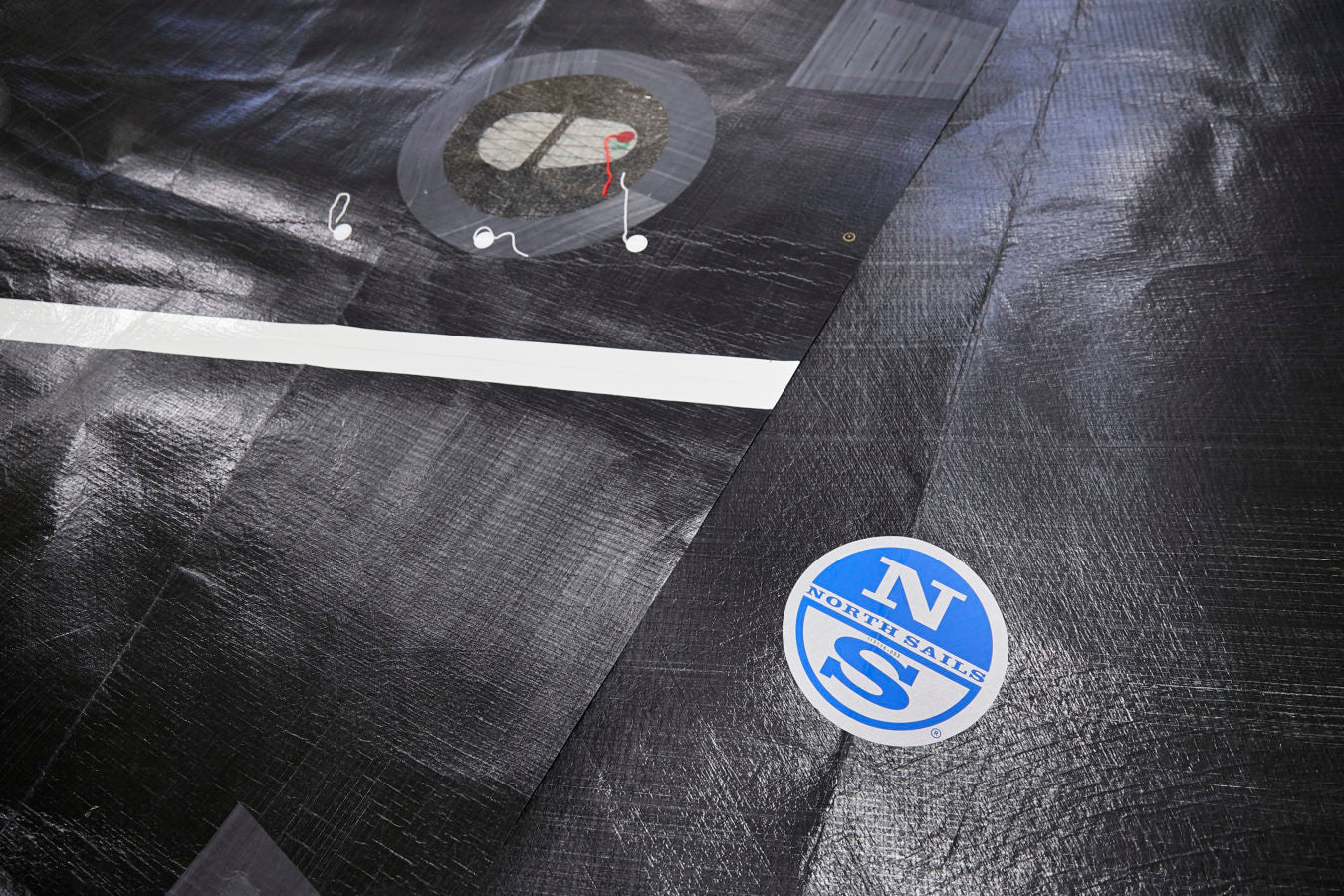
WHY SPREADER PATCHES ARE YOUR FRIEND
WHY SPREADER PATCHES ARE YOUR FRIEND
Advice On Avoiding Chafe and Protecting Your Sails
© Mark Dobson
You don’t need to be a sailor to know – chafe is not a friend. While this holds true in other places as well, it can be detrimental to your sails. It doesn’t take very long for a chafe point to become a more serious problem, especially if you’re out sailing in good breeze. Spreader and stanchion patches protect your expensive investment at a very low cost, and prevent early wear and tear on the sail.
The only time your sails should be flown without chafe patches is when you are measuring where to install them, with the exception of non-overlapping jibs. Ideally, hoist your sail in a place where there is not a lot of wind. On your genoa, mark the sail where it meets the stanchions and mark any spreaders that would come into contact during a tack. Your North certified service expert can professionally install rectangular patches in these areas. For your mainsail, mark where it meets the tip of the spreader. Here we can install a circular patch to prevent chafe during broad reaching and running when your main is pressing against the spreaders. For in-mast furling sails, a rectangular patch may be installed, similar to the spreader patch we use for an overlapping genoa.
Did you know?
Spreader and stanchion patches are included with your new sail purchase. If we’ve measured your old sail, they will be installed before delivery and you will be ready to sail as soon as your sail arrives.
Learn more about chafe with traditional fabrics.
READ MORE
READ MORE
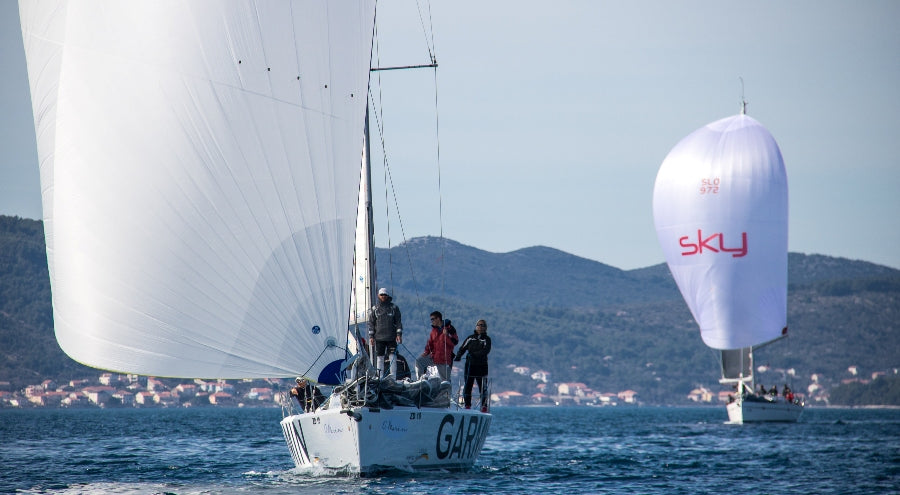
OTVORENA JE ORC SEZONA
OTVORENA JE ORC SEZONA
foto: Hrvoje Duvančić – www.regate.com.hr
Broj od pet ORC posada koje smo naviknuli uvijek vidjeti na ovim regatama od ove zime se smanjio na četiri, jer se jedrilica Yellowpad prodala i uskoro odlazi za Grčku.
Srećom, čast CRO ORC D-Marin Cupa spasila posada jedrilice Sky.
Kao i uvijek, u najavi je bilo desetak jedrilica, ali s približavanjem dana zakaznog za susret u Sukošanu krenuli su stizati i otkazi. To nije obeshrabrilo ekipe s Gringa, Mareusa, Orce, X-Citea i Sky da naprave jedan vrlo kvalitetan trening po stvarno raznim uvjetima na moru.
U subotu, prvog dana regate puhao je lagani maestral, do oko 10-12 čvorova. Po njemu su se odjedrila tri plova, a kako je vjetar bio vrlo stabilan nije bilo potrebe za mijenjanjem regatnog polja, pa je Regatni odbor najviše posla imao oko spredstarnih procedura i kalkulacije rezultata. Uglavnom, svi su ugodno proveli jedan od prvih pravih predproljetnih dana.
foto: Hrvoje Duvančić – www.regate.com.hr
Slična situacija po pitanju stabilnosti vjetra je bila i u nedjelju. Razlika je bila u smjeru i u snazi. Tada je puhalo jugo. Iz prva umjereno, da bi u drugom plovu preraslo u jako s udarima preko 22-23 čvora s umjerenim valovima.
Suma sumarum, izvrsna lepeza različitih uvjeta za korištenje skoro cijelog seta raspoloživih jedara, a kad se jedra spominju treba istaknuti potez ekipe Gringa 2 koji su se u ovoj sezoni odlučili na drastičnu promjenu u jedrenju. Oni su se ove sezone odlučili na upotrebu genakera umjesto spinakera. Naravno, nije im ovo prvi put da jedre s ovim jedrom, ali u ORC konkurenciji ipak jest. Da cijela priča bude zanimljivija pobrinuo se njihov službeni jedrar, North Sails, koji je uspio isporučiti novi genaker do starta regate. Za razliku od onog kojeg su do sada koristili na Open regatama ovaj je oko 20m2 veći! Inače je Open logika da se podigne što više "kvadrata", a da se u ORC-u pazi na brojeve koje će izbaciti računalo, te se ne pretjeruje s površinama jedrilja, ali ekipa Gringa očekuje da će im brzina po laganim vjetrovima biti dovoljno povećana da se na taj način poništi teret nepovoljnijih koeficijenata u kalkulaciji.
Po laganom subotnjem maestralu se pokazalo da ovo novo jedro ima potencijala. Do tada je X-Cite bio praktički neuhvatljiv i po ovim uvjetima, ali Gringo ga je u krmu uspješno hvatao, a u drugom plovu je čak i realno ušao prvi u cilj. Istina, nakon korekcije X-Cite je i dalje bio ispred Gringa, ali sad je ta prednost s prosječnih više od dvije i pol korigirane minute u sezoni 2018. sad smanjena na oko minutu.
Subota je posebno dobar dan bila i ekipi Mareusa II. Oni su korigirano pobijedili u prva dva plova, dok su u trećem završili na drugom mjestu. Taj plov se posada X-Citea se trgnula i upala u pobjednički niz koji je trajao i po jugu u nedjelju.
Za razliku od ove tri posade koje su se izmjenjivale na vrhu, ekipe na Orci i Skyu su se uglavnom nalazili u donjem dijelu tablice.
foto: Hrvoje Duvančić – www.regate.com.hr
Orca je najveći hendikep imala u tome što je za razliku od ostalih četrdesetica jedrila s genovom, dok su oni koristili flokove. U sklopu priprema za Svjetsko prvenstvo u Šibeniku Orca najavljuje par novih jedara tako da bi i oni trebali još ubrzati. A Sky nije imao sreće u subotu jer je riječ o jedrilici koja svoj forte ima po jačim vjetrovima. Ta činjenica se pokazala točnom kako je vjetar jačao. Nakon tri 5. mjesta u prva tri plova krenuli su uzlaznom putanjom već u četvrtom plovu. Njega su završili jednu stepenicu više, a u petom plovu su dojedrili do 3. mjesta.
Vikend na Zadarskoj rivijeri nije prošao samo na moru. Udruga ORC jedriličara je u sklopu subotnjeg druženja koje je organizirano u prostorijama kluba organizatora, JK Uskok, organizirala predavanje koje je vodio glavni ORC premjerač, a ujedno i glavni premjerač u Hrvatskoj, Zoran Grubiša. Uz objašnjavanje elemenata koji su mnogima bili u zoni apstrakcije odgovarao je i na mnoga konkretna pitanja koja su pripremili kormilari i vlasnici koji su se okupili u velikom broju.
foto: Hrvoje Duvančić – www.regate.com.hr
Treba li napomenuti da je 80% flote jedrilo s North Sails jedrima?
READ MORE
READ MORE
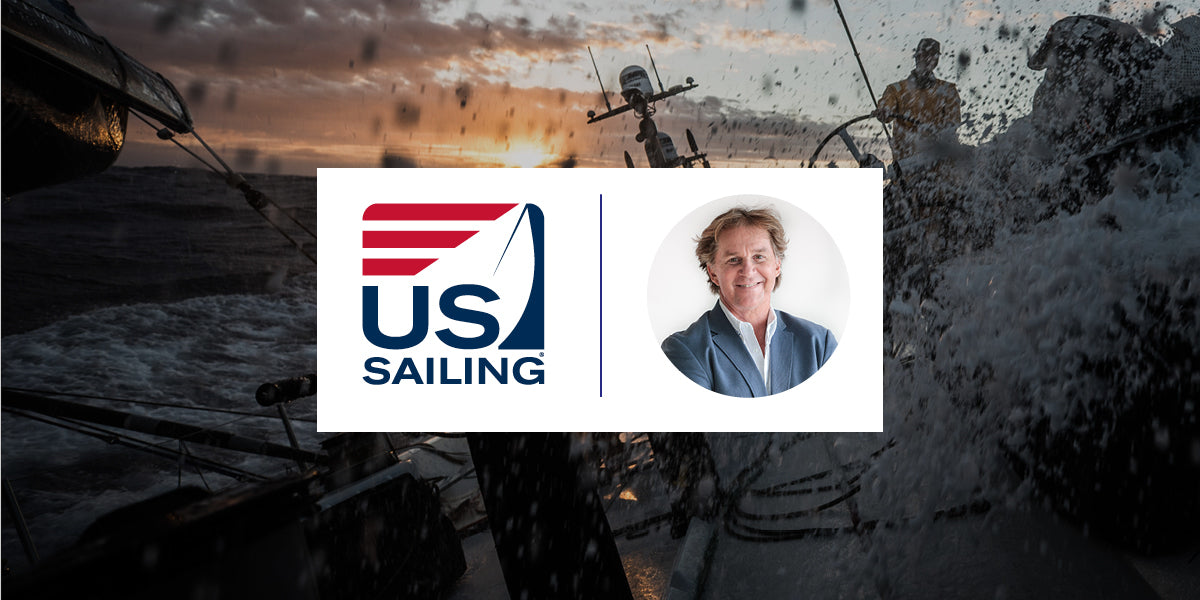
ANNAPOLIS SAFETY AT SEA SEMINAR
KEN READ HEADLINES SAFETY AT SEA COURSE
March 30 | Annapolis, MD
"The sea is relentless, you never know when it's going to come out and bite you. You simply have to be prepared. The more prepared the better."
- Ken Read, North Sails President
Let's face it, with safety comes confidence. Keeping safe is paramount on a yacht, so whether you're in a dinghy racing on Wednesday nights, or taking on the 2225 nautical mile Transpac, we should all be in the same boat when it comes to ensuring ourselves and our crew are safe.
US Sailing's Safety at Sea Course is designed to prepare you for whatever challenges the sea throws your way. To celebrate the 40th year of curriculum, North Sails President Ken Read will attend the seminar as Keynote Speaker. One of the world's most accomplished sailors, Ken has 200,000 offshore miles under his belt, and his first and foremost goal for any race has always been safety, which has been put to the test numerous times.
Join Ken, Saturday March 30 at the United States Naval Academy where technical experts, premier ocean racers and sail training professionals blend their experience into what has become the most complete and comprehensive safety training course.
Storm sails
Care & maintenance of safety equipment
Damage control & repair
Heavy weather
Seamanship
Overboard prevention & recovery
Hypothermia
Weather forecasting
USCG SAR & communications
March 30 | 7:30am | United States Naval Academy | Alumni Hall
READ MORE
READ MORE
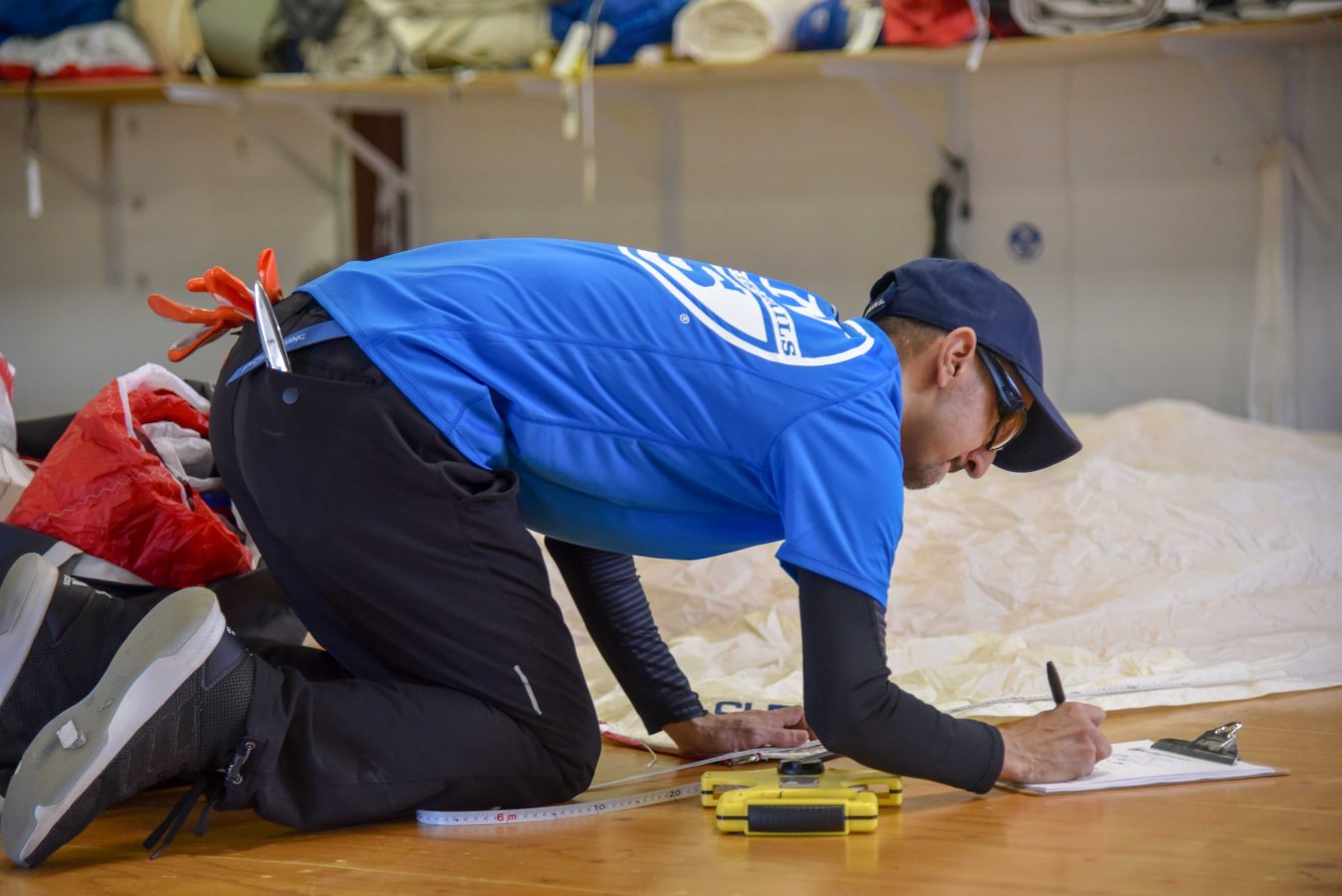
MEASUREMENT & CERTIFICATION EVENT WITH LOOR
GET READY FOR THE SEASON AHEAD
North Sails Toronto Teams Up with LOOR
North Sails Toronto and Lake Ontario Offshore Racing (LOOR) are teaming up to provide racers with a measurement and certification event to help racers prep for the upcoming 2019 season. Join the team for a morning of fun and preparation! No limit on the number of sails you can bring in; our team will help ensure your PHRF and IRC certificates are signed off and you are race-ready.
READ MORE
READ MORE


